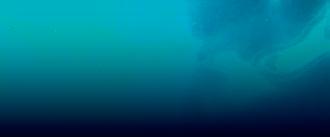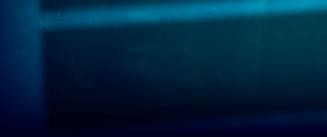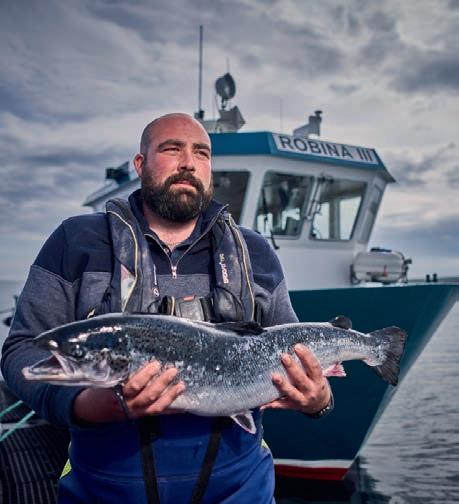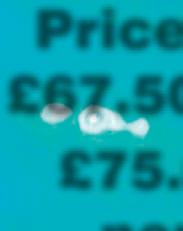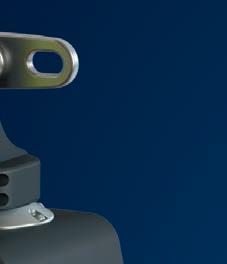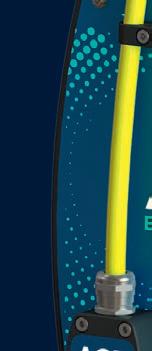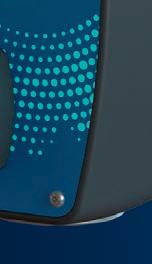F ish F armer


















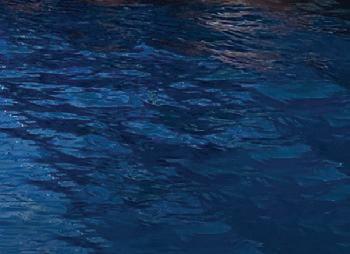
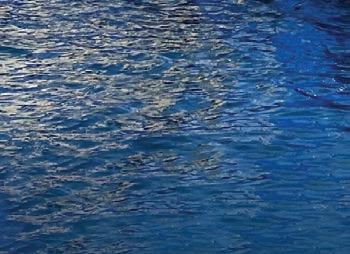



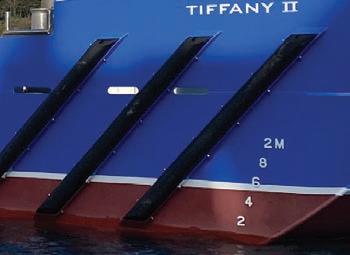
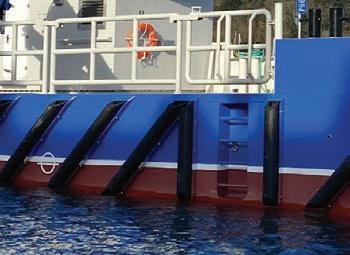
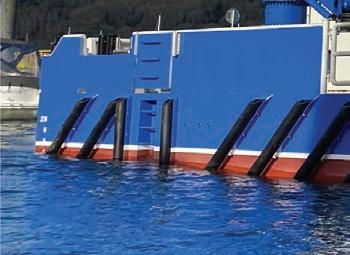
Now available from stock.
The Damen Landing Utility Vessel (LUV) 2208 o ers the aquaculture sector a strong, stable workboat based on the proven credentials of the iconic Damen Multi Cat series. The LUV boasts ample deck space, with a capacity of 70 tonnes, or 2.5 tonnes per m2 She's the only LUV in her class capable of supporting a heavy duty deck craneHS Marine AK 72 series.


Vienna, the capital of land-locked Austria, was the venue for the European Aquaculture Society’s annual conference last month. Holding the conference in central Europe offered a reminder that aquaculture is not just about the marine economy – freshwater fish farming is part of the food system too and it will need to thrive if Europe is to achieve improved food security.
As those attending the conference discovered, traditional pond farming is highly sustainable but climate change and economics are proving problematic for this sector. You can read more about the conference in our report, starting on page 34.
The freshwater theme continues with our feature on trout farming, which finds that these farmers are facing many of the same challenges as the much larger salmon sector.
Meanwhile, as Salmon Scotland’s Tavish Scott writes in his column this month, although this has been another difficult year for salmon farming, the latest survival rates indicate that solutions are being found despite warming seas.
This month, we also focus on seaweed farming, an industry that is already huge in Asia and offers a fascinating potential in Europe and the UK especially.

You can also read a roundup of the latest developments in land-based farming and hatcheries. Investment continues around the world in facilities to grow salmon – and other species – to harvest size without ever placing them in the sea. Technical difficulties and rising costs for a number of these have, however, demonstrated that combining new technology with biology is a risky business.
The October issue of Fish Farmer also features the concept of the circular economy, with a profile of EcoFishCircle – a company that aims to use waste from fish production to help create fish feed – and an article from BlueBio’s Ingeborg Korme on the regulatory barriers in Europe that are holding back the development of a truly circular food system.
Best wishes
Robert OutramMeet the team
Editorial advisory board: Steve Bracken, Hervé Migaud, Jim Treasurer, Chris Mitchell and Jason Cleaversmith
Editor: Robert Outram

Designer: Andrew Balahura


Commercial Manager: Janice Johnston jjohnston@fishfarmermagazine.com

Publisher: Alister Benne�
@fishfarmermagazine
@fishfarmermag
www.fishfarmermagazine.com
Fish Farmer Volume 46, number 10 Contact us
Tel: +44(0)131 551 1000 Fax: +44(0)131 551 7901 Email: editor@fishfarmermagazine.com
Head office: Special Publica�ons, Fe�es Park, 496 Ferry Road, Edinburgh EH5 2DL






Subscriptions
Subscrip�ons address: Fish Farmer magazine subscrip�ons, Warners Group Publica�ons plc, The Mal�ngs, West Street, Bourne, Lincolnshire PE10 9PH Tel: +44(0)177 839 2014
UK subscrip�ons: £75 a year
ROW subscrip�ons: £95 a year including postage all air mail



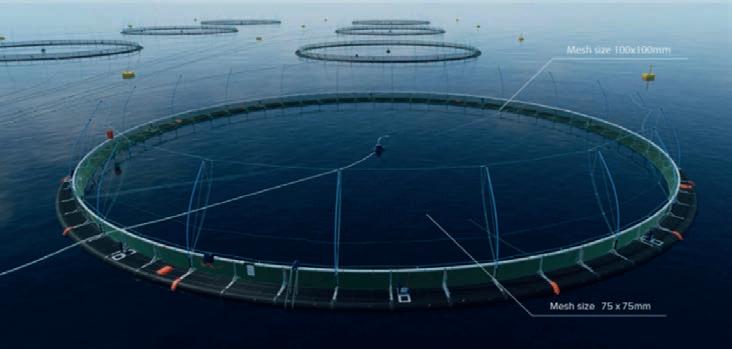
SCOTTISH Sea Farms has been consulting with the local community regarding its plans for a large new salmon farm in Shetland.
The proposed farm at Billy Baa, west of South Whiteness, is part of the company’s plan to consolidate its farm. The strategy will involve closing some smaller facilities but these have not yet been identified.
The new farm is estimated to cost £4m and Scottish Sea Farms will be applying for an indicative maximum biomass of 4,000 tonnes.
The company’s plan comprises nine 160 metre salmon pens and one 120 metre pen, secured by a 125 metre mooring grid and with a surface area of 19,480m2
Each pen would be stocked to RSPCA ssured densities of just 1.5 fish to 98.5% water, with a combined maximum permitted biomass of 4,091 tonnes.
Pens would be equipped with predator defence netting systems



and pole-mounted top nets.
Adjacent to the pens would be a 400 to 500 tonne capacity feed barge. This would house the farm’s cameramonitored feeding system, office and welfare facilities for the team, and a store for fish feed.
Scottish Sea Farms said the barge will have a “boat-like” design to blend into the local seascape. The farm would be supported from
the company’s shore base at South Whiteness.
The proposed farm at Billy Baa is part of a wider strategy of consolidation at Scottish Sea Farms. At the company's Loch Nevis site, for example, 1,280m circumference pens are being replaced by five 1 m pens, reducing the overall number of units from 36 to just 10, while maintaining the same overall biomass.
or marketing activities – was 1,508, up slightly by 13. Production tonnage of rainbow trout increased by 7% in 2022 to a national record of 8,757 tonnes. Brown and sea trout production remained steady at 23 tonnes. The Scottish Government’s Cabinet Secretary for Rural Affairs, Land Reform and Islands Mairi Gougeon welcomed the report, saying: “Scotland’s aquaculture sector is a significant contributor to our economy, generating approximately £885m GVA [gross value added] and an estimated 11,700 jobs while producing healthy and nutritious products. It is good to see a small uplift in direct employment in the sector and to see innovations and new strategies being deployed by the sector having a positive impact.


THE latest figures from the Scottish Government confirm what the major salmon producers’ reports have already made clear – the biological issues experienced last year resulted in a significant fall in Scotland’s salmon production.

The Scottish Fish Farm Production Survey 2022 shows that production of Atlantic salmon in Scotland was 169,194 tonnes, representing an 18% decline year-on-year. Mortalities and premature harvests hit production numbers in 2022, particularly related to an increase in the population of micro-jellyfish (hydrozoans), which led to gill health issues and other challenges for salmon at sea.
Despite this, the total number of smolts produced in 2022 increased by 3.9 million (8%) to 55.1 million. Employment in salmon production – excluding processing
“For example, we’ve seen a reduction on the reliance of imported salmon ova and an increase in production and hatches in Scotland. This strengthens our domestic supply chain and improves resilience. We also know that some companies are working to change their production strategies, for example by increasing the average size of fish put to sea and reducing the marine phase of production.”
She added: “These figures also show that farmers are proactively responding to environmental and biological challenges and pressures, for example by making the responsible decision where necessary to harvest smaller fish to support health and welfare, which has resulted in decreased production figures.”


SCOTLAND’S salmon farmers have finally had some good news to report on survival rates. Preliminary data for September 2023 indicates that survival was above 96.5%, up on the 95.3% recorded in September 2022.
The improvement comes after several mitigation measures were adopted by farmers to further boost animal welfare amid the climate change challenge, including oxygenation of the water, less time spent in the sea, improved monitoring and new feeding strategies. It is also despite the warmer sea temperatures experienced around Scotland this year.
Even given the the year-on-year improvement for September, however, producers have reported reduced harvests for 2022 and the first half of 2023 due to “biological issues”.
Dr Iain Berrill, Head of Technical at Salmon Scotland, said: “September is usually one of the most challenging months for survival, but interim figures suggest that monthly survival in September is expected to be above 96.5%, compared to 95.3% in the same month last year.

“There is no question that 2023 has been a challenging year, but the ongoing hard work by our farmers has provided good conditions for their salmon, despite record-breaking seawater temperatures here in the UK and globally.
“However, while there is always a level of fallen stock in any farming operation, the numbers this year are not where any farmer would want them to be. It is utterly devastating to the farmers caring for those animals when any fish are lost.”
Last year, Salmon Scotland warned of a significant increase in microscopic jellyfish blooms, which had affected the survival of farm-raised fish.
But while the tiny translucent jellyfish, measuring as small as 2mm, continue to pose challenges for farmers who care for their livestock all year round, millions of salmon have been moved out of harm’s way in 2023 thanks to improved monitoring and mitigation measures such as aeration of the water, feeding strategies and putting larger fish to sea.
September survival rates typically drop to their lowest monthly level because this is when seawater temperatures peak – and this year has seen record temperatures. While these can actually encourage growth and allow harvest weight to be reached more quickly, record temperatures also contribute to an increase in naturally occurring organisms, which can reduce oxygen levels and compromise the health of the salmon.
Dr Berrill said: “Our ability to address the environmental challenges facing our fish while they spend up to two years in the sea has improved, but there is always more we can do to further improve survival.
“But the sector is resilient in the face of climate change and we have a track record of being proactive and constantly adapting to environmental challenges.”
MOWI’S fundraising “Salmon Wagon” has raised more than £14,000 for local charities in Scotland over the past three years.
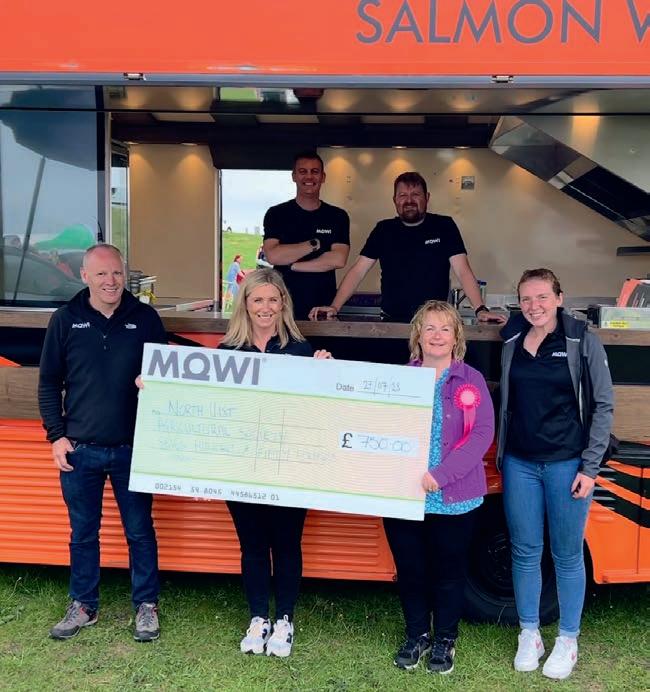
Across the country this year, the Salmon Wagon served up delicious barbequed salmon dishes at events in Achiltibuie, Appin, Benbecula, Isle of Harris, Isle of Skye, Kilchoan, Kyle of Lochalsh, Newtonmore, North Uist and Rosyth. Arriving at events fully stocked and staffed by Mowi, 100% of proceeds from the sa e of food enefitted local causes.
In total, since its launch three years ago, the distinctive food truck has raised £14,258 for local causes, serving up over 3,000 salmon dishes at 26 events.
Jayne MacKay, Community ngagement fficer at Mowi Scotland, said: “In its second summer on the road, we are delighted that the Salmon Wagon has raised a significant amount for many worthy causes. Having attended the events, which
ranged from village galas and agricultural shows, to Highland games and festivals, we are lucky enough to have met first hand the charities and communities that will enefit from the funds raised “It was a privilege to be able to spend time at these important social occasions.

“Supporting the local groups that host them is an important element of Mowi’s commitment to helping local communities thrive. We can’t wait to learn more about some of the fantastic events scheduled for next summer as we seek applications for and ma e the difficu t decision of which ones to support.”
Mowi Scotland is now inviting communities and local organisations that would like the fundraising Salmon Wagon to attend their event in 2024 to apply online.
More information on the Salmon Wagon and application forms are available at mowisalmonwagon.co.uk
STAFF at Scottish Sea Farms (SSF) helped their colleague Arnaud Louis to celebrate 30 years with the company. Having first started out in processing back in 1993, he moved to fish husbandry, learning the ropes at the SSF farms around Loch Linnhe in Argyll before
settling down at Dunstaffnage, where he has been working for 15 years. Louis received his long service award and gift voucher from former Dunstaffnage Farm Manager David (below left) and current Dunstaffnage Farm Manager George (below right).
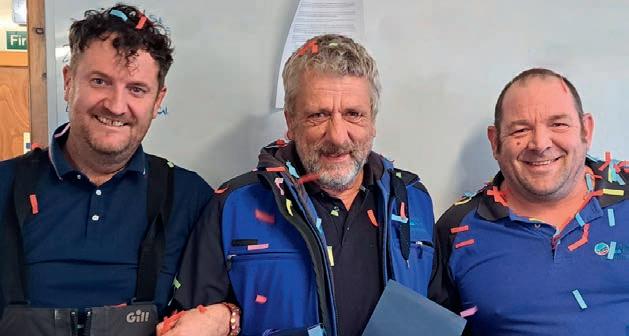
SUPPLIERS to the aquaculture sector were among the winners at the Highland Business Awards, held in Inverness on Friday 29 September.
Jacques Huysamer of marine engineering and support business Gael Force Group was named as Young Employee of the Year, while Alasdair Ferguson, Group Managing Director of Ferguson Transport & Shipping, was the winner of the Business Leader of the Year award.
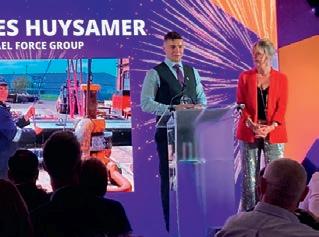
Mowi Scotland was shortlisted in the Global Growth category and renewable energy specialist Ri Cruden was named as the overall Business of the Year.
Gael Force’s Huysamer has been involved in the nextgeneration design of the Seasight aquaculture camera double winch and he has also partnered with the Technical Development Manager to oversee the destructive testing of the new SeaQureLink Ultra mooring ring for a more
secure offshore fish farming cable installation inside the company’s sea farm pens.
Commenting on the win, Jacques Huysamer said:
“Hitting my first-year anniversary at Gael Force Group on the same week as the Highland Business Awards has been capped off by winning the award. I am grateful for all the personal development opportunities that the technical environment at Gael Force has given me. Being shortlisted for the award in the first instance was as much a reflection on the experienced team around me, so it is a proud moment for us all.”
SALMON producer Mowi is rolling out a new prime-time TV advertising campaign starting this month. Dedicated to generating more desire for salmon and supporting Mowi stockists, the “Lingo” campaign will further raise awareness of the Mowi brand and ways to enjoy it. With prime-time spots across


many channels including ITV, Channel 4, Channel 5 and Sky, the national campaign follows the brand’s sponsorship of the reality cooking show Gordon Ramsay’s Next Level Chef at the beginning of 2023. The TV campaign will be complemented with video on-demand advertising on ITVX, All4 and Sky.

BAKKAFROST Scotland has won the award for Excellence in International Business at the Scottish Council for Development and Industry (SCDI) Highlands and Islands Awards.The award

SALMON farming veteran Gilpin Bradley is retiring after a decades-long career in Scottish aquaculture.
Bradley was Managing Director of Wester Ross Salmon – the company his father Robin co-founded in 1977 – for 33 years. After selling the business to Mowi last year, he continued in the role during the transition to new ownership and also became Business Development Director, Farming Scotland with Mowi.

celebrates businesses working in the Highlands and Islands that demonstrate outstanding achievements in the global marketplace.
Bakkafrost Scotland’s Managing Director Ian Laister said: “We are passionate about our provenance and bringing the finest quality Scottish salmon to overseas markets. People across the globe enjoy our finest quality, sustainably produced Scottish salmon and winning this award recognises our commitment to quality, innovation and export growth.”
In retirement, Bradley “will remain available to Mowi and the team at Wester Ross”, a company statement said.
Bradley, who holds a business degree from Robert Gordon University, Aberdeen, is also a former chairman of the Scottish Salmon Producers’ Organisation (now Salmon Scotland) and founder of the Wester Ross Salmon Education Trust. He was named as 2022 Ambassador of the Year at the Highlands and Islands Food & Drink Awards, having already won the same award in 2013.
Ben Hadfield, COO at Mowi Scotland, said: “Gilpin is such a respected and admired leader, with many farmers having learned their trade from Gilpin directly. His experience spans every part of the business’ value chain and is a key reason for the growth and success of the Wester Ross Salmon brand. He is a charming artisan, which is supported by the grit, resilience and know-how needed to meet all the challenges of farming salmon in Wester Ross for over three decades. I wish Gilpin the best for his well-deserved retirement.”




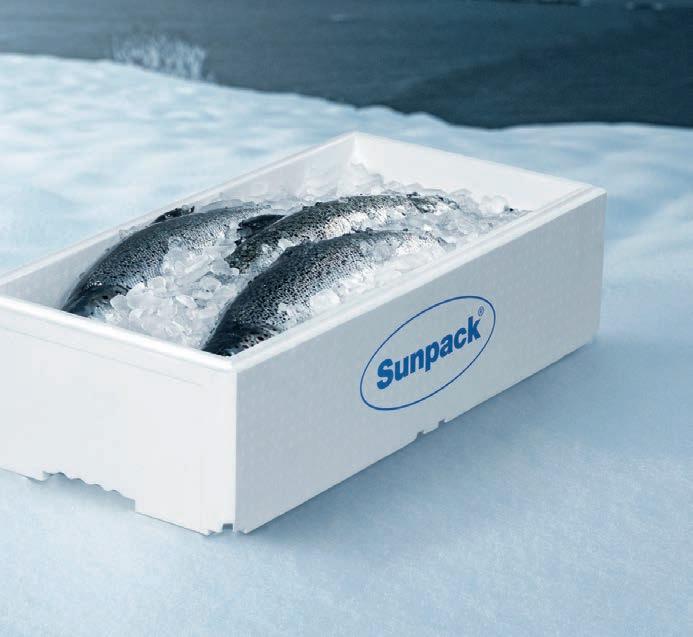
INVERLUSSA Marine Services has taken delivery of Charlie Knight, an 18.5m by 12m CoastCat service catamaran, built by Salthammer shipyard in Norway.
Charlie Knight is a state-of-the-art DP0 hybrid diesel-electric service vessel, fully classed to DNV (the world’s leading maritime c assification ody with a strong focus on lowering emissions and increasing crew safety, especially when working with increasingly heavier mooring e ui ment he esse has een fitted out with more powerful cranes and full SHM deck equipment, including deck winches with incorporated load cells.
As with all Inverlussa-built vessels, crew comfort is a priority and so Charlie Knight has been built with four en-suite cabins along with a large messroom and separate galley to improve living conditions onboard.
The new vessel also complies with low emissions Notation from DNV, achieved
with Tier 3 engines in addition to a hybrid battery pack. Charlie Knight is the fourth hybrid vessel built by Inverlussa, showing the commitment of the company and their customers to reducing emissions.
Inverlussa Managing Director Ben Wilson commented: “Charlie Knight is a big step forward in terms of incorporating the latest technology and equipment into a service catamaran for Scotland.We e ie e this wi resu t in a more efficient work vessel, enabling us to achieve more work in the same time, as well as increasing safety onboard.”
The company has also recently taken delivery of Mimmi, renamed John Wilson, and is the third NabCat catamaran in n er ussa s growing fleet of wor oats John Wilson was built in 2019 for Norwegian owner FDA and is based on the versatile NabCat 15 by 10 design, which includes SHM deck equipment similar to Charlie Knight.
The addition of Charlie Knight and John Wilson ta es n er ussa s fleet u to 22 vessels and 130 specialised crew.
The company said: “Inverlussa aims to be a leader in the Scottish aquaculture service vessel market and these recent investments show a commitment to delivering this by providing the best possible service whilst driving down the cost to customers where possible.”

THE inquiry into the death of a Mowi Scotland employee is due to start with a preliminary hearing next month.
The Crown Office and Procurator Fiscal Service (COPFS) has lodged a First Notice to begin the court process for a Fatal Accident Inquiry (FAI) into the death of Clive Hendry.
The preliminary hearing is set for 27 October 2023 at Inverness Sheriff Court.
Hendry, 58, died on 18 February 2020 while transferring from a work boat, the Beinn Na Caillich, to a Sea Cap feed barge at the company’s Ardintoul fish farm.
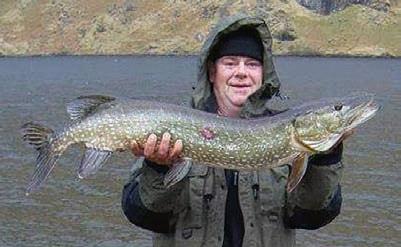
In May this year, Mowi was fined £800,000 over the accident, having not contested the COPFS case. An earlier report by the Marine Accident Investigation Branch had determined that Mowi had failed to make a suitable and sufficient risk assessment or maintain systems of work for the health and safety of employees when transferring from
a vessel to a structure such as Sea Cap. The company also failed to provide employees with the necessary supervision to ensure lifejackets were properly tightened and secured.
Clive Hendry’s partner, Catriona Lockhart, has been pressing for an FAI, which she has said would go further than the court case to establish the root cause of the tragedy and to ensure that the right lessons are learned.
Responding to the latest news, she said: “I still, after three years and six months, don’t know the full facts and details of what really happened that tragic day. I just need to find out why my partner of 28 years is no longer with me and lying in a graveyard. I need to know why my life has been destroyed and what happened to my Clive on that tragic day, and to try and change these unsafe practices that Mowi Scotland were found guilty of so that no other family has to live this hell.”
NORWEGIAN wellboat company Intership has taken delivery of its second new build from Zamakona Yards Bilbao.
The Inter Scotia, a battery-hybrid wellboat, is designed by Salt Ship Design and has a load capacity of 2,500m³.
Inter Scotia shares similarities with its sister vessel, Inter Atlantic. Both have been designed

with a focus on promoting good fish welfare, fish handling and biosecurity.The vessel features a substantial battery package that, when in combination with its heat-recovery system and other measures, significantly reduces fuel consumption and climate emissions.The fish-handling system is delivered by MMC irst Process and the vessel is equipped with a highcapacity freshwater production system capable of producing 5,000m³ of freshwater per day.
Since 2016, Intership has taken the lead in developing freshwater treatment for lice and AGD using a reverse osmosis system. Over the past seven years, the company has gained extensive operational experience in freshwater production and fresh-water treatments. Intership s eet of well boats with reverse osmosis systems provides a low-cost, highly efficient and environmentally friendly method for dealing with sea lice, AGD (amoebic gill disease)
and other gill infection challenges faced by salmon farmers.
Inter Scotia will initially be deployed with a salmon farmer in Scotland. After a few months, the vessel will be temporarily taken out of operation for the installation of the delousing system, LS Caligus .
Combining a freshwater bath and ushing the fish through the LS system is an efficient and gentle way to remove sea lice and gill infections in the same operation, Intership said.
“We are delighted to take delivery of our third vessel equipped with Intership’s industry-leading freshwater production and treatment setup,” said C le eter randal. reshwater treatment is arguably the gentlest method used for treating salmon and it offers both environmental and economic benefits in addition to increased efficiency through facilitating a high-capacity freshwater production system.”
CONTESTANTS in last month’s Craggy Island Triathlon were able to get their bikes across Oban Bay with a little help from salmon producer Scottish Sea Farms.
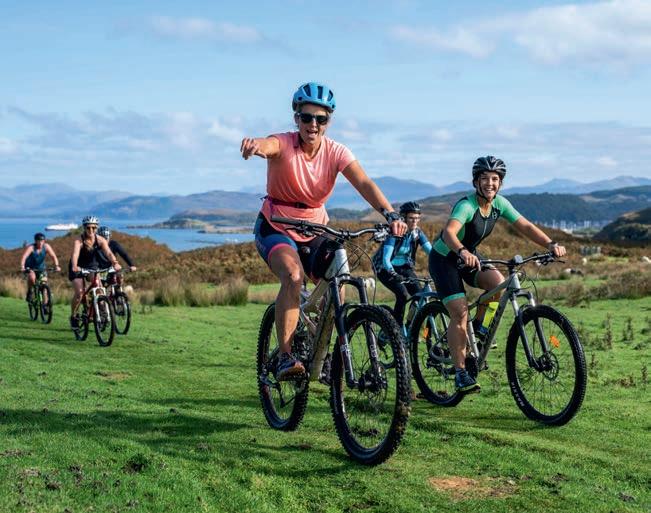
The event involved a 600m swim from the Scottish Sea Farms slipway at the marine on Kerrera Island off Oban on Scotland’s west coast, a 16km bike race around the island and then an 8.5km trail race through the north of the island.
Previously, organisers Durty Events had relied on the scheduled CalMac ferry service to get to and from Kerrera, but this presented some logistical problems, so Scottish Sea Farms made the company’s landing craft Hollie Rose available to transport the racers’ bikes.
Paul McGreal, Founder of organiser Durty Events, said: “Craggy Island Triathlon is a much-loved event. It gets amazing support both from our participants and the community of Kerrera over the whole weekend.
“The logistics of the event are tough for us as organisers. Getting that many people, bikes and equipment to the start line is tricky as everything has to move across from Oban by boat.
“We are hugely grateful to Scottish Sea Farms for their support of Craggy Island Triathlon – they literally have made it possible.”
Scottish Sea Farms Marine Engineering Manager for Mainland Craig Cameron was participating in the race as well as helping to organise assistance with the vessel and slipway.
Cameron said: “Durty Events had the whole thing really well organised, with private boats ferrying competitors and spectators to and from the Isle of Kerrera and Scottish Sea Farms’ Hollie Rose transporting the competitors’ bikes.

“It was impressive to see that many people getting to the island with such ease.
“Using the Scottish Sea Farms’ slip on Kerrera worked well too, as it meant people could be taken directly to the north of the island where the main facilities are, rather than to the south as was the case in previous years’ events.

“All in all, it was a real improvement on previous years in terms of logistics, making it more enjoyable for those who turned out on the day.”
He added: “Signing up for an event like this gives you a goal to train towards and a reason to get and stay active.
“On the day, the weather was kind to us, but the course was still challenging as there were some areas so wet underfoot that I thought my bike might disappear. I could also have done without the jellyfish sting!”


OFFSHORE salmon farming company SalMar Aker Ocean says it has received approval for the location of its Smart Fish Farm in the Norwegian Sea. The decision has come from the Norwegian Directorate of Fisheries. The Smart Fish Farm will be operated by Mariculture AS, a company wholly owned by SalMar Aker Ocean AS, which itself is jointly owned by seafood giant SalMar and marine engineering business Aker.
CEO Roy Reite said: “This is an important step forward in realising the potential of offshore aquaculture.” He added: “The next important milestones for us are the clarifications related to ground rent tax and the regulatory framework for offshore aquaculture.”
The salmon tax could become the sticking point against progress being made on this important next development in salmon farming.
SalMar has been the main pioneer in offshore farming with its Ocean Farm platform, but last week Gustav Witzoe, its Founder and Chairman, said there would be no progress if the tax issue is not clarified. t the moment, the ta is only levied against coastal or fjordbased fish farms.
It was almost two years ago that SalMar and Aker, two of the leading players in their respective field in fish farming and industrial engineering, came together to launch SalMar Aker Ocean. This new operation will operate fish farming in weather-exposed areas and far out to sea, and continues SalMar’s
long-standing investment in this field. SalMar and Aker have big plans for SalMar Aker Ocean. The aim is for the company to produce 150,000 tonnes of salmon annually by the end of 2030 under fantastic conditions and on the salmon’s terms.The company will thereby be one of the world’s largest salmon producers.
The major investment depends, among other things, on the authorities in Norway making arrangements for it, but they say they are not sitting idly by and waiting.
“We have already completed two successful production cycles with the sea cage Ocean Farm 1 and have concrete plans to expand the business with two more facilities,” SalMar Aker Ocean added.
THE Icelandic government has called a temporary halt to issuing new salmon farming permits.
The move comes amid a growing national debate over aquaculture in the wake of various incidents, including escapes.
Food and Fisheries Minister Svandís Svavarsdóttir suggested it was time to draw breath, stating that the country has been chasing an industry that has grown rapidly.

But the chief argument is that salmon farming has been allowed to expand rapidly with comparatively little supervision.
Aquaculture has grown almost sevenfold in the past decade and is on course to almost double by 2030 on existing permits alone.
The sector has brought huge economic benefits, including hundreds of new jobs to remote
areas, particularly in the Westfjords region, which had lost their traditional fishing activities.
Production has risen from around 8,000 tonnes a decade ago to more than 50,000 tonnes last year and industry profits have grown accordingly, hugely boosting the country’s tax take.
Much of the investment, however, is not home-grown, but from Norway, which makes the country vulnerable to important decisions beyond its control.
To outsiders, fish and Iceland are synonymous, but the country is deeply divided over some aspects. The government recently called a temporary halt to whaling, for example, an activity which is centuries old and deep in the DNA of coastal communities.
Recent salmon escape incidents have led to several calls for restrictions on open-pen farming, even in areas where it has brought economic benefits.
The Reykjavik government is due to announce a national aquaculture strategy, probably early next year. It is likely to include a ceiling on how much salmon should be farmed.
NORWEGIAN fish farmer
Norcod has been granted permission to establish a new production location in Nesna municipality in the Nordland region.
It has been allocated a total maximum allowed biomass (MAB) of 3,599 tonnes for a new cod farm.
It is the company’s second location in Nesna and, together with a site at Labukta, it forms a production cluster with a total capacity of 7,200 tonnes.
Norcod CEO Christian Riber said: “Norcod has been very well received by Nesna municipality, which we highly appreciate and we look forward to continuing our excellent cooperation. We will keep on working together successfully in the future.
“We consider this second site in Nesna also to be perfectly suited for cod farming
with good water depth, water temperature and currents. I am confident our fish will thrive here.”
The local mayor Hanne Davidsen said: “Nesna municipality is very happy that Norcod has received approval for a new location for cod farming in Nesna.
“Norcod is well established in the municipality and contributes to activity and jobs, which are very important to us.”
Riber said: “For the industry’s leading player, good community relations are integral to Norcod’s strong commitment to responsible farming of
premium product. Our ambition is to contribute not only to the industrial base of the coastal municipalities in which we are active but also to support employment opportunities and ensure sustainable operations with minimal impact to the environment.”
He said the new site will be equipped with state-of-theart aquaculture technology, driving sustainable production emphasising welfare for both fish and employees.
Riber added: “We have a highly skilled production team with many years of combined experience, so I anticipate this will be a smooth and efficient process.”
Norcod holds a total of six production sites along the Norwegian coastline, encompassing in total 24 licences with MAB of 17,500 tonnes.
TROUBLED Norwegian cod farmer Statt Torsk has been taken over by the larger whitefish group Vesterålen Havbruk AS.
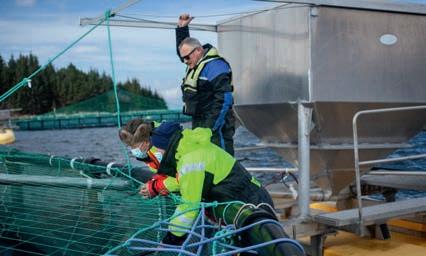
Statt Torsk disclosed last month that it had been hit by high mortalities and production costs during the second quarter. The Q2 losses had almost doubled to NOK 18m (£1.3m).
It then began a strategic review of the business and a few days later revealed it was in merger talks with Vesterålen Havbruk AS, which also farms cod, processes white fish and has some salmon interests.
Statt Torsk issued a Stock Exchange statement saying: “The company is pleased to announce that it has entered into a transaction agreement with Vesterålen Havbruk for a business combination between the company and Vesterålen Havbruk… The merger will be carried out by the company transferring all its business, including all assets, rights and obligations, to a wholly owned subsidiary of Vesterålen Havbruk as the acquiring company in the merger.
The statement added: “Consideration shares in the merger will be issued by Vesterålen Havbruk, based on an equity value of the company at NOK 255m (£19m), implying a value per share of NOK 1.20 and an equity value of Vesterålen Havbruk at NOK 610m (£45.5m).”
The merger will involve a delisting of Statt Torsk’s shares on the Euronext Growth Oslo market.
Vesterålen Havbruk has also made available an interest-free working capital loan of NOK 40m (£3m) to Statt Torsk.
Gustave Brun-Lie, CEO of Statt Torsk ASA, said: “We are extremely pleased with this contemplated transaction. It solves our imminent needs of cash, reflecting the true values of our companies in the current market, but most of all it is a strategic move of consolidation of our young industry. A business combination with Vesterålen Havbruk is our preferred option to optimise shareholder value.”
Brynjar Kværnstuen, CEO of Vesterålen Havbruk AS, added: “Joining forces with Statt Torsk will give the new entity flexibility to deliver cod to market year-round in the future, combining harvests from sites in the north and south [of Norway].
“With decreasing quotas on wild cod in the coming years, the timing for scaling farmed cod has never been better.”
A recently launched investment fund has taken an ISK 10bn (£60m) stake in a salmon business to help provide capital for a new land farm project in Iceland.


The deal will give Haf Investments a 53% stake in Thor Landeldi, which plans to develop a 20,000 tonne facility near Þorlákshöfn on the southern coast of Iceland and close to where other land farms are planned.
Haf Investments was established earlier this year by, among others, Icelandic pensions funds and the fishing company rim, with a S 1m fund to focus on “ocean-related opportunities”.
ut according to reports the fund s investment capacity is even greater if the shareholders coinvestment authorisation is taken into account. y that measure, the investment capacity could go up to m to 35 m 1 4m to m .
Among other investors in the project are Norwegian investors Frank Yri, Chief Commercial fficer of Seaborn, and le Vassbotten, Chairman of the board of Seaborn.
Landeldi has secured a 20.3 hectare site at La abraut, west of orl ksh fn.The location is suitable for fishing as the area is rich in fresh and sea water, which are both needed for the production of salmon on land.
A statement said new capital in the company will be used to finance the first phase of the project, which is the construction of a hatchery.The project is currently in the environmental assessment process and if the plans go according to plan, it is e pected that the first eggs will be received in the hatchery in the autumn of 4.
The leaders of the project are Jónatan Þórðarson, Þórður Þórðarson and Halldór Ragnar slason, all of whom have e tensive e perience. r arson is an aquaculture e pert with more than years of e perience in the operation and development of fish farms and was Head of Aquaculture at Ice Fish Farm for 10 years between 2012 and 2022.
Þórðarson previously worked as a lawyer and manager at Fiskeldi Austfjarða hf. between 2012 and 2023, but Jónatan was among the founders of Fiskeldis Austfjarða hf.
slason is a fisheries scientist with an MSc in aquaculture from Scotland and most recently worked in the fisheries team in the corporate division of Arion bank.
ownership, following a review now being undertaken by the company’s owner, Nordly Holdings. Nordly is “identifying new strategic solutions” with the help of advisers ABG Sundal Collier.
MOWI has agreed a deal with Norwegian company Harbor to try out new technology aimed at protecting farmed salmon against sea lice. The preventive measure, Harbor Fence, is a low-voltage electric barrier that prevents sea lice from entering the salmon cages.

FISH health and aquafeed business
STIM could see a change of
Last month STIM CEO Jim-Roger Nordly stepped down in favour of aquaculture veteran Carl-Erik Arnesen, formerly Managing Director of the feed producer Polarfeed, also owned by Nordly. Nordly is still STIM’s owner – for now, anyway.
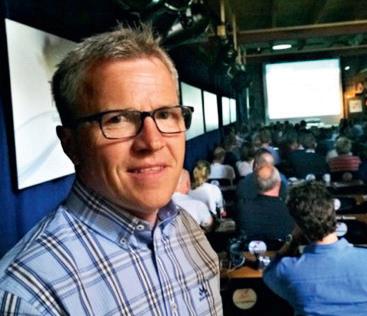
AUSTRIAN meat-free food producer Revo Foods has released a 3D-printed “inspired by salmon” offering for vegans that promises to replicate the taste, nutritional value and mouthfeel of a genuine salmon fillet. The new product, which is based on cultured myco-protein, uses Revo’s patented MassFormer™ technology. The company said: This fillet offers the juicy fibres aiming to recreate the mouthfeel of traditional fish fillets. This gamechanging extrusion technology allows the seamless integration of fats into a fibrous protein matri for the first time, opening the door to a new generation of authentic meat alternatives.”

NORWEGIAN salmon farming business Kvarøy Arctic has appointed une Mikalsen as its Chief ecutive fficer in a move it says will strengthen the company’s bid to grow in the American market.

Formerly the CFO of Kvarøy Fiskeoppdrett AS – Kvarøy Arctic’s parent company – Mikalsen is an experienced operator in the seafood industry. He will be responsible for overseeing the company’s operations, sales and marketing strategies, and strengthening relationships with key stakeholders, including customers, distributors and retailers.
Kvarøy said: “Mikalsen’s leadership skills and strategic vision will play a vital role in driving Kvarøy Arctic’s growth and enhancing its reputation for delivering high-quality salmon products to the US market.”
The trial will involve the deployment of the fence to Mowi’s Rogne site in the Møre and Romsdal region of Norway.
Henrik Trengereid, Group Manager Seawater Production Technology at Mowi, said that Harbor has shown interesting results over the past year and wanted to try out its Fence in a joint R&D project to document the effect on a large scale. The idea is to focus particularly on sites with challenging currents and wave heights.
In addition to the Rogne trial, Mowi also sees an opportunity to test the technology at another location next year.
Harbor and Mowi will collaborate closely through the first R&D project at Rogne, where the technology’s protective effect against salmon lice and impact on fish welfare will be documented. Operational safety and how the technology performs in exposed locations will also be measured.
Harbor has spent several years developing the Harbor Fence and said it has already shown very good results for Nova Sea, with approximately 70% fewer adult lice than other locations in the same area.
This result has led to increased interest in the farming industry and has also been important for Mowi’s decision to test the technology.
The General Manager of Harbor, Christian Bjørnsen, said the contract is important for the development of the company and added that he was very pleased to have signed an R&D contract with such a large player as Mowi.
“This is what we have rigged the company for in recent years,” he said. “We have moved production from Hjelmeland to Dusavik just outside Stavanger, where we are able to increase production capacity significantly.”
Harbor Fence is a research-based and patented solution for combating salmon lice developed by Harbor AS. Findings from the research work have shown that louse larvae lose their ability to attach to salmon after exposure to small electromagnetic fields. Harbor Fence utilises this effect through an enveloping electromagnetic field that is strung up around the cage. The field takes the form of an open fence and neutralises lice larvae on their way into the cage.
Harbor Fence is locally effective and, the company says, does no harm to fish inside the cage. Good flow of water means that lice hatched inside the cage are also rendered harmless when they drift out of a Harbor Fence facility.
Bjørnsen said: “It contributes to reduced contamination of adjacent cages in other locations and in villas. We look forward to a good and professional collaboration with Mowi.”


to this, but the weak Norwegian krone.”
Poland and Denmark, both major salmon processing countries, along with the USA, were once again the largest markets.
THE value of Norway’s salmon exports rose by 13% to NOK 31bn (£2.3bn) during the July to September quarter, the latest figures from the Norwegian Seafood Council show.
The volume of 347,000 tonnes was marginally lower (-1%) on Q3 last year.
While this represents a third quarter record, once again currency exchange rates played a big part, says the council.
Seafood council analyst Paul T Aandahl said: “The value development follows a pattern of growth over a long period of time,and September was the 31st month in a row with an increase in value.
“Unfortunately, it is not the growth in demand that is the most important contribution
China was the market showing the second-largest growth in demand during the quarter, with record quantities of fresh salmon supplied to China from Norway and elsewhere.
The September-only salmon export figure fell 5% in volume to 130,700 tonnes, while the value last month increased by 14% to NOK 11.2bn (£833,000).
Farmed trout exports continue to perform well and hit a new record during Q3, with the volume rising by 15% to 18,900 tonnes. The value was up by 10% to NOK 1.6bn (£121m).
Overall, Norwegian seafood exports, including white fish, pelagics and shellfish, also hit a Q3 record. They totalled NOK 42.1 bn (£2.42bn), a rise of 10% on Q3 last year.
ICELANDIC Salmon, the parent company of Arnarlax, has been isted on ce and s asda irst orth toc ar et for the first time, with a value of around ISK 71bn (almost £420m).
The company, in which the Norwegian salmon giant SalMar has a majority stake, had previously been listed on Norway’s Euronext Growth market.
The opening price per share was ISK 2,260. It rose to ISK 2,500 and then fell again as the day went on, ending at ISK 2,300 (£13.60). It is thought the move will make the company more accessible to Icelandic investors.
CEO Bjørn Hembre said: “We are proud to be on the Nasdaq First North growth market in Iceland.
“Arnarlax’s work is well known to Icelanders, who are known for their love of seafood and its sustainable use.This registration is a very important part of our road to further growth and we are grateful for the interest we have found.”

The move marks an impressive step forward for a business that is 14 years old. It was founded as a relatively small family venture around 2009 to 2010. SalMar bought into the company in 2015 and the first har est fo owed a year ater


FAMILY-owned fish farming com any s a is to carry out a ma or reorganisation of its usiness which it says is necessary to address its growing ta urden
other simi ar si ed sa mon com anies
NORWAY’S salmon farmers could face an extra tax if the number of salmon lice goes too high, a report has suggested.
The proposal has come in a 190-page report from the Aquaculture Committee, set up two years ago to look into various issues around the permit system in the industry. The changes suggested would relax the rules in some areas but introduce new financial penalties.
Linda Nøstbakken, who heads the committee, has now presented her report to the Fisheries Ministry. She says that the rapid growth of the industry has brought a number of challenges around the environment, fish welfare and biosecurity but problems with salmon lice and diseases have limited the growth opportunities.
A new, comprehensive management system for aquaculture must provide stronger incentives for sustainable choices that safeguard biosecurity and the environment, the report states.

Nøstbakken says she has taken “a little more whip and a little more carrot” to some of these challenges.
On the carrot side, the committee has proposed lowering the limit at which salmon companies are required to take measures against lice.
But the stick could mean a tax on lice that is above the acceptable measured limits.
The committee was appointed by the Norwegian government in October 2021 to review the permit system in the aquaculture industry.
Other recommendations proposed by the committee include removing a measure in the traffic light system – which divides coastal zones into red, yellow and green regions –mandating a reduction in production when lice numbers go beyond a certain level.
The committee is also proposing the removal of the yellow category in the traffic light system. This currently allows salmon and trout production to continue at current levels but does not permit increases.
The report is now out for consultation with a deadline of 2 January 2024.
Fisheries Minister Bjørnar Skjæran said the committee had carried out a thorough review of the permit system, adding that he planned to assess the proposals in more detail, taking in input from the consultation. However, he does not envisage major changes to the traffic light system.
he an in o es concentrating the iomass and a food fish o erations into one com any n ear y e tem er the orway- ased s a announced the a ointment of nders Hagestande as its new hief inancia fficer a though the mo e was ro a y in ace efore that news ro e s a has descri ed the an as a “ ro osa for fission and triangu ar merger t said the ur ose is to “ urify s a as a ho ding com any as we as to iso ate commercia food fish ermits in one com any ure arming “ urthermore it is desira e to transfer certain o erating assets and em oyees with associated assets rights and o igations to one com any ua arms artda the announcement added he shareho der set-u wi e the same as efore
s a s second uarter resu ts were disa ointing when com ared to
e enues fe y m m to m m whi e its o erationa more than ha ed down from m m in to m m this time
he com any amed higher feed rices and costs for treating sa mon ice a ong with ower har ests for the re ersa
t a so announced the scra ing of its a ua semi-c osed roof faci ity designed to o en u new sea farming areas and reduce ice c aiming that the sa mon ta made it economica y un ia e
A relatively young Icelandic land salmon farming company has just completed a six billion ISK (£35.5m) share capital increase.
Laxey, which changed its name from Icelandic Land Farmed Salmon last month, is building a new fish farm at Vi lagafjara on Heimaey in the Westfjords region.The proposed farm would have a production capacity of 32,000 tonnes by 2031.
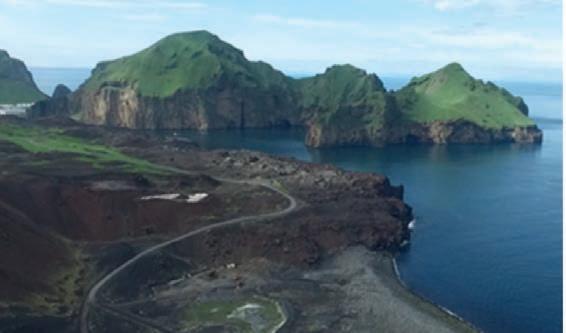
Construction is due to start this ovember, with the first harvest expected within two years.
The project will create at least 100 direct jobs and many more indirect employment
opportunities, said the company.
Lárus Ásgeirsson, Chairman of the board at Laxey, said: “We are extremely happy that this milestone has been reached and the trust that investors show in Laxey.
“We have been working on this project since 2019 and see great opportunities in the production of Icelandic land-farmed salmon in the Vestmanna Islands and sales on international markets.
He added: “In the Vestmannaeys, there are ideal conditions for producing highquality fish products, a lot of knowledge and strong human resources – which is a key
factor in this sector.”
The farm will be built in six equal phases, with the first phase expected to be ready in mid- 4 and the first slaughter to take place in late 2025.
The first phase alone will be operationally sustainable but each additional phase will increase the efficiency of production, with lower investment expenses and operating costs per kilo of salmon produced,” Ásgeirsson said.
Although Iceland is now emerging as one of the world’s leading salmon farming countries, land-based operations are still fairly new to the country.
Laxey says the conditions for salmon farming on land in the Vestmanna Islands are very good: “A continuous water recycling system is used, where about 65% of the sea is reused, while 35% is fresh ground sea pumped up from boreholes in the area.The water temperature is particularly favourable for salmon farming.”



carried out regular sampling. It said it was doing all it could to limit the damage.
The Food Safety Authority has since taken its own samples, which confirmed the company’s suspicions.
PANCREATIC disease (PD) has been confirmed at a salmon research facility and farm in Norway, the country’s Food Safety Authority has said.
The site atYstøya in Nordland,
which holds an estimated 860,000 fish, is operated by the organisation LetSea, which is also a business.


LetSea first disclosed its suspicions last week after it had
Pancreatic disease in Atlantic salmon can reduce weight gain and lead to damage of the heart, pancreas and skeletal muscle.
A statement said: “The Norwegian Food Safety Authority has informed the company that they will be required to empty the facility quickly.
“The Norwegian Food Safety Authority takes the PD detection seriously. It is a highly contagious salmon disease that leads to poor health and welfare for the fish, and to great losses for the industry,” said Geir Arne Ystmark, Director of the Food Safety Authority’s north region. He added: “The location is in an area with other fish farms and in the main area for boat traffic... to limit the spread of infection, we will order a rapid emptying of the facility.”

ICELANDIC salmon company Arctic Fish looks set to face an investigation following the esca e of more than fish into a fjord last month.
The Mowi-owned business apologised for the incident, which took place in Patreksfjörður in the Isafjord region.
Now the food safety and veterinary agency MAST has requested an officia in estigation into what it says may be a violation of the Aquaculture Act.
MAST says on its website that according to Article 22 of the law, the Act concerns
the board members and the managing director of the operating licence holder cou d face with fines or im risonment of up to two years if the charges are proved and whether they have been committed intentionally or not. Local police are carrying their own investigation but have so far declined to comment.
The incident has led to renewed calls y s orts fishing and en ironmenta groups for an end to open-pen aquaculture in Iceland. Local politicians have also expressed their concern.


Arctic Fish has issued a statement saying it will continueto co-operate with MAST and the Icelandic Fisheries Agency.

PUBLIC hearings to consider a licence application by Cooke Aquaculture for two new farm sites in Liverpool Bay, Nova Scotia will take place in February next year, the Nova Scotia Aquaculture Review Board has announced.
The hearing dates have been set as 5 February to 9 February 2024.
Kelly Cove Salmon Ltd (KCS), a Cooke subsidiary, is seeking approval for an existing site boundary amendment at Coffin Island and two new marine finfish aquaculture licenses and leases for the cultivation of Atlantic salmon in Liverpool Bay at Brooklyn and Mersey Point, Nova Scotia.
Kelly Cove welcomed the opportunity to present its case and said: “After years of provincial government oversight and regulatory enhancements by the Department of Fisheries and Aquaculture (DFA) to ensure best aquaculture practices are conducted for sustainability, if successful, the KCS application would enable a modest Nova Scotia production increase to be phased in over a number of years. According to Statistics Canada, in 2021
Atlantic Canadian salmon aquaculture production in Nova Scotia was 8,592 tonnes, while Newfoundland harvested 15,904 tonnes and New Brunswick harvested 27,423 tonnes.
“In our view, there are only a handful of Nova Scotia locations with marine conditions suitable for finfish farming such as Liverpool Bay, so it is reasonable to expand sites where appropriate while adhering to the strict Aquaculture Regulations and Environmental Monitoring Program Framework.”
The statement added: “Nova Scotia has a fitting opportunity to realise increased investment, jobs and local community spending in the highly innovative ocean aquaculture sector that aligns perfectly with the provinces positioning as home to Canada’s Ocean
Supercluster and marine technology hub.”
The company has been operating Atlantic salmon farm sites for 25 years along Nova Scotia’s southern and western shores. In recent years, applications for the renewal of licences for its operations at Coffin Island and two other sites have been approved by the board.
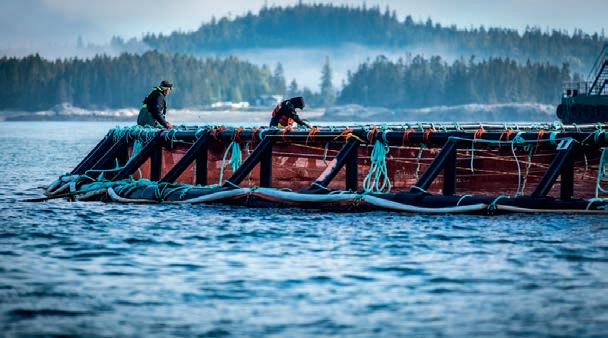
KCS said: “These new Liverpool sites will allow Kelly Cove to improve its operational efficiencies in production and harvesting, and will result in up to 20 new direct jobs.
“The company also plans to install high-tech hybrid electric battery feed barge systems, which slash carbon emissions by reducing diesel generator run time and fuel consumption by up to 60%.
“The larger operation will require more services and materials to be purchased in the community, creating the potential for an aquaculture service hub to be established in the area. With this expansion, other freshwater hatcheries, feed production and trucking will expand accordingly.”

A 40-year-old Californian woman has had all her limbs amputated after eating infected tilapia fish.
Laura Barajas, a mother of a young son, from San Jose was taken to hospital where she was diagnosed with a serious bacterial infection known as Vibrio vulnificus. She bought the fish at a local market. Her condition worsened and doctors decided that her limbs would have to be amputated if her life was to be saved.
She was taken to an intensive care unit and the hospital website said Laura is now healing well.
Around US $60,000 (£49,000) has been raised out of their goal of US $150,000 (£122,000) through a GoFundMe campaign.
The aim is to try and help Barajas and her family during the healing process and meet medical bills and future needs.
Vibrio vulnificus infections are sometimes fatal and amputations often result. The bacteria can be found in seafood and seawater.
The name tilapia actually refers to several species of mostly freshwater fish. They are nutritious but depending on where the fish is sourced from, there may be a higher risk of safety concerns, including bacterial contamination.
It is not yet known if the fish Barajas consumed came from aquaculture sources, but it is an ideal fish for farming because it can tolerate crowded conditions, grows quickly and consumes a cheap vegetarian diet. It is also popular among American consumers, who say it tastes “less fishy”.
The benefits and dangers of tilapia depend largely on differences in farming practices, which vary by location. China is by far the world’s largest producer of tilapia (followed by Vietnam) and farms more than 1.6 million metric tonnes annually, providing the majority of the United States’ tilapia imports.
PROXIMAR Seafood has, through its subsidiary Proximar Ltd, taken full ownership of the entire land-based fish farm facility near Mount Fuji at Oyama, Japan.
The move, carried out through the company s subsidiary Proximar Ltd, marks the end of construction work at the first commercial tlantic salmon land farm facility to be built in Japan.
The handover also follows the completion of inspections by relevant authorities, third parties and Proximar.
ro imar C Joachim ielsen said Constructing the facility according to plan proves our significant progress in Japan. ith the construction now behind us, we can switch all our focus over to operations and production, where we remain on track with our plan of first harvest in 3 4.
He also praised Daiwa House, ro imar s construction partner, adding Daiwa House has been an important partner for Proximar since 1 . e are very pleased with their performance and they have completed the construction works according to schedule, with e cellent quality.
In conjunction with the handover, ro imar Ltd has also completed the second and final drawdown of the . bn Japanese en 55m blue-sustainability loan provided by Mizuho Bank, Shizuoka Bank and Development Bank of Japan. The second drawdown marks the continued strong support shown by the
company s Japanese banks. In the coming months, installation of the remaining recirculating aquaculture system S equipment will continue in the grow-out building, in close cooperation with technology supplier quaMaof.
This enables the first transfer of fish from the hatchery and nursery building in 4 3. ielsen said ith this completion, we will also proceed to review further capacity e pansion in Japan as previously communicated.
“Proximar sees a strong growth potential as
a leading supplier of tlantic salmon for the sian market. e are also motivated by the support for such growth by our Japanese partners and banks.
ro imar Seafood is a orwegian land-based salmon farming company using S technology, with its first facility and production at the foot of Mount Fuji.
The company inserted its first batch of eggs in ctober last year. Through land-based fish farming, using high-quality ground water secured close to uji, the company plans to produce fresh tlantic Salmon.
an accelerated book building process managed by Arctic Securities AS and DNB Markets, a part of DNB Bank ASA as joint book runners after close of markets on 19 September 2023.
“The net proceeds from the private placement will be used to reach an estimated EBITDA break-even for Phase 1 during H1 2024, with a cash buffer.”
Last month, Atlantic Sapphire warned of a lower than expected biomass during the current July to September quarter, which elevated farming temperatures and their impact on water quality.

costs by utilising excess buffer towards finalising investment in the new Phase 1 and 2 chiller plant.”
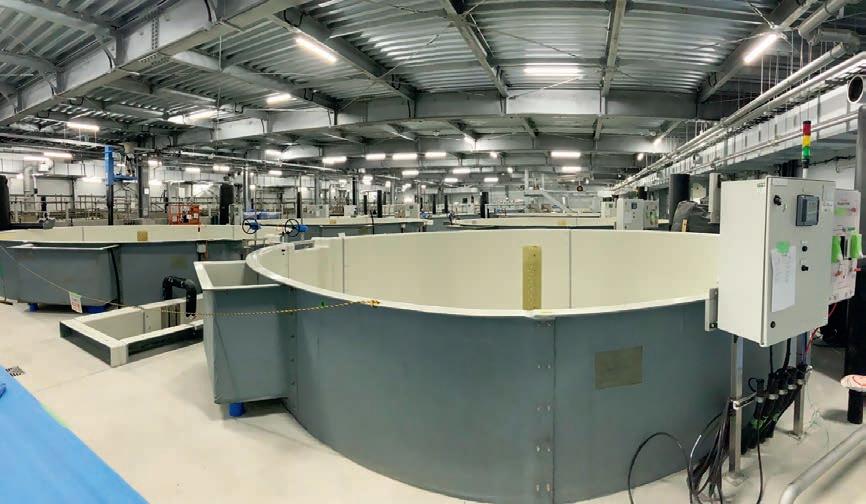
The private placement is divided into two tranches. These will be settled on a delivery versus payment (DVP) basis, facilitated through a pre-funding agreement entered into between the company and the managers.
The first tranche consists of 55,000,000 offer shares while the second tranche will consist of 446,428,571 offer shares.
ATLANTIC Sapphire has successfully raised a further US $65m (NOK 702m/£52.7m) with a new share issue, the Florida land-based salmon farmer has announced.
The move involves the private
placement of 501,428,571 new shares, at a price per new share of NOK 1.40.
The Oslo Stock Market announcement said: “The private placement was carried out on the basis of
The announcement said: “The company will deploy rental chillers estimated to bring water temperatures back to budgeted levels.”
It also said that, depending on satisfactory system performance, it would seek to “…eliminate chiller rental
Atlantic Sapphire completed the first commercial harvest of its pioneering Bluehouse (land-raised) salmon in the US in September 2020.
The company is currently constructing its Phase 2 expansion to bring production up to 25,000 tonnes. The long-term target is 220,000 tonnes.
FEED giant BioMar has named Derek Kohn as its next Managing Director for Chile. Kohn,
currently Commercial and Processing Director of Australis Seafood, brings more than 20 years’ experience in leadership positions within the salmon farming industry for companies such as MultiX and Mowi as well as Australis. He takes up his new post in November. BioMar Chile, which is part of the salmon division of the BioMar Group, currently provides feed solutions to a wide range of salmon farmers in Chile and is one of the largest business units within the BioMar Group.
RISING demand for salmon in south-east Asia is being led by the region’s appetite for sushi, a special seminar organised by the Norwegian Seafood Council at Seafood Expo Asia in Singapore has been told.
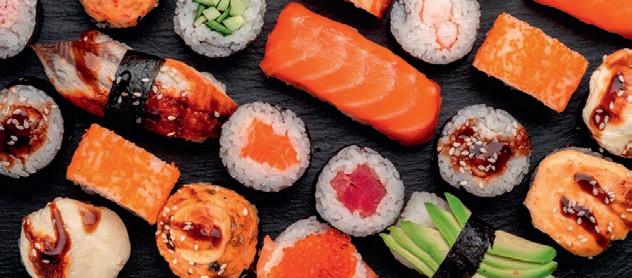
The panel discussed the trends that have given Norwegian seafood a strong foothold in Asia
and what will apply in the future. Participants included Singaporebased investor Frank Arne Næsheim, Lerøy’s Åshild Nakken, the Seafood Council’s Johan Kvalheim, the Seafood Council’s envoy to Japan and South Korea and Malcolm Ong, long-term buyer of Norwegian seafood.

AUSTRALIA has opened the door to Icelandic salmon and salmon products. The authorities in Canberra have said that Iceland’s salmon producers have now met the necessary conditions to allow them to export to the southern hemisphere nation. MAST, Iceland’s food agency, said: “The licence has been a long time coming but the Australian authorities have made an assessment of the disease status of farmed fish salmon fish and subsequently authorised the import of aquaculture products from Iceland to Australia if certain requirements are met.”
ISRAEL’S AquaMaof Aquaculture Technologies has named Eli Amar as the company’s new CEO. He succeeds David Hazut, who now takes up the role of Chairman.


AquaMaof is a pioneer in recirculating aquaculture system (RAS) technology for land-based production of a diverse range of species, from concept to operational fish production facilities and ongoing service and support.
Amar has served as AquaMaof’s VP Strategy and Finance for the last four years. He brings to the company more than 16 years’ experience in corporate development, as well as mergers and acquisitions. Prior to joining AquaMaof, he worked atcrop protection giant Adama gricultural Solutions, playing a key role in multiple high-profile transactions, including the group’s $3.7bn merger with ChemChina – China’s largest chemical manufacturer – and the ramp-up of the company’s business in China.
He also worked in investment banking at Bear Stearns & Co in New York, where he was involved in several key M&A transactions in Wall Street. Amar holds an LLB from the Hebrew University and an MBA from the Wharton Business School at the University of Pennsylvania in Philadelphia.
Hazut said: “This is an exciting moment for AquaMaof and I’m sure that under Eli’s leadership, the company will break through to new records and achievements. As one of the company’s founders and the new Chairman of the board, I have full confidence in li. Together with the great management and employees of AquaMaof, the company will reach remarkable achievements.”
Amar added: “Our current aim is to widen our reach, both in terms of building additional large-scale projects, expanding the breadth of the species with which we work and deepening the quality of our solution by developing additional associated systems.
“With so many AquaMaof facilities already operational worldwide, including one at Proximar in Japan with a 5,000-tonne per annum capacity of Atlantic salmon, we are on the verge of a breakthrough in the scale-up of the company. We’re excited to explore the huge impact and financial potential of our technology.

US aquaculture expert Megan Sorby, formerly Operations Manager at ingfish Maine, is planning a new land-based project. She aims to farm red drum, a popular game fish in the nited States that is now in short supply.



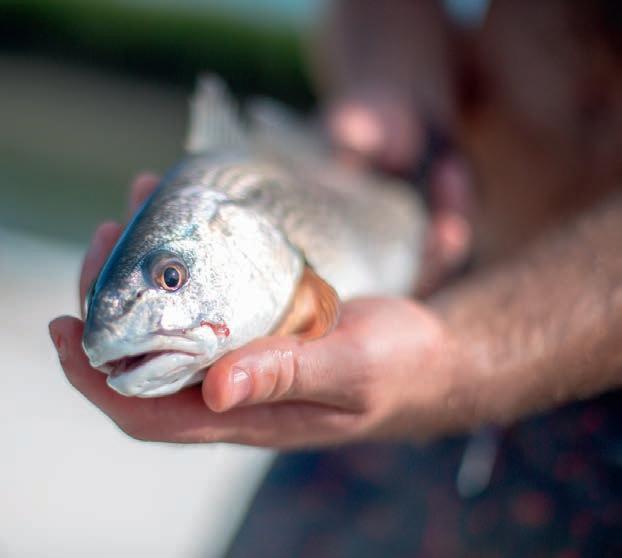
ed drum Sciaenops ocellatus , also known as redfish, channel bass or a variety of other names, is found along the S tlantic coast from Massachusetts to lorida and in the ulf of Me ico.




The species has been protected from commercial harvest since overfishing reduced stocks in the 19 s. Demand for red drum in the S has largely been met by imported farmed fish.


Sorby plans to farm red drum in a location yet to be revealed, using recirculating aquaculture system S technology.





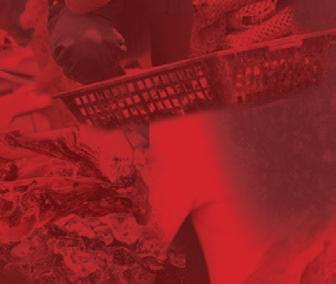



Sorby said This development brings together a well-understood culture process of the species and pairs it with the technological benefits and controls of S. e cannot continue importing this premium product when it is native to our waters.

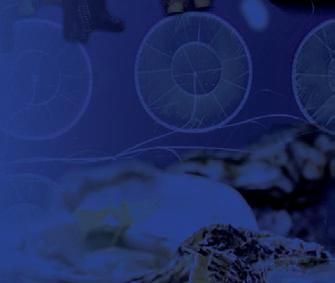
There s deep S investment in the research and development of this species. airing red drum with S technology optimises this species to its fullest potential in a domestic location.

Sorby, with her partner Tom Sorby, played a key role in establishing The ingfish Company s new S S facility in Maine. Together with her team in the S and the ingfish Company, Sorby helped secure the required permits for the etherlands-based company to e pand in the S, built out a hatchery facility and increased S broodstock.
ingfish Maine celebrated its first harvest of Dutch yellowtail from Maine earlier this year.

She has taken up an advisory role with ingfish, while Tom is now perations Manager.
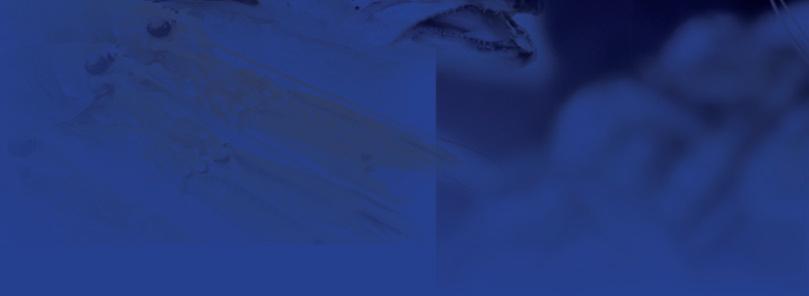


rom ingfish Maine s facility earlier this year, a limited release of Dutch ellowtail from Maine of , pounds was distributed to and served at restaurants in Maine, oston, DC and California.
ingfish is announcing another harvest scheduled in ovember, which will be distributed to select restaurants in the S, as well as being available to the residents of Jonesport.




SALMON giant Mowi has closed a processing unit at its Irish headquarters in Donegal, with the loss of 33 jobs.

The redundancy programme, which was announced with a consultation programme in May this year, affects the secondary processing unit at the facility. Mowi has now ceased secondary processing in Ireland, with fillets and portions now being dealt with in other locations. Primary processing continues, however.
Mowi told Fish Farmer: “The closure of this unit will allow customers to purchase fillets and portions from our Mowi secondary plants in Europe, which are closer to major markets. This decision will only impact customers who currently purchase fillets or portions (fresh or frozen) and will not impact those customers who purchase HOG [head on gutted] fresh Irish organic salmon, as the primary processing
section of the plant will remain operational. The closure has no impact on our Irish organic freshwater or marine operations, which continue to produce at full capacity.”
The Donegal Education and Training Board (ETB) has been on-site at Mowi’s Irish headquarters in Fanad in recent weeks to provide training and career advice to staff impacted by the redundancy announcement. Redundancy took effect as from 2 October. Redeployment options
had been offered to staff who worked in secondary production, to other aspects of operations within the company’s Donegal headquarters.
Mowi stated: “Mowi Ireland intends to grow other aspects of its operations in Ireland later in the year and the overall business outlook remains positive and healthy.
“Mowi Ireland would like to put on record its gratitude to all its staff for their exemplary commitment to the company and intends to provide every support possible through the entire process.”
AFTER five years in charge, Bjarni Ármannsson is leaving the top role at Iceland Seafood International (ISI).
The new CEO at ISI is Ægir Páll Friðbertsson. He has been Chief Operating Officer at the fishing company Brim hf. for the last five years and has worked in the seafood

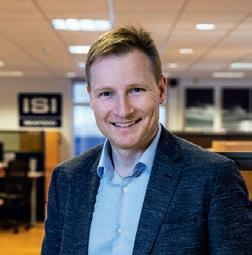
industry for most of his professional career. He holds a business degree from the University of Iceland and a master degree in finance.
Ármannsson said: “I’m very grateful for the opportunity to lead Iceland Seafood for the last almost five years. It’s been a time of learning for me and characterised by volatile externalities that have at times been challenging. I would like to thank the people I’ve worked with and the board of directors in particular for its continued support.
He added: “The Iceland Seafood group is a strong entity with a very good potential for profitability and growth going forward.
“Its unique position in delivering quality seafood to its customers, particularly in Europe, is something that has been developed for a long time and remains with many good opportunities.”

NORWEGIAN indus r or anisa�on
Seafood Companies has urged the government to remove the employer tax on the seafood industry so ore sa on and o er s can be processed a o e uc o or a s sa on or e a p e is processed undreds o i es a a in o and and en ar Rober H ri sson ana in irec or o Sea ood o panies S a bedri ene in or e ian said a e nu ber o co panies i in e sea ood indus r as a en ro in o around oda Seafood Companies already points
ou a an sa on producers i no be pa in a sa on a o on op o corpora�on a o e addi�ona e p o er a is e ec� e a produc�on ee on eac i o ra o sa on e process p us an addi�ona pa en i e an
o increase ou pu ri sson ur er said a o s or e por as processed a o e in bu a ure ad no a en o
He ar ued: e arious o ern en s a e in ce ebra or speec a er ce ebra or speec ad oca ed a ore a ue be crea ed ro sea ood in or a and a is s ou d a e p ace a on o er in s in e or o increased processin ere a o e u e ru is a i e s orse and orse i eac passin ear and ore and ore o e s e e por oes o e ar e unprocessed
“The primary processing section of the plant will remain operational ”Above: MOWI salmon processing Above: Bjarni Ármannssonm (L); Ægir Páll Friðbertsson (R)
DESPITE a big drop in profits last year, the Scottish company Thistle Seafoods has issued an upbeat assessment on future prospects for the business.
Profits were down by 90% from £3.3m in 2021 to £303,000 during the year, largely due to higher raw material costs and external factors.
Thistle bought the Dawnfresh factory at Uddingston near Glasgow last year after the company was placed in administration. This increased space, said Thistle, would allow it to offer new opportunities as they arise.
Thistle reported higher sales of £115.6m against just over £105m a year earlier. But the cost of sales (mainly fish) rose by around £12m to £100,890,000.
The company’s strategic report said 2022 presented significant challenges, which included a direct impact from the war in
A new salmon processing factory has opened in Bergen, Norway to meet growing export demand.

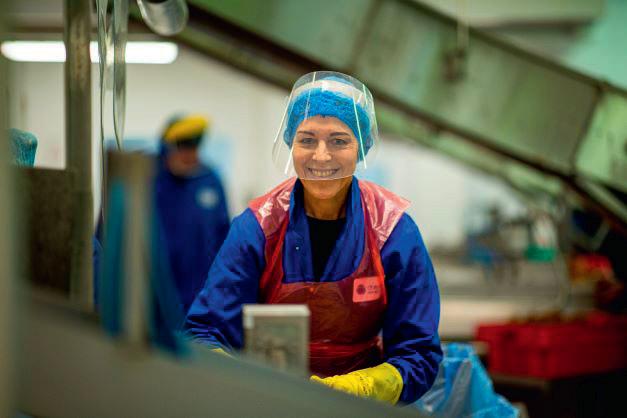
The company behind the project is First Seafood, which is part of the larger Insula roup and un� recen ad been used b a roup o produce s ca es nsu a s parent company is Kverva, the investment vehicle set up by SalMar Chairman Gustav Witzoe.
First Seafood Managing Director Andreas Sundnes said: We see a si ni can increase in de and in e e por ar e or sa on e produc s and is ac or i or par of an already established structure in First Sea ood or e purc ase produc�on and sale of salmon products.
o e er i our e is�n ac or in
Kongsvinger (near Oslo), the new factory in Bergen will give us a capacity of up to 30,000 tonnes of salmon products a year.”
First Seafood AS, which produces a wide range of products for customers all over the world, has signed a 25-year lease on the premises and says it is there for the long term.
First Seafood and the food processing company BAADER have developed and adop ed round brea in ec no o at Kongsvinger.
odu ars ad R or a s Sa es Manager, said: “This has happened in close co opera�on be een s i ed sea ood people at First Seafood and a leading technical development environment at BAADER.”
Ukraine, which led to wide ranging sanctions against Russia, a major raw material supplier to the UK.
This was compounded by “extreme energy price inflation” at home along with other inflationary effects, labour and tight supply issues.
The report continues: “In spite of all this, the company reported growth in turnover and it remains profitable, which is highly commendable, given the significant external headwinds the company faced in 2022. The turnover increased to £115m, which is a record for the company.
“We would like to recognise the support from our key customers in helping us to navigate the most challenging of years.”

The new machinery features crate de-


each line to help meet increasing market demand.
CPUK Operations Director Gary Paterson explained: “The new machinery behind the production lines from Lan Handling Technologies will make a real difference to our ability to increase productivity and meet demand, and we will continue to look for ways to innovate our production and create efficiencies.”
The
 Martin
Martin
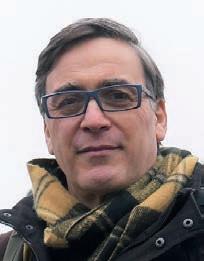
THERE has been a plethora of anti-salmon farming articles in the mainstream press of late. Most are prompted by vegan organisations and it is easy to understand that they object to farming any animal.
Salmon farming has become an easy target due to a long history of criticism from the salmon angling sector, who have continuously blamed salmon farming for the decline in wild fish numbers. This criticism has provided a backdrop for others to attack the farming industry.
One of the latest articles appeared in the Observer with a subheadline of “Vegan charity and its drones reveal that parasites are infesting fish reared for UK supermarkets.”
What a scoop for the Observer!
In response to the article, Ben Goldsmith, environmentalist and member of the influential Goldsmith family, tweeted:“Farmed salmon is revolting. If you could see it before they slice it up, dye it pink and wrap it in plastic, you’d never touch it again.”
I can understand that anglers, who are often badly informed and are never exposed to the other side of the story, pump out such nonsense. When someone has been Eton-educated and runs a private equity business, one might think that they would actually do a little research before spouting such garbage. However, seemingly not.
I was fascinated by the idea that salmon are farmed, killed, sliced up and then dyed with a pink colour. This is so far from the truth that it is unbelievable that someone with such a background would write such factually incorrect statements.
What colour would you like your haddock?
Of course, farmed salmon are not dyed. They are pigmented with natureidentical carotenoids in their diet that are deposited in the flesh, giving an even colour throughout. Much has been written about pigmentation so I won’t repeat it here. Instead, I am more intrigued by the idea of dyeing the flesh pink. If that was what actually happened, would it be such an issue?
The reason I say this is because dyed fish flesh is widely available in the marketplace, including most of the major supermarkets, and no-one bats an eyelid. The idea that it happens in salmon farming, however, seems to appal some members of the public or at least those who are critical of salmon farming.
The reality is that pigmentation is simply another issue to attack the salmon farming industry. Critics are only bothered about such issues when it relates to this sector. They complain if a salmon farm should kill a seal but aren’t interested if the wild fish sector were to do so. They criticise the use of acoustic deterrent devices, even though they are widely used outside salmon farming, and they accuse the salmon industry of “dyeing” fish, yet make no comment when others actually do so.
industry of “dyeing” fish, yet make no fillets

One example of dyed fish can be found in Marks & Spencer. Their product description of M&S Scottish skinless and boneless smoked haddock fillets states: “Skinless and boneless dyed Scottish
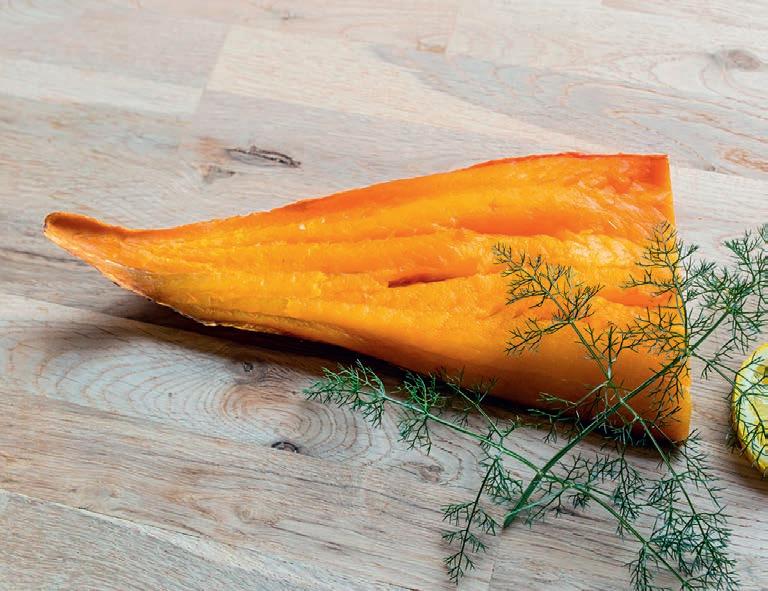

”Pigmentation is simply another issue to attack the salmon farming industry
beech wood chips for a medium smoked flavour.”
Most other supermarkets make similar statements on their smoked haddock products. However, it is not just haddock that is dyed – cod, hake, basa, kippers and mackerel can all be dyed too.

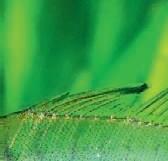

The colourants used in smoked fish are primarily curcumin or annatto, but paprika is also used. Curcumin is extracted from turmeric. Annatto is an extract from the achiote tree. These colours are included in the brining process before the fish fillets are smoked. Perhaps Mr Goldsmith thinks that this is how farmed salmon is processed to get its colour?
It is unclear when dyeing smoked fish began, but the suggestion is that it might have been introduced during the Second World War to help conserve resources by reducing the time the fish was smoked. However, it has also been suggested that the process was introduced in the late 1960s and early 1970s to reduce costs with a reduction of the smoking time from 12 hours to just three. The shorter smoking time meant that the pale-yellow colour of smoked white fish was unable to develop, hence the need for a colour. Yet dyed smoked haddock is a much stronger colour than the undyed versions and now clearly appeals to consumers.
The latest figures from Seafish suggest that the UK public consume about 2,200 tonnes of smoked fish, although this has gone down in line with a wider fish and seafood decline due to the cost-of-living crisis. It seems that the public are happy to eat

salmon so contentious? The answer is that it isn’t, except amongst a handful of very vocal critics of salmon farming, who look for any excuse to have a go. Interestingly, smoked fish is not the only fish to be dyed. The glass fish is a freshwater fish from south Asia and is of the Ambassidae family. Their main attraction is for people who keep aquarium fish because they have transparent bodies with high fins.
They are popular because they are docile but also social and live happily in groups of five.
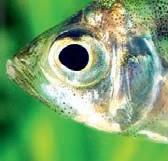




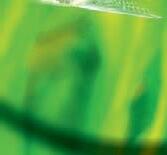



The fish are often sold as painted glass fish, having been injected with fluorescent dyes using a hypodermic syringe. The final effect is quite garish, but clearly appeals to some members of the public. Unfortunately, this process can result in high mortality but clearly, as it is not salmon farming, it attracts no criticism.
 Top: Astaxanthin
Above right: Glass fish
Top: Astaxanthin
Above right: Glass fish
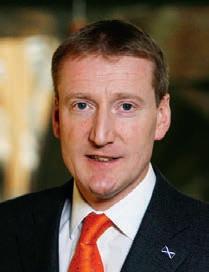
THIS July, the hottest seawater temperatures ever were recorded off the coast of Florida, where temperatures reached 38.4ºC.
This phenomenon was not unique to the US, with water temperatures in some places here around four to five degrees warmer than average. This was notably the case on the UK’s east coast.
Higher temperatures are not a direct issue for salmon, as they are within their natural range.

And given fish are cold-blooded, seawater temperature increases can actually encourage growth and allow harvest weight to be reached more quickly.
However, record seawater temperatures do contribute to an increase in naturally occurring organisms, which can reduce oxygen levels and also compromise the health of the salmon in areas such as the west coast of Scotland.


That’s why the aquaculture sector is constantly innovating to overcome challenges. The sector has been deploying a range of short-, medium- and long-term solutions to maximise survival.
”Mortality incurred in a natural environment is not an indicator of poor farming conditions, despite what uninformed activists might claim, but it goes without saying that the loss of livestock is devastating for farmers – just like when sheep farmers lose their lambs to poor weather or predation from foxes.
However, salmon are not like terrestrial livestock, which produce a relatively small number of young over their lives. When fish breed, they produce many thousands of eggs, which are fertilised outside the body.
In the wild, it’s a reproductive strategy that acknowledges a high natural level of mortality, with the goal that just a small number of salmon will survive to breed.
Of course, in farming, we want to make sure as many fish as possible survive. But all too often campaigners try to compare salmon to other livestock – and that’s just not appropriate.
This time last year, we faced a significant increase in microscopic jellyfish blooms, which affected the survival of farm-raised fish.
As we said at the time, 2022 production was down – and that is reflected in annual data now being published by government following the usual time-lag.
Better monitoring systems have since been put in place, along with a host of other mitigation measures.
Despite natural environmental challenges, the hard work and dedication of farmers and production companies has maximised survival rates in 2023, writes Salmon Scotland
Chief Executive Tavish Scott
Salmon farmers, supported by veterinarians and fish health experts, have done everything they can to maintain optimal conditions for the fish in their care.
Farms monitor sea conditions on a daily basis and have been oxygenating the water where appropriate to provide optimal fish welfare.
And a lot of work has gone into understanding the movement of micro jellyfish and other organisms, including daily monitoring and testing, with our producer companies sharing information and best practice.
So, while 2023 has not been without its own challenges, the result is that there has been good progress in managing environmental challenges in the sea.
It is testament to the hard work and dedication of production companies that we have faced the warmest temperatures on record and yet managed to maintain survival so far, on average, above 98% a month.
September is typically the most challenging month for salmon survival, but provisional figures provided by our member companies for 2023 show that salmon survival was higher than the same time last year.
Let us not forget that the Scottish salmon sector takes a proactive approach to communicating issues. Scotland’s salmon companies are the only farming sector in the UK that voluntarily publishes monthly mortality reports for individual farms.
Our member companies have been investing millions on ways to protect their salmon from the harmful effects of climate change. Mitigation measures include aeration/oxygenation of the water and feeding strategies, which minimise the time salmon spend near the water surface, where they are more likely to come into contact with jellyfish or algal blooms. We are also investigating other options, such as bubble curtains, which use air to create a barrier to prevent jellyfish and algal blooms from entering salmon pens.
We have also seen fish movements to remove salmon when the presence of micro-jellyfish is anticipated or detected, and farmers have been putting larger fish to sea.
Not all farms face identical challenges. Sometimes, a jellyfish
bloom can badly affect one site without any interaction with a neighbouring site.
Many environmental issues are also predominantly a west coast issue, with salmon farms further north in Orkney and Shetland relatively unaffected.
But there’s no question that climate change poses a long-term challenge to all food sectors, including our own. It also, more importantly, poses a threat to our very way of life.
Like all parts of the economy, we are exploring further options to mitigate the impact.
With larger fish being put to sea, “one summer” salmon could become more common – this reduces the amount of time they spend in seawater, helping to avoid contact with organisms that are harmful to our fish.
Rising seawater temperatures lead to faster fish growth, so we are able to drive that kind of innovation.
Offshore and semi-closed containment for the marine phase could also help to separate salmon from naturally occurring organisms that tend to hug the coast.
We have an incredibly talented expert workforce, who are exploring all the options.
And unlike other farming sectors, we aren’t joining the queue for government subsidies to help us fund innovation – we are tackling the issues head-on ourselves.
I know that our sector can overcome any challenges, as it has many times before, and we will continue to farm as sustainably as possible.
Unlike other sectors, we’ll also continue to be open and transparent about any challenges we face.
We pride ourselves on having the confidence to publish monthly survival data, sharing with customers and regulators contemporaneous farm-by-farm data on issues that arise.

Salmon farming sustains thousands of jobs here in Scotland and produces 850 million low-carbon, healthy, nutritious meals that are helping to feed a growing global population.
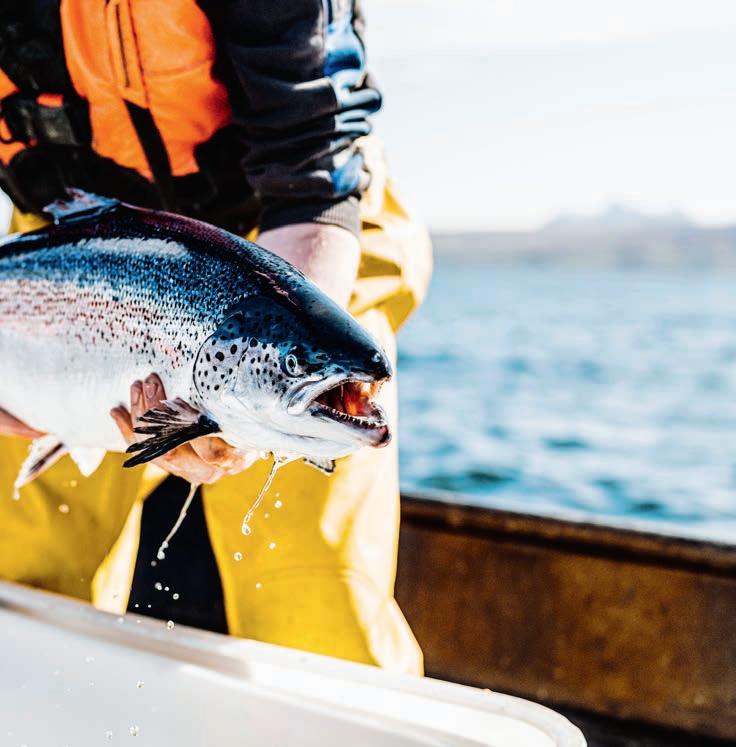
We want to produce even more fish, playing a full role in the blue economy and meeting the pledges made at every level of government from Holyrood to the UN.
While there are a tiny bunch of critics who want to close us down, the simple reality is that global climate change risks mean that we must lead the world in growing healthy, sustainable salmon for decades to come.
With its low carbon footprint, Scottish salmon is exactly the sort of climate-friendly food we should be producing more of.
Once again, despite the natural challenges witnessed this year and last, I am always encouraged by the determination of our farmers and farming companies to deliver that progress.
Tavish Scott is Chief Executive of Salmon Scotland.

An interactive online certifi cated course with 12 modules for farm, technical and health staff, and aquaculture students. Content includes biology, rearing, health and welfare, and farm deployment of cleaner fi sh.
More details at:
https://fai.academy/aquaculture/cleaner-fish-biology-rearing-and-farm-deployment
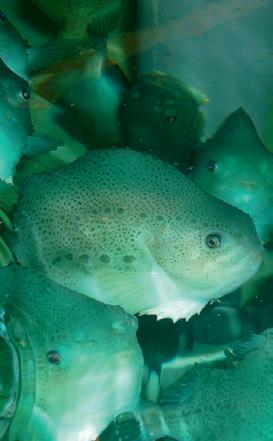
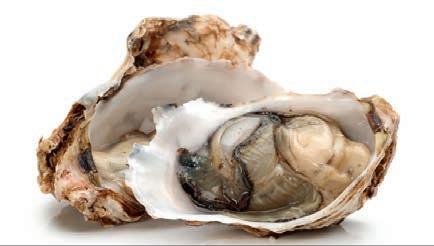 Nicki Holmyard
Nicki Holmyard





Iwas interested to read a new study* published in Science Advances this month, which demonstrates the major role played by the environment in the development of resistance to Pacific Oyster Mortality Syndrome (POMS).
The article was pertinent because POMS is a polymicrobial disease, initiated by oyster herpesvirus-1 microvariant (OsHV1 µvar) infection. The Centre for Environment, Fisheries and Aquaculture Science has just confirmed the presence of oyster herpesvirus in the Rivers Teign and Exe, and the surrounding coastline in south-west England. This has resulted in a new containment area being declared, covering the tidal waters and coastal zone around the River Exe and incorporating the River Teign containment area.
England already has OsHV-1µVar control areas in Essex, Kent and Suffolk, Butley Creek and Poole Harbour.
Shellfish farmers are now legally prohibited from moving Pacific oysters (Magallana gigas) from the new containment area without permission from the Fish Health Inspectorate, including oysters being sent to depuration plants.
Pacific oysters are the most widely farmed oysters in the world and are an important source of food and income. However, since oyster herpesvirus emerged in 2008, young oysters under 24 months old in a high density farmed or wild environment have experienced an annual rate of mortality ranging between 40% and 100% worldwide. POMS has been cited as the leading cause of mortality, with temperature and the availability of food linked to the development of the disease by altering oyster physiology.
But there is hope for the future of oyster aquaculture. New studies undertaken by scientists from Ifremer, the University of Perpignan Via Domitia, the Centre National de la Recherche Scientifique and the Ministry of Forests, Wildlife and Parks of Quebec’s expert division on aquatic fauna have now found that oyster populations highly exposed to pathogens are adapting to POMS. Their research showed that nongenetic modifications are important in allowing Pacific oysters to develop a level of resistance and also to transmit that capacity for resistance on to their offspring. This in turn results in natural selection of the strongest oysters, which are able to adapt quickly to changes in their own environment and to defend themselves against disease.
“When oysters age or are exposed to environmental stress, for example, we see epigenetic modifications appear, that is to say small changes around the DNA strands,” Jérémie Vidal-Dupiol, Marine Genomics Researcher at Ifremer, says.

“These changes are reversible and do not alter the DNA sequence, but they are enough to change how a DNA sequence is read and therefore to slightly modify the immune system of the oyster.”
In shellfish farming areas with a high loading of pathogens, up to 95% of oysters were found to develop resistance to POMS, compared to fewer than 50% outside of farming areas.
Non-genetic modifications are important in allowing Pacific oysters to develop a level of resistance
“In principle, the adaptation mechanisms of Pacific oysters that we have identified are quite comparable to those of natural selection described by Darwin. Except that instead of being due to chance alone and imposing themselves after several generations, they are put in place as predicted by Lamarck [the French naturalist, biologist and academic], who proposed the idea that biological evolution occurred and proceeded in accordance with natural laws during the life of the same individual, in direct reaction to the constraints to which he is subjected,” Vidal-Dupiol said.
The researchers hope that by highlighting the way in which the oysters develop rapid adaptation mechanisms, new strategies and breeding techniques can be found for aquaculture. Studies are already underway to see if the immune systems of oysters can be boosted by providing an enriched hatchery environment or by using probiotics, which are widely used in fish farming.
For example, French scientists at the Host-Pathogen-Environment Interactions laboratory, which has sites at the universities of Perpignan and Montpellier, recently confirmed that Pacific oysters that interacted with environmental nonpathogenic microorganisms during their early development are better protected against infectious diseases throughout their life.
Their results highlight the essential role of oysters’ exposure to environmental microorganisms at an early stage to heighten the immune system.
championships
Oyster-opening championships traditionally use native oysters (Ostrea edulis) rather than Pacific oysters to test
the skill of entrants. And for a dedicated band of champion oyster shuckers, the highest accolade is to win the world title. The World Oyster Opening Championships take place every year at the end of September at the lively Galway International Oyster and Seafood Festival in Ireland, for which they are the very raison d’être.
Competitors, who are usually winners of national competitions, are judged on their speed of opening a sealed box of 30 pre-approved Galway oysters. Points are added for presentation and deducted for debris in the shell, cut flesh and the oyster’s muscle not being properly severed. The shucker with the lowest combination of time and penalties is crowned as the new world champion. This year’s winner was Federico Fiorillo from Bentley’s Oyster Bar and Grill, who had qualified by winning the London Oyster Championships the week before. By a quirk of fate, I was honoured to step in as a last-minute judge at the London event. Actor Stephen Fry was billed to join Shellfish Association of Great
Britain (SAGB) President Chris Leftwich and Tristan Hugh Jones from Loch Ryan Oysters as a judge, but had been rushed to hospital the day before after falling six feet off the stage at the O2 Arena. He had been giving a talk on AI at the CogX tech and artificial intelligence conference.
The London Oyster Championships, which were hosted by Bentley’s and supported by SAGB, brought together 18 skilled oyster shuckers, who were first tasked with opening 12 native oysters. This allowed the judges to narrow the field down to five finalists, who each opened 30 oysters against the clock.


The judging proved to be no easy task but Federico stood out from the crowd, both in terms of speed and presentation, and we were thrilled to hear that he had also been crowned world champion in Galway.
*“Epigenetic variations are more substantial than genetic variations in rapid adaptation of oyster to Pacific oyster mortality syndrome”, Science Advances, 8 September 2023, Janan Gawra et al


www.science.org/doi/10.1126/sciadv.adh8990






By-products from a fish farm can be used to produce ingredients to help feed the fish, according to one innovative Norwegian business
THE concept of the circular economy has become increasingly relevant in aquaculture, as the industry seeks to ensure that it can grow sustainably.
One technology that appears promising involves using biogenic CO2 byproducts from industrial processes to grow protein using micro-organisms, turning a source of unwanted carbon emissions into a valuable resource.









But what if the industrial process concerned was fish farming itself? This idea underpins EcoFishCircle (EFC), a Norwegian-based business that aims to take the concept of circularity one step further.
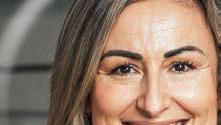




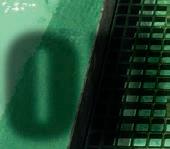
As Co-Founder and board member Jarle Dragvik explains: “80% of the emissions from Norway’s salmon industry are down to feed. EcoFishCircle replaces the traditional feed model with a circular value chain.
“The core concept of Gas2Feed (or G2F) is to use CO2 emissions from fish farming to produce protein. We call it ‘Photosynthesis 2.0’.”
The project involves two sister businesses working together: EFC, which operates a land-based salmon farm using recirculating aquaculture system (RAS) technology, and G2F, which runs the feed production process.

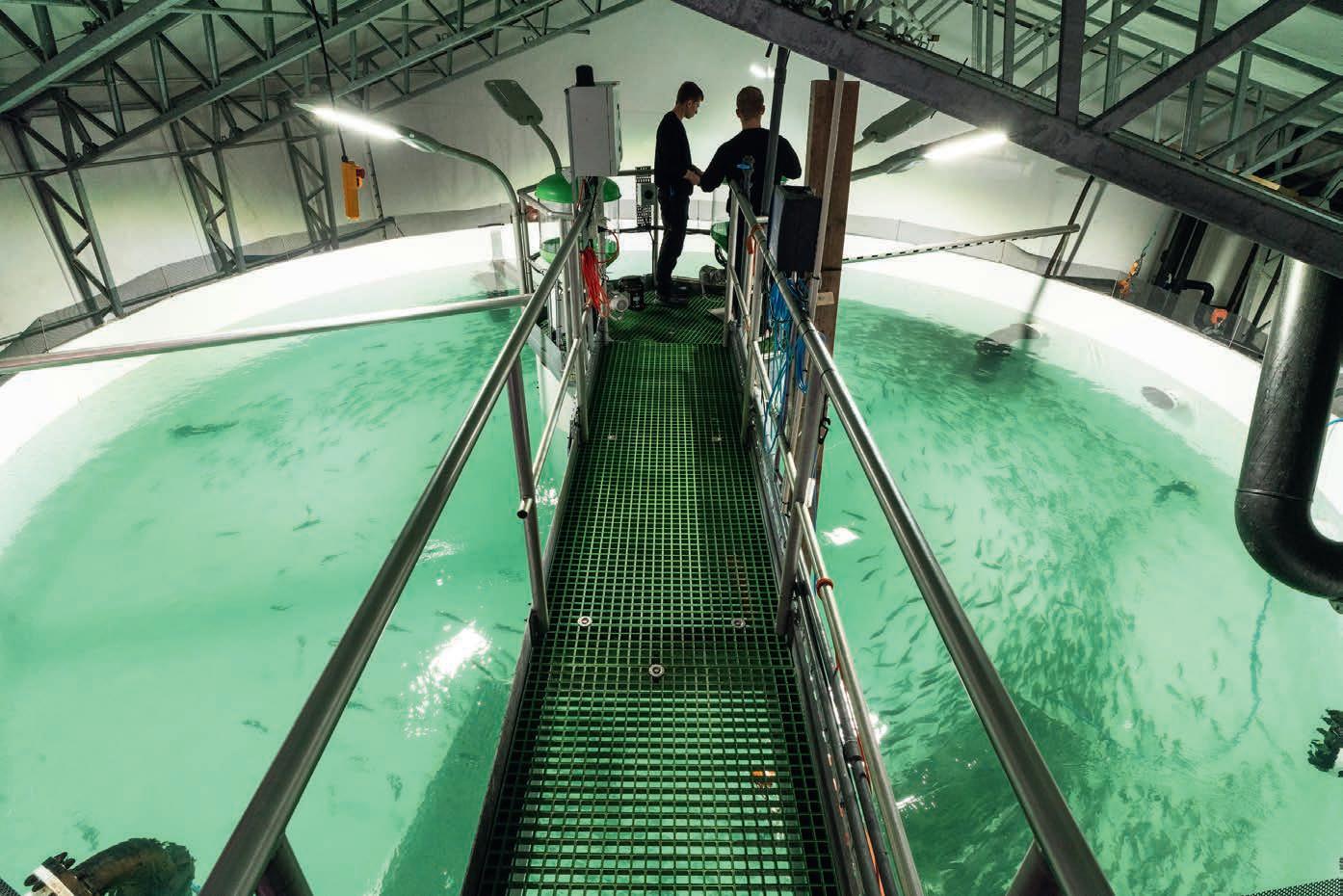
The two streams that form the basis of that process are sludge from faeces and uneaten feed, collected from the RAS system, and respiratory CO2 emissions from the fish, which need to be filtered out of the recycled water to allow the fish to breathe.
ECF operates an innovative, modular RAS facility at Hausvik in the Lyngdal district of southern Norway, while G2F has a pilot feed production plant in Sola.
The m-RAS system has been designed to be as simple as possible and the modular concept means that it is easily scalable. The standardised design is capable of being replicated in other locations.
To develop the system, Dragvik says: “EFC has been working with well-known consultants and technology experts in this field”.



The EFC m-RAS has a compact design with a centrally located biofilter. All water recycling is isolated to each tank to ensure stable water quality and avoid cross-contamination to the rest of the aquaculture facility.
Biofiltration, CO2-removal, particle removal and oxygenation occur in parallel, which facilitates the optimisation of water quality and power consumption throughout the entire life cycle of the fish. EFC and G2F works closely with HydrogenPro, which supplies new costeffective systems for electrolysis and green hydrogen production.

The system also makes use of advanced sensor and monitoring technology to track the development and welfare of the fish.


Hausvik is run in association with Ocean Farm Holding, which also runs a wrasse farm. The EFC farm includes a 150m3 breeding tank and two smaller tanks for specific technology trials. A further full scale tank capable of growing 120 tonnes is under construction.
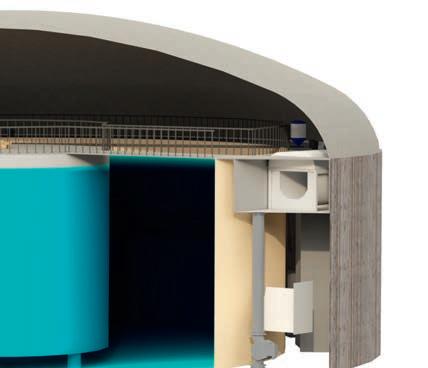

The operation of the farm and marketing of the salmon is carried out by EFC subsidiary Lista Laks AS. Dragvik says: “EFC has already produced, harvested and sold its first generation of salmon, with just 1.6% mortality and superior quality.”

The RAS facility collects sludge from the water to produce microalgae for wastewater treatment. This process ensures optimal living conditions for the fish in clean water while reducing emissions and carbon footprint.
CO2 captured from the fish’s respiration is recycled back as protein in the fish feed. The process, developed by G2F, is based on inorganic feedstock and therefore independent of agriculture.

The overall carbon saving, EFC says, is 2.2 kg of CO2 per kg round fish, compared to protein from soy production – the typical protein used to make up much of the diet for farmed salmon. Preliminary calculations show that around 30% of the fish feed can be made from recycling the carbon, with an estimated reduction of the carbon footprint of 40%, compared to traditional farming.
Soy production is highly land-intensive and EFC says the gas-based process requires 700 times less land to produce the same amount of protein. The company is working with feed giant Cargill to develop the product.
The business is backed by Norwegian tech entrepreneur Terje Mikalsen, Co-Founder of Norsk Data and board member of – among other companies –HydrogenPro. In August, Jarle Dragvik stepped down as CEO at EFC and G2F to be succeeded by Smiljana Divjak, who was formerly Chief Financial Officer at both.
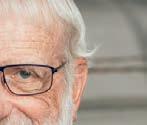

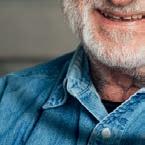


Dragvik now heads HydrogenPro, where he will lead their strategic efforts going forward. He remains a board member of EFC and G2F.





EFC is planning to scale up to 6,000 tonnes of salmon, then eventually up to 20,000 tonnes. The aim is to produce hydrogen and oxygen on-site, and 4,000 tonnes of recycled CO2 for feed.
Daniel Jakobsen, Head of Business Development, says: “Cost-wise, we will be comparable to sea farming.” Although energy costs are a factor, as a land-based operation, the cost of licensing and tax will be lower, and lower mortality rates should also help profitability.
EFC has also created a Scottish subsidiary and has acquired a site at Machrihanish on the Kintyre peninsula on the west coast. The facility, on the site of a former military base owned by Machrihanish Airport, was previously intended as the site of another RAS farm operated by Norwegian company Niri up until 2018.
The Machrihanish site comes with a licence to produce 4,000 tonnes of salmon annually, but this is not expected to start until 2027.
Meanwhile, Dragvik and his colleagues are confident that the circular concept will prove to be a winner – for the company and for the environment.
 Opposite from top: Tank at the Lista facility; Jarle Dragvik; Smiljana Divjak
This page from top: Jarle Dragvik salmon; Terje Mikalsen; RAS system tank
Opposite from top: Tank at the Lista facility; Jarle Dragvik; Smiljana Divjak
This page from top: Jarle Dragvik salmon; Terje Mikalsen; RAS system tank
EFC replaces the traditional feed model with a circular value chain









































business paper, citing Associação Brasileira da Piscicultura, in 2021 Brazil produced 841,005 tonnes of farmed fish, generating revenue of R$8bn (£1.28bn). In six years, the market has grown by 45%. According reports in the Brazilian media, the figures for 2021 are generally comparable with the results of the industry in 2022 and the current year.
Both in terms of fishing and aquaculture, Brazil produces 1.6 million tonnes (including mullet, tuna and blue land crab), with revenues of around R$20bn (£3.2bn), according to the Brazilian Association of Fish Industries. According to its experts, there is potential for further growth of these figures in years to come.
However, the ever-growing consumption of meat in the country, which has been observed in recent years, and high inflation rates have put serious pressure on the Brazilian fish farming sector this year.
HE Brazil fish farming sector is moving forward this year, albeit slowly, thanks to maintaining stable demand for Brazilian tilapia in major export markets and despite the existing serious uncertainties regarding further state policy in the sector.
The change of power in Brazil, with the re-election of Lula da Silva as President of the country, provided serious hopes for Brazil fish farmers about a change of the state’s policy for fish farming with, potentially, active support by the state.
According to farmers, the government has traditionally paid insufficient attention to problems of the industry; however, there is a high possibility that the situation will change soon.
Since the end of the pandemic, the situation in the industry has been relatively stable but a number of existing problems, according to Brazilian fish farmers and analysts, continue to prevent its more active development.
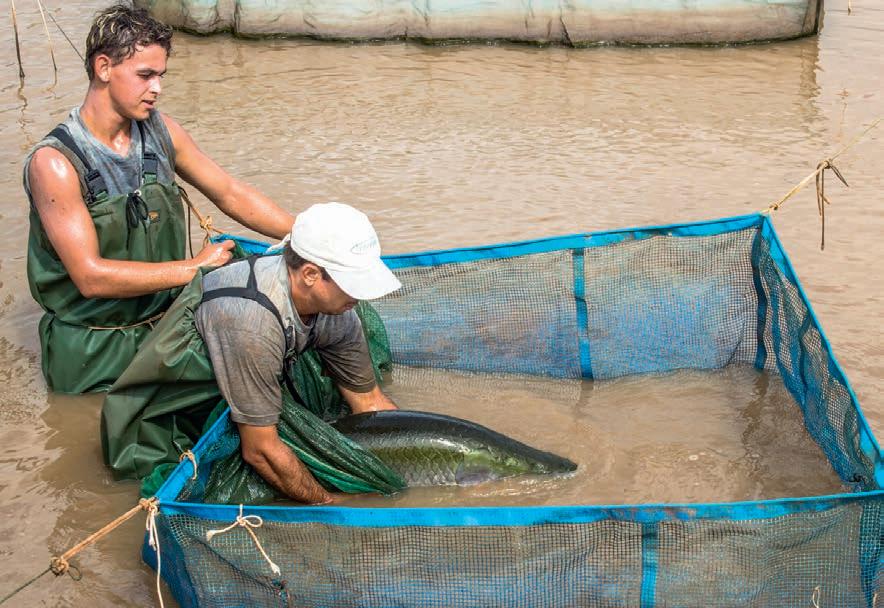
One of the major features of the Brazilian fisheries sector has traditionally been its low level of consolidation. The industry consists of hundreds of small fisheries,























which account for almost 90% of fish and seafood produced in the country. Many of them in recent years have been forced to declare bankruptcy, unable to deal with the evergrowing pressure from the state, mainly in the form of tax rises.
Historically, fish farming has always been one of the most developed sectors in the country’s entire agricultural industry, which is mainly due to big traditions of fish farming in the country, with tilapia being the most important fish species for the industry.
Traditionally, tilapia – the fish originating in Africa and widely accepted in the world market – remains the main species produced and exported by the Brazilian fish farming industry. This species accounted for 98% of sales and 99% of the volume of Brazil’s seafood exports. Most of the country’s fish and seafood exports are sent to the US and Canada.
According to Brazil’s Correio Do Estado
























































Local analysts expect fish farmers from the country’s largest fish farming states in Q4 and 2024 to face serious difficulties in the absence of real support measures from the state. In terms of geographical structure of production, Paraná is considered as one of the centres of fish farming in Brazil, followed by São Paulo, Minas Gerais, Santa Catarina and Mato Grosso do Sul. Francisco Medeiros, Executive Director of the Brazilian aquaculture association Associação Brasileira de Piscicultura, said currently tilapia accounts for 65% of all fish grown in Brazil. That means that most of fish farms in the country traditionally focus on growing tilapia and its fry.
According to Medeiros, in the last two years, production costs for Brazilian fish farmers have significantly increased. In addition, many of them in recent years have been faced with tougher competition from the meat sector, leading to the
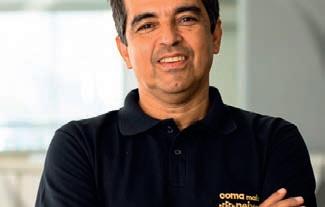

“Fish farms have been working hard to reduce production costs, while continuing investments in their further development; however, there are serious uncertainties regarding state policy in the sector. As of now, some investments in the sector have been suspended, as producers are awaiting a political stabilisation.”
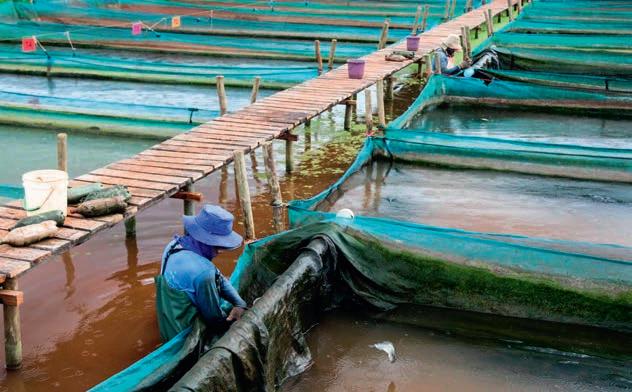
He also said the earlier energy crisis experienced by some Western countries has not had a major negative effect on Brazil’s aquaculture sector. Brazil is a large generator of energy, mainly clean energy from hydroelectric, solar and wind, with the production capacity of the latter intensified this year. In case of hydro energy, in recent years Brazil has achieved a lot of progress in using it for the aquaculture sector.
In general, representatives of Brazil’s leading industry associations believe that, among the most important industry issues that should be addressed by the state, is ensuring better access of small producers for soft loans and the provision of other financial incentives. They are also calling on the state to form a new plan for the development of the fish farming and hatcheries sector in the country.
In particular, producers are hoping for the reduction of tax pressure on the industry.
Currently, the Secretariat of Aquaculture and Fisheries of the Brazil Ministry of Agriculture, Livestock and Supply, together with Brazil’s leading fish farmers, are finishing the development of a new public policy for the growth of the Brazilian aquaculture and









investment and boost the development of this activity in the country for the next 10 years. As part of these plans, particular attention will be paid to attracting foreign investors.
The Director of the Department of Planning and Aquaculture Productive Sectors Maurício Pessôa has recently said that the new policy “…will serve as a tool for foreign investors to identify that Brazil has a mapped-out direction.”


On average, current consumption of fish in Brazil reaches 10kg per person per year. This is still below the recommended amount, which is 12kg per inhabitant per year and far from the world average of 20.2kg per person per year.
Most of the analysts believe that the reduction of the tax burden on the industry (which is currently higher than tax on the meat sector) will contribute to a further growth of the industry, particularly with regard to expansion of the existing range of species.
An example is the tambaqui, a typical fish from the Amazon with a mild but particular taste. According to some Brazilian analysts, it has a production growth potential similar to tilapia, which could lead to it becoming a typical Brazilian commodity. For that to happen, however, Brazil needs to see fish farming in the same way that Chile looked at the sector when it decided to make Chilean salmon a worldwide success.
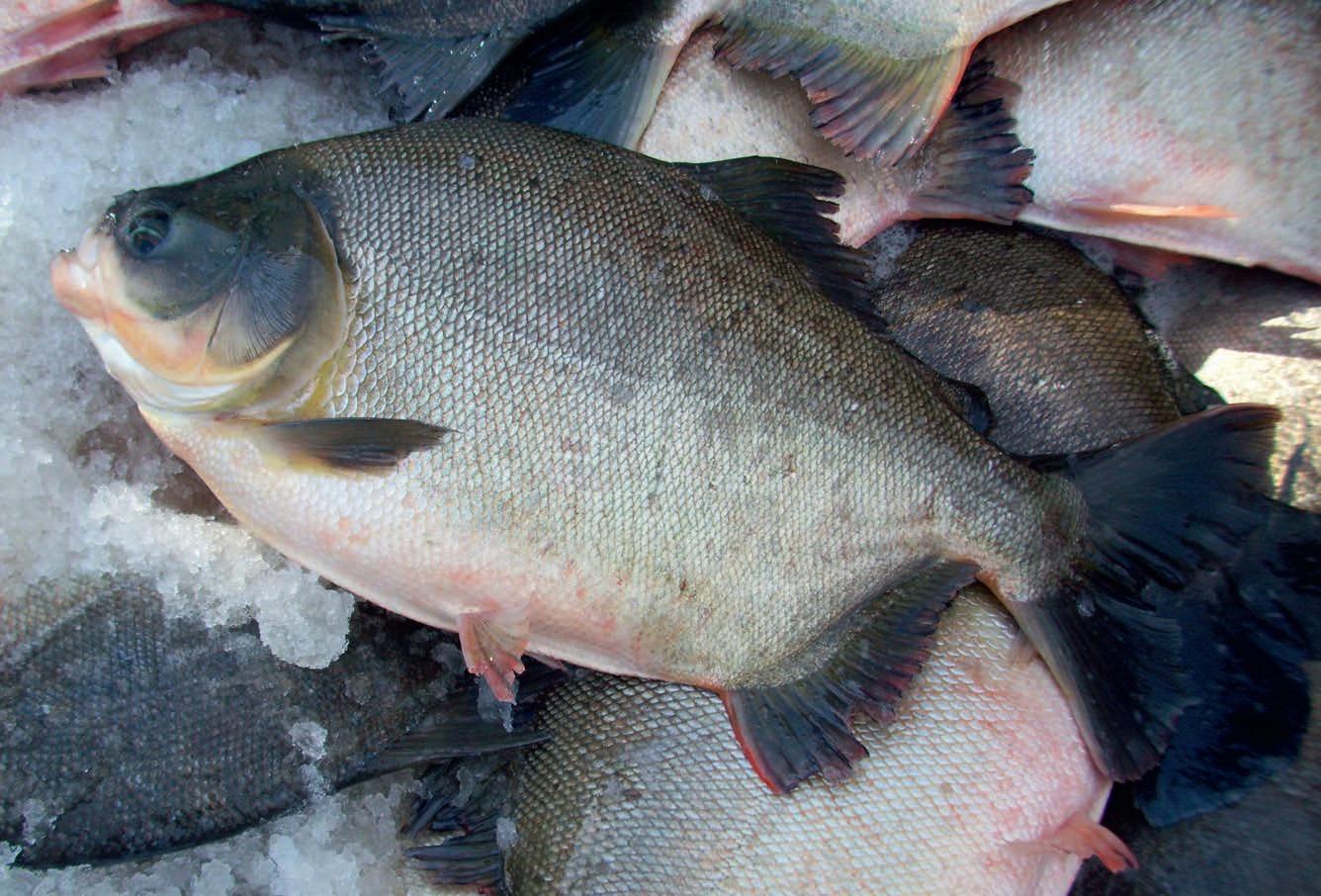
Opposite from top: Tilapia farm in Brazil; Francisco Medeiros
Above: Tamba ui fish
Below: Raising fingerlings on the Pei e i o �lapia farm

There are serious uncertainties regarding state policy in the sector



















































THE theme for the European Aquaculture Society’s (EAS) 2023 conference was “Balanced Diversity in Aquaculture Development”.

















With around 2,300 attending, 540 inperson presentations and more than 200 e-posters presenting papers online, there was certainly no lack of diversity at the Messe Wien conference centre, Vienna.
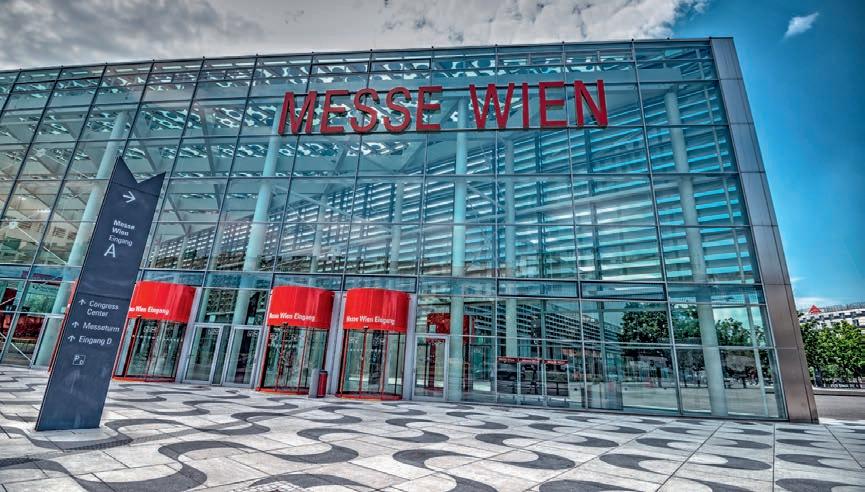
The Austrian, German and Hungarian chapters of EAS played a key role in putting the conference programme together. This provided an opportunity to shine a spotlight on freshwater farming in Europe, which can all too often be overlooked in favour of Atlantic salmon or Mediterranean sea bream.
But as EAS President Bente E Torstensen pointed out, while opening the event: “Aquaculture represents the world’s most diverse farming practices.”
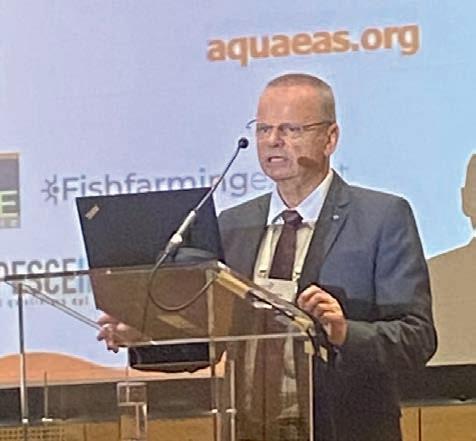
The opening ceremony also provided an opportunity to honour distinguished aquaculture expert Dr László Váradi, who was presented with Honorary Life Membership of the EAS.
The prestigious award, which is reserved for those individuals who have made an outstanding contribution to European













aquaculture, was presented by Bente E Torstensen.
Dr Váradi has been President of the Hungarian Aquaculture Association since 2010 and is also President of the Network of Aquaculture Centres in Central and Eastern Europe, an organisation he helped to set up with the intention of bringing fish farmers in eastern and western Europe closer together.
As one of the UN Food and Agricultural Organization’s expert advisers, he has also played a key role in helping countries in the developing world to cultivate their aquaculture sectors, most recently Laos, through the Hungary-Laos Joint Venture Company.
Dr Váradi was also Chairman of the steering committee for Aquaculture Europe 2023.


The first plenary speaker, opening the first full day of the conference, was Professor Jószef Popp, Professor and Dean at Szent István’s Faculty of Economics and Social Sciences in Hungary.
He spoke about “balanced diversity and the responsible use of global resources to produce healthy food”. He stressed that aquaculture is part of the solution for the challenges posed by the “population bomb”, which is set to see the number of humans on this planet rise to more than nine billion by 2050.
Even ahead of that, he stressed, there are already 0.8 billion people experiencing hunger and a further two billion facing “hidden hunger”, with enough food to survive but not to thrive.
He warned, however, that Europe’s selfsufficiency in seafood is falling, from 42% to 35%.























The sector will also have to change to be sustainable. “Aquaculture is transitioning from linear to circular models,” he said.
This first session of the conference also gave three aquaculture students the chance to present their findings in person at the Student Spotlight Awards. Ricardo Domingo-Bréton described a study looking at how gilthead sea bream microbiota changed during a record heatwave – it found the growth of brevinema bacteria
populations in north-west Spain to become
was a reliable stress marker – and how dietary intervention can control the negative impacts. Marina Pampín Iglesias talked about research that showed how genomic data can be used to help cockle populations in north-west Spain to become more resilient against infection. Daniela Resende described a study into using aromas from cooking waste waters to help make plant-based aquafeed ingredients more palatable to the fish.
Following an audience vote, DomingoBréton’s sea bream study was declared the winner.
At the second plenary session, on day two, Antti Kause – Principal Scientist at the Natural Resources Institute (Luke) in Finland – and Morten Rye, Director of External Services and Global Strategies with fish health business Benchmark, talked about “breeding for resilience.”
Kause explained that selective breeding can focus on a number of “resilience” factors, including gradual changes in temperature brought about by global warming, diseases, novel environments such as recirculating aquaculture systems (RAS) and novel feed ingredients.
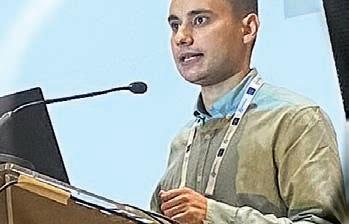

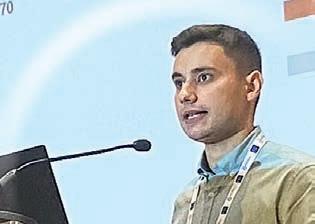
Eight out of 10 farmed
trout raised in Finland have come out of Luke’s national breeding programme, Kause said.
Rye talked about the process of selective breeding and explained how advances in our knowledge of genetics have made the process more precise and faster. Genomics mean that we now know far more about the specific markers identified with desirable traits.

And now, he said, gene editing – which is the subject of a lot of research and development, even if it has not yet entered the commercial sphere – promises to make the process even faster.
The final plenary was given by Lissy Smit, CEO of AquaSpark, an impact-driven investment fund building up a portfolio of sustainable aquaculture businesses and suppliers across the value chain.
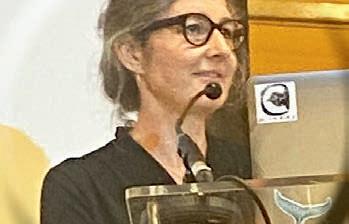
Smit talked about “investing for scale” in aquaculture. She argued that investment needs to be driven by our vision of the aquaculture sector that we wish to see and the outcomes that entails. This matters, she

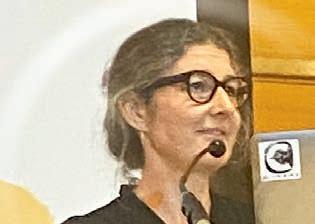
stressed, because “the oceans really are the lungs of the world” and sustainable aquaculture is a real solution to restore ocean health.
Smit said that to achieve sustainable outcomes through investment, there are five key factors:
1. Validated idea and innovative research and development



2. Resilient teams
3. A strategy for scale
4. Alliances and collaboration
5. Market and industry adoption
“It all starts with a great idea”, Smit said. The founder, however, also needs to determine how the business can scale up to reach an economic critical mass. For example, alternative feed producer Calysta, one of AquaSpark’s investments, worked ambitiously to take its idea from proof of concept to a full-scale factory in China.
AquaSpark requires that companies in its portfolio sign on to a shared values manifesto, including an agreement to collaborate with each other where there is a mutual advantage.
She stressed the importance of traceability – seafood, she said, still does not have a fully transparent supply chain.
Smit concluded: “To alleviate pressure on the oceans and to produce nutritious protein, we need to change the food system drastically.
“I cannot emphasise enough the importance of telling the story of aquaculture if we are to get more long-term capital to flow into the industry.”
FISH Farmer caught up with AquaSpark’s Lissy Smit after her address. First, how had she found the conference?
Smit said she had found it positive: “It’s great to see all these new ideas bubbling up and new solutions that are also scalable, for example around traceability or alternative protein; those are areas that excite us a lot.”
She added that AquaSpark operates in an “underinvested space”. As she explained: “There is seed funding and funding for when businesses start making a profit but when you need to scale, that’s really where I think investors need more convincing.”
She went on: “There needs to be more education about the sector because it is highly fragmented and it doesn’t always have a positive perception, rightly or wrongly. I do think getting the story out beyond the industry is important because it’s a huge opportunity. From an investor perspective, there’s nothing not to like, but it needs better explanation.
“Making sustainability the standard for farming is a huge opportunity. Conferences like this give me energy, because the solutions are there.”
Opposite from top: The Messe Wien e hibi�on centre oszef Popp Rgus page from top: Bente E Torstensen and L szl radi Ricardo Domingo Br ton Lissy SmitI cannot emphasise enough the importance of telling the story of aquaculture










































































AQUACULTURE Europe 2023 featured online presentations from e-posters and the final day of the conference included awards for the best of these.

Sara Jorge (pictured) of the University of Porto, Portugal, won the award for Best Student Poster for her presentation on zebrafish stress biomarkers.

Verena Rubel (also pictured) of the Rheinland-Pfälzische Technische Universität Kaiserslautern-Landau was named the Best Poster for her presentation on eDNA in benthic biomonitoring.
A new award, the Ibrahim Okumus Awards, selected by the EAS Student Group, went to Kine Samset Hoem of NTNU, Norway for her presentation on stimulating mucus production to reduce viral infection in farmed fish. The award was collected on her behalf by her colleague Lara Bromann.
THIS is about “the journey of a great idea”. That was the message from EAS President Bente E Torstensen at the start of the BlueInvest workshop at Aquaculture Europe 2023 (AE23).

BlueInvest is a European Union initiative that aims to boost innovation and investment in sustainable technologies for the blue economy.



Catherine Frideres, Programme Director with BlueInvest, led a panel discussion on the initiative and opportunities for investment.
She was joined by Emilia Gargallo Gonzalez, Policy Officer, Aquaculture and Sustainability Food Systems with the European Commission’s DG MARE; Lazar Petrov of Morningside Hill Capital Management; David Bassett, General Secretary of European aquaculture technology platform EATIP; and Lissy Smit, CEO of AquaSpark.
As Gonzalez explained, the BlueInvest community includes more than 7,000 aquaculture-focused organisations. A key aim, she said, is to ensure that the knowledge gained in research is transferred to the benefit of farmers and consumers.
EATIP’s Bassett said there are not enough links between research and industry, but added: “After more than 20 years, to get to a context where there is an EU aquaculture policy that is delivering, is exciting.”
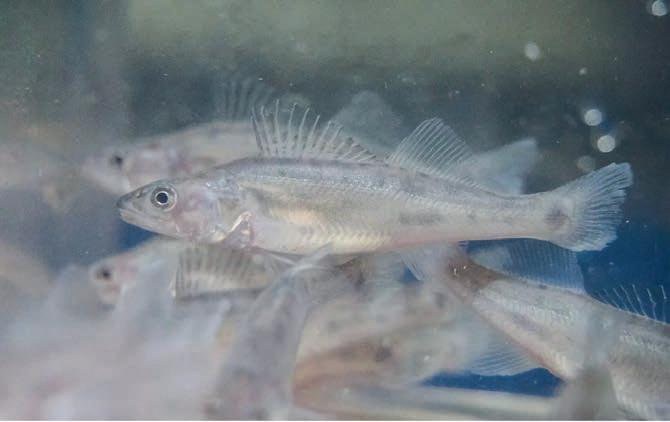
As he pointed out, some investors see aquaculture as a higherrisk sector. Being included in the EU’s Blue Economy strategy helps to “de-risk” it.
He added: “Europe is a leader in terms of technology, but do we focus enough on our own production?”
























Smit talked about AquaSpark’s investments in the aquaculture and related sectors, including tech business Ace Aquatec, black soldier fly producer Protix and eniferBio in Finland, which is developing an alternative feed ingredient based on microbiology.
Petrov started out as an investor in freshwater aquaculture and founded a trout business United Aquaculture. He now works with investment business Morningside Hill, which he said: “…saw strong growth potential in the area of sustainable aquaculture.”
Areas of particular interest for BlueInvest, Gonzalez said, include




recirculating aquaculture systems (RAS), integrated multi-trophic aquaculture, combining different species such as shellfish and seaweed), aquaponics and multiple uses for farm sites, such as renewable energy or tourism.
Algae production using shellfish for bioremediation, digital solutions and advances in fish health and welfare are also key.
With a central European venue for the EAS Conference this year, the Industry Forum at AE2023 focused on freshwater producers in a session moderated by Stefan Meyer, General Manager of The German Association of Fish Processing and Wholesalers.

Béla Halasi-Kovács of HAKI, the Hungarian Research Institute for Fisheries and Aquaculture, described the transition from “fishpond ecosystem” farming to modern freshwater farming. This is a sustainable system but there are questions over:
• The capacity of pond farming to increase production;
• The potential to stabilise and increase farmers’ incomes; and
• Opportunities to pursue a circular economy approach.
In Hungary, there has been a shift from extensive aquaculture to intensive production, which represented just 0.3% of the country’s total in 2000 but, by 2021, accounted for more than 24%.
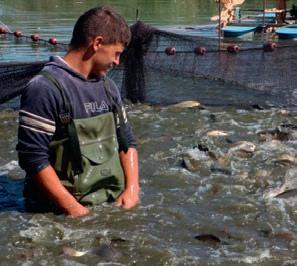
Halasi-Kovács concluded: “Under current economic, environmental and social conditions, there is no real chance to increase pond production significantly.”
He added, however, that pond aquaculture has “an excellent chance” of becoming a central player on the circular freshwater blue bioeconomy and lessons are learned from research and innovation in the sector.
Ferenc Levai of Aranyponty Fishfarm in Hungary explained how his business had taken a “multifunctional” approach to what had originally been a traditional carp pond farm. As well as producing fish – including carp, pike and catfish – for the table, Aranyponty also produces broodstock and fry for other producers, offers restocking for sports fisheries, carries out fish processing and chilled transportation, and uses its site for eco-tourism and organic agriculture.
Levai said: “Pond fish farming should be recognised as environmentally beneficial, but the sector does not get support.”
Mark Saalman of German producer Kaiserzander talked about how his company had been founded in 2013 to grow zander (Sander lucioperca), otherwise known as pike-perch. The journey had not been easy, as he explained. Having bought an existing fish farm, it soon became clear the facility was not fit for purpose. The farm had to be rethought and rebuilt from scratch.
It also proved to be difficult to source fingerlings to stock the farm for year-round production, as had been planned. By developing four “climate rooms”, Saalman explained, it was possible to get the zander to spawn four times a year instead of just once, as in nature. The fact that zander also have a “cannibalism” stage also proved to be a challenge!
By 2020, the company had completed its tests and built a hatchery, and by 2022, it was growing fish with a planned production of 100 tonnes for each cohort – although there is now capacity for 250 tonnes. This year, the company aims to be ready to sell its fish. Key bottlenecks for anyone planning something similar, Saalman said, are the need for skilled RAS specialists, and marketing – which includes convincing buyers that you can produce the fish you have committed to provide.
He concluded: “Every fish is special. You cannot build a trout farm for a pike-perch.”
The Industry Forum also heard from Gergo Gyalog of HAKI on climate change adaptation and mitigation; Mark Schumann of Fischereiforschungsstelle Langenargen on managing variable water levels and temperature in trout farms; and Henrik Sørensen of Aller Aqua on managing seasonal feeding with temperature adapted diets.
A panel discussion featured Ferenc Levai; Austrian fish farmer Ulrich Bültermann; Andreas Spranger of RAS tech producer Spranger Kunststoffe; and Adrian Feiler of compressor business Kaeser SE.
Ulrich Bültermann said he was open to trying new approaches and had recently started stocking sturgeon. Overall, though, the panel’s consensus was that freshwater farming in Europe faces a range of challenges and receives little state support.
Wednesday evening at the conference brought an event with a different flavour: razzmatazz. Flashing lights, loud music and a spinning wheel accompanied short, sharp presentations with intriguing titles such as “Sea asparagus, yum yum”, “Beer we go!” and “Get your sh*t together”.
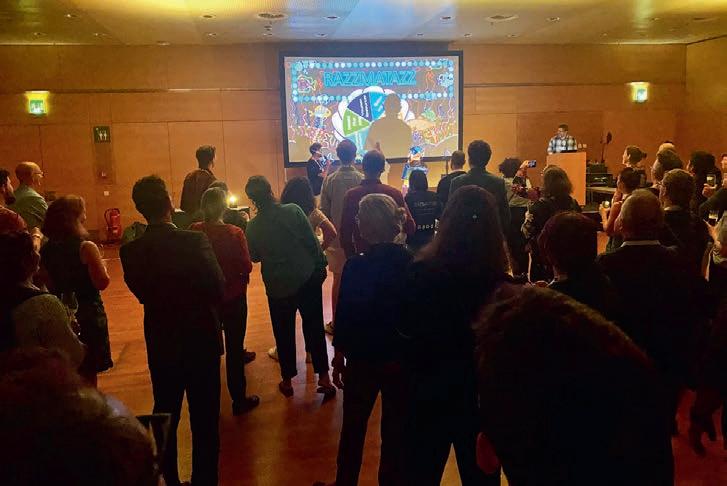
It was enough to tempt a younger crowd away from happy hour and aired some innovative ideas that had not quite made it onto the official programme.
The gold sponsor for AE23 was BioMar, with DSM as session sponsor. Meeting Destination Vienna also supported AE23.



Next year’s EAS Conference will be a joint event with the World Aquaculture Society, to be held in Copenhagen from 26 to 30 August 2024. For details, go online to aquaeas.org
 Opposite: Kaiserzander fish
This page from top: Razzmatazz event; Aranyponty pond farm worker; BlueInvest panel; (L-R) Emilia Gargallo Gonzalez, Lissy Smit, David Basse�, Lazar Petro and atherine Frideres
Opposite: Kaiserzander fish
This page from top: Razzmatazz event; Aranyponty pond farm worker; BlueInvest panel; (L-R) Emilia Gargallo Gonzalez, Lissy Smit, David Basse�, Lazar Petro and atherine Frideres
Europe is a leader in terms of technology, but do we focus enough on our own production?
BENTE E Torstensen is the European Aquaculture Society (EAS) President from 2022 to 2024 and CEO at the Norwegian research institute, Nofima. Fish Farmer met up with her towards the end of the EAS conference in Vienna in September.
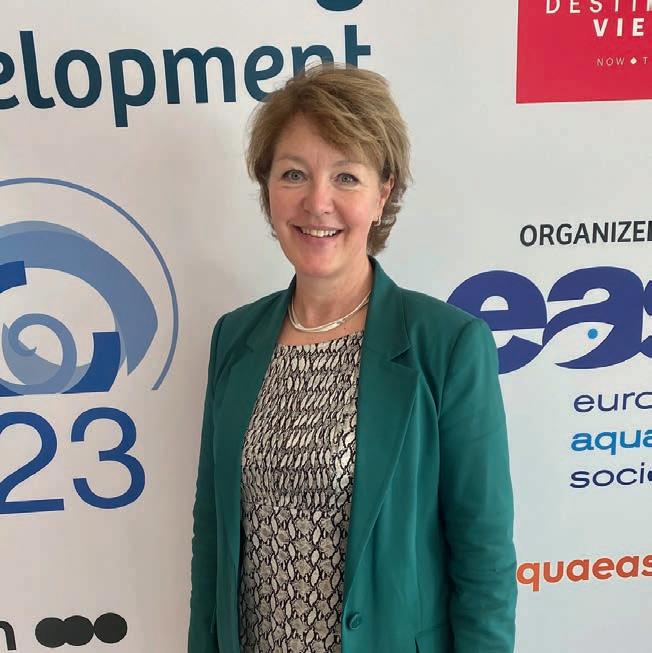
Fish Farmer:What has your first conference as President like?
Bente E Torstensen: It is really interesting. The EAS board has representatives from all across Europe. Just by being part of the board, you broaden your horizons.
It is a scientific conference with 540 presentations, 200-plus e-posters and almost 170 booths in the trade show. To be part of the society that makes this happen every year is great.
FF: Austria is probably not the first place you would think of when it comes to aquaculture. Has that made it a slightly different event?
BT: Every year, I think where we are gives a certain flavour to the event. So when we were in Madeira, that gave it a different context, like a few years ago when we were in Berlin. Then we realised that having the conference in the centre of Europe makes it easier for people to attend. The programme committee are from Hungary and Greece, and we are in Vienna, so it brought together aquaculture competence from all sides. We have seen more from central European, freshwater aquaculture, which is good.
FF: What sense do you get about the future of aquaculture when you come here?

BT: It has made me optimistic. There are many challenges that we have to solve, but aquaculture is part of the solution for making food systems more sustainable.
In some other discussions in which I am involved, agriculture is so big and our voice is small. So to come here and see that we are so many is empowering.
FF: There are polarised views as whether aquaculture is a solution or a problem. What can we do to change the narrative?
BT: We have to start with the solutions and acknowledge where the challenges are and work step by step with the solutions. The theme of this conference is “Balanced Growth With Diversity”. Diversity is a good word because there are so many species, ways of producing and types of challenges. Fish is not just fish.
FF: What are the aims for EAS?




BT: We will do our best to build membership among the people who already attend. Here, we have something like 2,300 people attending, but we have fewer than 500 members. A few years ago, we opened up student membership for free and that has increased the membership quite a lot, so it’s now about keeping them engaged in the society.
FF: What’s top of mind for Nofima at the moment?





















































































BT: We are an applied research institute for all food industries, including aquaculture, fisheries and the land-based food industry.
One of the big areas is understanding food systems, connecting the sectors and finding solutions to make the food system circular.
To make that work, you have to think in terms of green and blue, because what is waste in one system is a resource in another.
Part of it involved feed development. There is a national mission now in Norway to reach net zero emissions for aquaculture and aquaculture feed by 2030, which is a huge, ambitious goal.
The companies that develop new solutions collaborate with us and we can test their ingredients, but we do not develop insect feed, for example. Together with the NORCE research institute and the University of Bergen, we have an aquafeed technology centre, where we carry out technical testing of ingredients.
FF: When it comes to EAS and Nofima, what do you hope for by Copenhagen next year?













BT: For EAS I hope that we have doubled its members – that would be great! We also have many possibilities based on corporate membership – today, we have 17 corporate members and 162 stands at the conference. And of course, a successful event in Copenhagen.
And for Nofima, we would aim to be recognised as the sustainable circular food system institute, coming up with good solutions and innovation.

Occupying a relatively remote outcrop of our continent with some 3,000 miles of ocean to our west, it would be easy for those of us based in Scotland to feel isolated from what happens elsewhere in the world. The same is true of many aquaculture hotspots – whether Chile, Canada or Norway – and, even within them, our people and sites tend to be based in rural and remote areas.
However, my experiences of the last few weeks have only strengthened my belief in the value of looking beyond our immediate horizon and fostering relationships – particularly after the successful networking undertaken by Team Scotland at Aqua Nor back in August (see Fish Farmer, September 2023). In fact, speaking with and learning from our international peers is one of the most important things we can do – whether as a country, as the aquaculture sector or even as individuals.

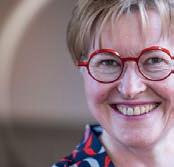
I recently attended the 10-year celebration of the Global Salmon Initiative, an international group of farmed salmon company CEOs, which brought more than 100 people together in London. Throughout the day’s presentations, two points made by speakers stood out for me: there is a narrative that we all have to face, regardless of where we are in the world and what organisation we work for, and we need to have a global dimension to all our discussions.
The big challenges the sector faces are global in nature –drawing on social licence and sustainably growing production – and these require pre-competitive collaboration. No matter what technical innovation we undertake, the sector still needs to communicate the benefits of a sustainable food system to the world and connect with the communities in which we are based. The international theme followed in a talk from Aqua Spark, the venture capital firm that invests in aquaculture. Capital can and will move wherever, and we should apply the same principle to people in our sector too. This would help aquaculture professionals to expand their appreciation and understanding of emerging good practice elsewhere, using international networks to make Scotland an even more attractive and innovative place. Of course, you don’t have to meet in person to realise the benefits of speaking to people from across the globe. At an online
seminar a few weeks ago, organised by Women in North American Aquaculture, I heard from dynamic women from Young Salmon Farmers of British Columbia in Canada, who were fantastic representatives of the sector. Their ability to articulate the benefits aquaculture brings to British Columbia is something we can all learn from, wherever we are.
Similarly, I met a young Norwegian woman exploring the possibility of creating a global network of young salmon farmers. A mutual contact in Maine had mentioned my name and she was keen to find out about Women in Scottish Aquaculture, potentially using it as a model. Without that international connection, we may never have spoken and a great idea would not have had the opportunity to germinate.

These international links are already bearing fruit, but they are even more important to the future of aquaculture. They are a mechanism by which people can feel connected with one another and develop relationships, and they will give young people the confidence to mobilise for change and shape the sector in positive ways.
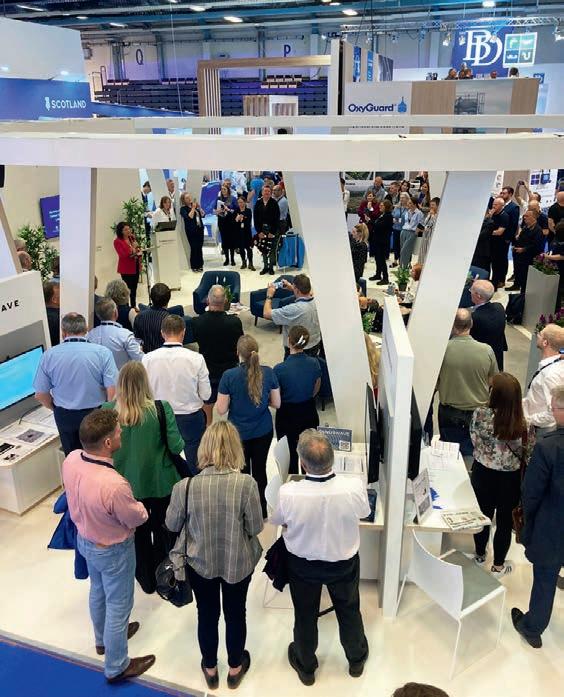




That can only be a positive step for innovation and collaboration too. In a world where no one speaks to each other, those all-important, pre-competitive challenges will never be addressed – everyone will wait for another person to make the first move. It doesn’t have to be that way and it won’t be if we all start to cast our networking nets as far as we can

There is a narrative that we all have to face, regardless of where we are in the world
International networks are more important than ever for aquaculture, argues Heather Jones
Trout farming in the UK has shown solid performance but there are questions over its capacity to grow, reports Robert Outram

TROUT production in the UK is at a much smaller scale than the Atlantic salmon sector, but trout farmers do not appear to have experienced the same kind of challenges in terms of mortalities and falling harvests that their salmon counterparts have had to contend with.
Oliver Robinson, CEO of the British Trout Association, said UK-wide estimates suggest that the industry has been growing, with around 13,600 tonnes produced (14,000 tonnes in 2021 and an estimated 15,500 tonnes or so in 2022).

The Scottish Government’s Fish Farm Production survey for 2022 records that production tonnage of rainbow trout in Scotland increased by 7% in 2022 to 8,757 tonnes. This is the highest level of rainbow trout production recorded in the country. Brown and sea trout production for Scotland remained at 23 tonnes in 2022.

UK-wide, trout production is diverse in terms of its location, with seawater sites and freshwater farms, and in terms of production – whether for the table, for sports fisheries or for restocking other fisheries.
Robinson says that demand for trout is holding up: “Every trout that is produced is being sold.”

For freshwater farmers, 2023 has been a good year so far, with a wet winter and damp spring and summer ensuring that water levels have held up well.
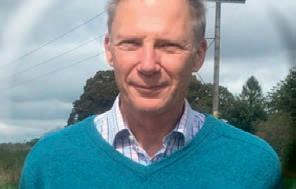

Robinson says, however: “Feed costs are an issue – like salmon, trout farmers are facing high fishmeal and fish oil costs, but commodity
prices for cereal and vegetable oil are now coming down. The sector must keep driving forward looking for novel feed ingredients and this could mitigate some of the challenges we face.
“One question is, if costs rise again, can we pass them on to consumers? The answer is we will have to if we are going to survive! Electricity costs are also a great concern. Solar panels, wind and hydro power may provide some help.”
Nick Price is Commercial Director with Test Valley Trout (TVT) Farming, a company based in Hampshire to the south of England that produces trout exclusively for the table.

TVT has been operating since the 1970s,
If costs rise again, can we pass them on to consumers?
originally growing small portion trout for retailers – one of the pioneers in supplying “white label” trout to supermarkets.
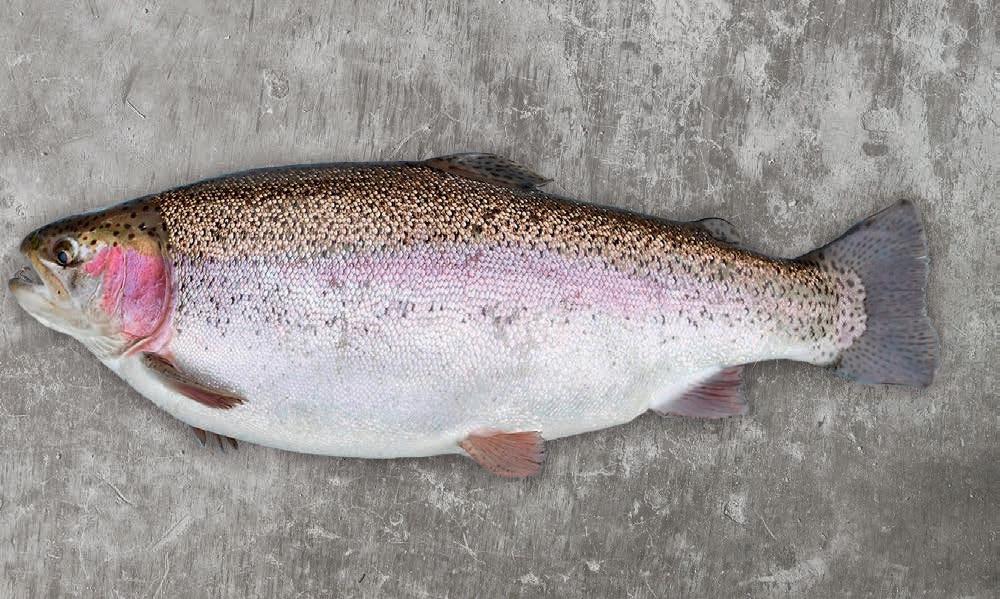
Demand for portion trout has been falling for a long time, however. TVT has transitioned to producing larger fish via the ChalkStream brand to food service clients.

Price says: “For the last few years, we have been working with ChalkStream Foods, transitioning all our farms from portion fish to larger fish, and from supplying retailers to supplying food service clients.

“Then Covid happened! That meant demand from food service dried up – but ChalkStream quickly built up its e-commerce business. Then when the lockdowns eased, demand from food service returned.”
ChalkStream Foods works closely with TVT, making use of the unique environmental advantages of river water filtered naturally through chalk hills. Rivers and streams fed through chalk streams are exceptionally clear and make for the ideal setting to raise trout – it is estimated that as much as 95% of the world’s chalk stream water is in the south of England.
The farms working with ChalkStream Foods are on old mill sites separated from the river, so there is very little risk of escapees and waste water can be settled before it is returned to the rivers.
Price says: “The move to rearing larger fish means a reduction in the number of animals on the farm, with improved husbandry and higher quality. We now vaccinate all the fish, significantly reducing the amount of antibiotics used.
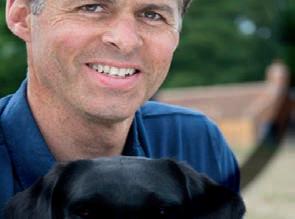
“It takes 18 months to two years to grow our fish up to an average of 3kg.
“Also, we use triploid fish, which can be more sensitive, especially as far as feeding is concerned.”
Price adds: “ChalkStream has done an


incredible job of getting trout on restaurant menus.”
In fact, some restaurants have switched from salmon to trout, whether on sustainability grounds or because pricing is more competitive. ChalkStream keeps its pricing fairly stable and doesn’t sell its fish through the spot market, which helps provide certainty for customers.
One of the key health challenges for the TVT fish is Proliferative kidney disease (PKD), which occurs naturally in the rivers and for which there is no vaccine. PKD has been linked to the organism Tetracapsuloidesbryosalmonae and affects salmonids including trout, salmon and charr.
Price explains: “PKD season runs from spring to the end of autumn. We bring our fry in all at the same time, so they can be exposed and build up resistance. If we bring them in before July, it would be too much for the fry. If any later than early August, they will not get the exposure needed to get them through the following year.
“Bringing in each year’s intake in one block is a production challenge for us.”
Opportunities for further production growth within the existing sites are restricted, Price says, although ChalkStream could have the option of bringing in other farms.
He adds: “Our biggest concern is fry supply. Egg supply from Denmark is non-existent at present due to ongoing health issues. As we are Global GAP certified, any outside supplier would also need to be certified.
“Now we are looking to build our own hatchery to supply a good proportion of our own fry.”
He hopes that the new hatchery will be completed over the next 12 months. Meanwhile, as for other producers, the cost of feed has gone up significantly over the past 18 months. The price of oxygen has gone up too, driven by the cost of energy.
And wage costs have also risen. As Price explains: “We decided we needed to continue to invest in our people. We are using feed with no marine ingredients except trimmings and we are looking at alternative protein ingredients. We are particularly interested in insect meal and algal oil, but both of these have some supply issues.”
He adds: “Personally, I find it massively disappointing that there is not more support from government for English aquaculture. Visiting Seafood Expo Global in Barcelona, there are dedicated stands for Scotland and Wales – but nothing showcasing aquaculture from England.”
The BTA is working with researchers at the Aberdeen and Nottingham universities to tackle the PKD issue. Robinson says that the aim is to develop a passive blood test for the disease as well as a water test for PKD, and hopefully a vaccine.
One success has been the development of a “bug bank” – pathogens are collected, analysed and then cryogenically frozen for when they are needed to create vaccines. For BTA, Robinson and fellow board member Peter Scott are leading on this, including gathering samples from farms.
Robinson says: “It’s amazing how it has pulled the industry together”.

The BTA has been working with government research agency the Centre for Environment, Fisheries and Aquaculture Science (Cefas), which is typing the bacteria and monitoring the spread of different strains.
In the event of a vaccine shortage – there have been problems recently but these are easing, Robinson says – the bug bank could be to provide samples to help make a vaccine quickly. Cefas is also testing sensitivity to

antibiotics and any signs of antibiotic resistance. Robinson stresses that antibiotics are only used when intervention is required, not as a preventive or precautionary measure. It is important that the trout sector can demonstrate that any indication of anti-microbial resistance is understood.
He adds that BTA is very grateful to VMD and Cefas for their support with the bug bank, which is an important project that needs to continue over the next year or two.
The Association has also been trying to get aquaculture included in the UK Government’s National Food Strategy, but so far this has not been achieved, in contrast to the situation in Scotland. Export challenges post-Brexit also remain an irritation.
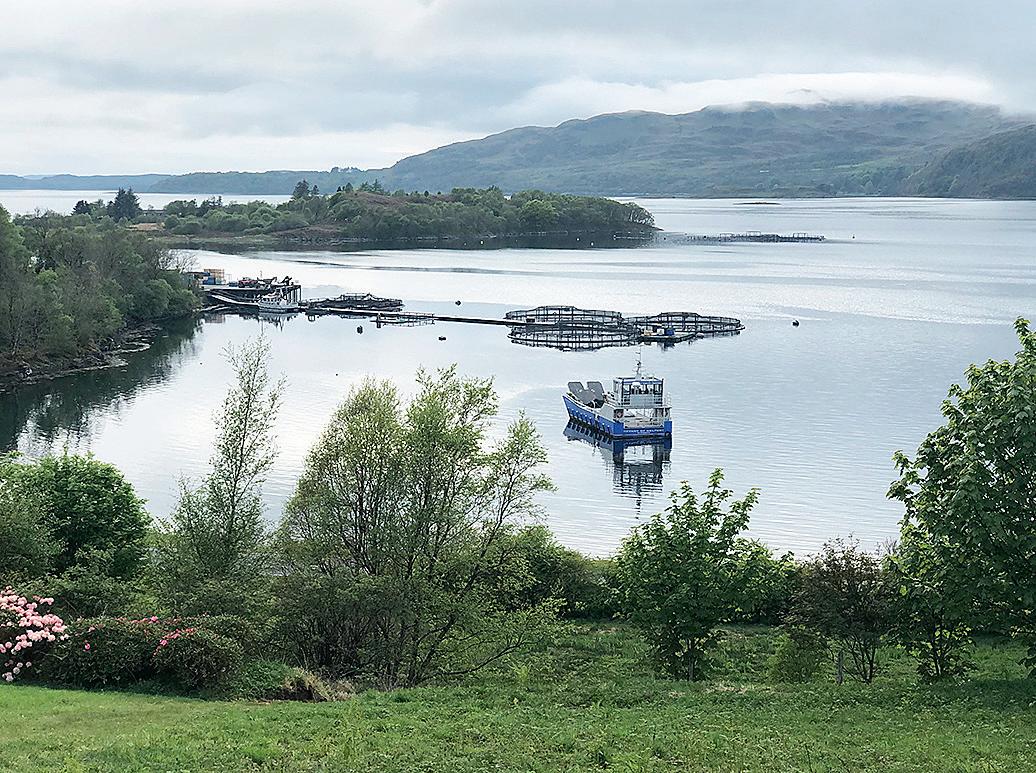
Many farms are still run by their founders, some of whom are in their 60s and 70s, so succession planning is an issue too. The Trout sector needs to encourage new entrants to invest, with this must come a skilled work force and willingness to embrace new technology.
Robinson adds: “BTA is part of a four-year PhD project looking at water quality on trout farms and the effects of health and welfare of this on the stock. Once we start receiving some data it is hoped that this will drive innovation on water quality and farm design including the consideration of part and full recirculation.
Tim Small is Managing Director of Lechlade Trout Fisheries, based in Gloucestershire. Lechlade produces trout for its own fishing lakes and offers accommodation, corporate days out and a fishing school.
Despite high feed and electricity costs, he says: “Trout fishing is on an upwards trend, particularly after the Covid lockdown, so at least there are more anglers coming through fishery gates. I think most people are at least seeing a decent footfall.
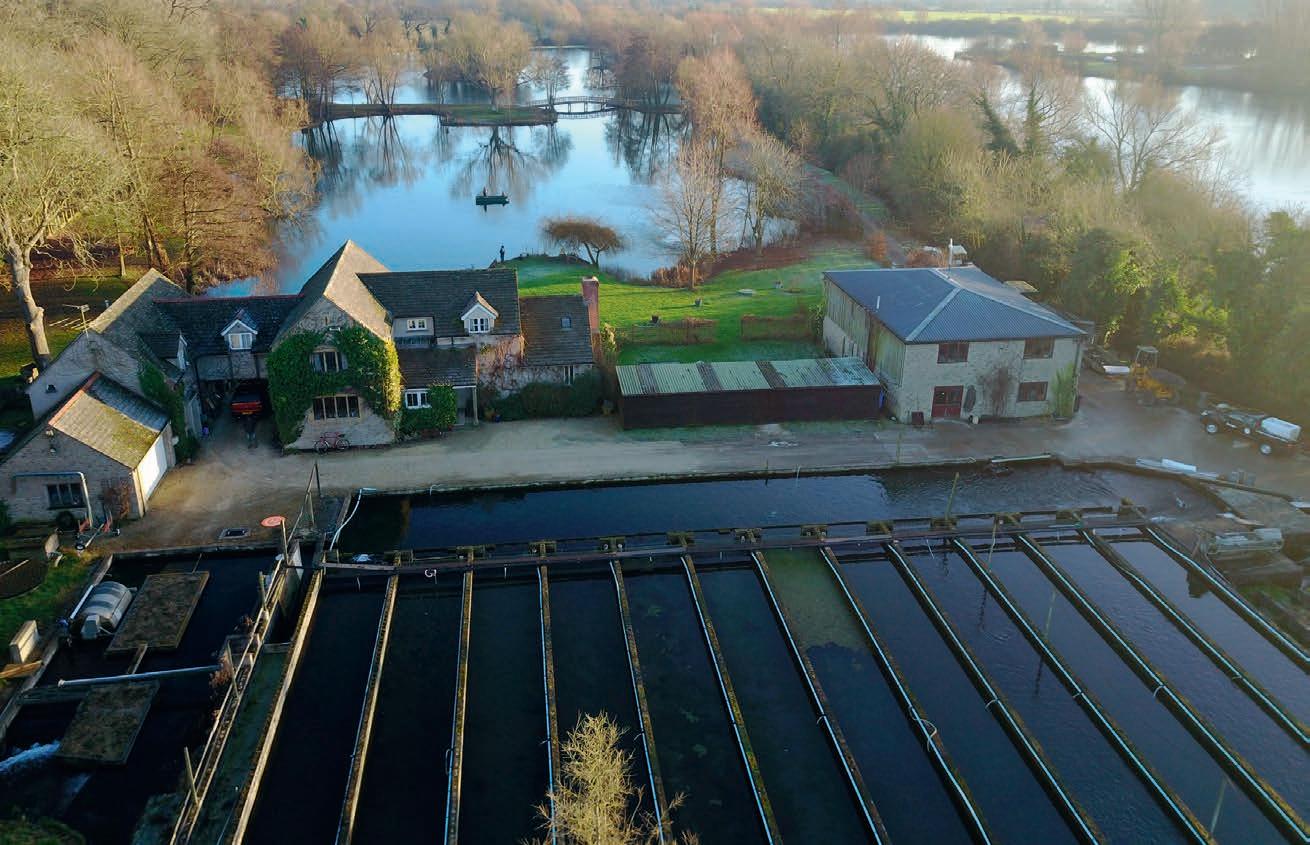
“If the uptake in trout fishing continues to grow, that can only be good. The cost of living crisis is bound to affect people’s spending though and travel costs are making people think twice.

“Stocking prices are quite high and there will be a limit eventually to what our customers will pay. Because of climate change, I cannot see any farms planning to increase production substantially.
“Upcoming legislation on water abstraction etc and the cost of




borrowing means there is a lot of uncertainty, which will hold farmers back from future investment.”
As he explains, due to the low stocking densities that restockers use, this section of the industry suffers less from disease issues.
It is climate change that presents perhaps the most worrying long-term challenge. Small says: “Warming waters are a nightmare, especially in the south. Many trout fisheries are now shut for most of the summer, just when we really want to be getting people out fishing. This never happened 10 years ago.
“Warmer waters usually mean drier weather conditions too and water shortages for farms are an ever-present worry.”
What can be done? Small says: “There is nothing that can be done about fisheries heating up. Water shortages on farms can be eased with aeration and possible oxygen introduction and recirculation [RAS] but this is not good for producing premiumquality restocking fish (which our anglers expect). Ponds tend to be far more extensive than table fish production units [so, not suitable for RAS solutions].”
In Scotland, Kames Fish Farming continues to invest despite a tragic setback in May with this year with the death of the company’s Managing Director, Neil Manchester.

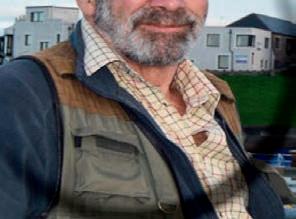
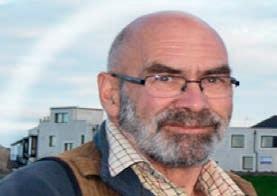
Andrew Cannon, son of Founder and Chairman Stuart Cannon, has stepped in as Managing Director and the company continues to plan for growth for its steelhead (rainbow) trout.


Larger questions appear to hang over Scotland’s other leading trout sea farmer, Dawnfresh Farming, which Mowi acquired in February this year after its parent company had been placed into administration the year before. Mowi appointed Clara McGhee as Area Manager of Dawnfresh operations.


As we reported in June, Mowi has been consulting on switching production at Dawnfresh’s Loch Etive sea loch farms from trout to salmon post-smolts.

Mowi Scotland does not have any trout farms other than the Dawnfresh operations. The rationale for the change to postsmolts is that the brackish waters of Loch Etive are the ideal environment to allow smolts to grow larger and more robust before transferring them to sea cages. In particular, because of the lower salinity in Loch Etive, sea lice – which cannot tolerate
freshwater – should be less of a problem.
Mowi’s McGhee says: “Our proposal for post-smolt production at Loch Etive will lead to a reduction in overall vessel activity on the loch and we believe it will be extremely beneficial for the salmon by maintaining a low level of sea lice.”
Mowi stresses that apart from the proposed changes at Loch Etive, all other Dawnfresh sites will remain as currently operating.
Observers have speculated that Mowi might, conversely, have some sites –whether in use or not – designated for salmon that might be more suitable for rainbow trout. The company says, however, that this is not an option being assessed at the moment.
Meanwhile, Mowi has launched a community engagement initiative and meetings with local people to explain the proposals that took place in September. Watch this space.
I find it massively disappointing that there is not more support from government
 McDonagh
McDonagh
IS the shine starting to come off Norway’s world-leading salmon farming industry?




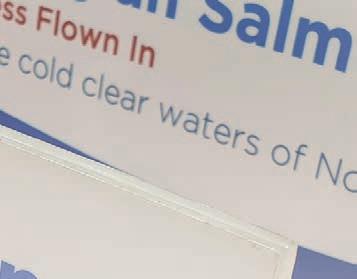

Such a question would have been unthinkable a year or two ago, but it is one now being asked by some observers, following the publication of several second quarter financial results in recent weeks.




While the sector still makes money – and lots of it – clouds are appearing on the horizon in the shape of stubborn biological problems, rising costs and, of course, that salmon tax.
The tax is already in place and will be retrospectively applied to January this year. Even though companies will not start paying it until 2024, it will eat into future profits.
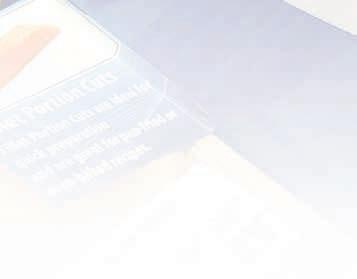
Lerøy Seafood said recently that the 25% rate comes on top of a 22% corporation rate, making an effective total of 47%.











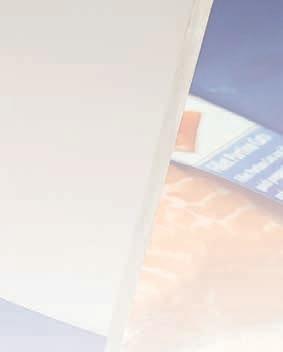


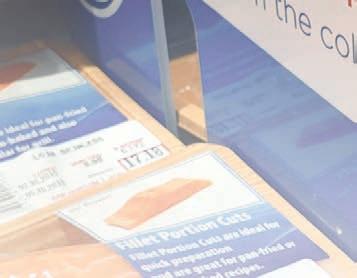

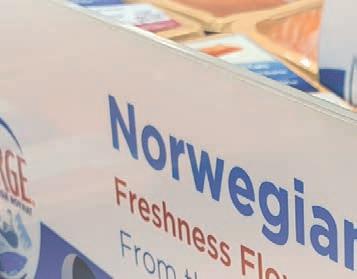

The retroactive implementation effect is estimated at NOK 1.7bn or around £125m, adding that the split between payable tax and deferred tax, and consequently the cash effect, will depend on the cost of stock of fish by year-end.
The new resource rent tax of 25% is a higher tax on only the sea phase of operations and not the full value chain, it pointed out. Lerøy said: “This sets forth strict requirements in terms of correct measurement of value creation at the different steps of the value chain. The group is working to update all its internal agreements, which need to reflect the value creation in the different parts of the value chain.”
Until this work is complete, the company argues, it will not be possible to provide proper estimates of the share of earnings from the sea-based phase. While the demands will differ from company to company, it is clear a hard rain will fall on most of the industry next year.
”We are holding our ground, hoping for a new government
Norway’s salmon farmers have created a world-class industry, but they are now facing multiple challenges. By Vince
One of the most effective arguments against the tax comes from Kristin Langeland, Communications Manager at employer organisation Seafood Norway.




She says: “The government has proposed and the Storting has voted to more than double the tax on Norwegian aquaculture. The increase comes on top of increased dividend tax, increased wealth tax, increased employer’s tax, increased fuel prices, doubled production tax on salmon, increased interest and increased inflation.
“In addition, they have proposed that the tax should be paid on an income determined by a ‘standard price council’ appointed by the Ministry of Finance, not on the income the industry actually has.”
Langeland continues: “They have also proposed that double tax should be paid on fish that were put into the sea in 2022 and 2021, but only slaughtered in 2023. This fish is expensed under the old regime, but is taxed under the new regime. There is a breach of both accounting principles and general legal opinion.”



She maintains that the state is overflowing with money while entrepreneurs, technologists and owners flee the country and billions of krone designated for investment put back in the drawer. When times are tough, she adds, governments, like business, have to make cuts.
That the seas are getting warmer is not in doubt. From southern Ireland to western
Scotland, this is creating major biological problems for salmon farmers, which are proving costly to counter.
The challenges facing Scottish Sea Farms and Mowi in Scotland and Ireland have already been well documented. Grieg became the latest company to report that biology has become a problem for its salmon farms in the south of Norway through to the colder north.



Largely as a result, its Q2 operational profit or EBIT this year fell by £32m to £40m, with infectious salmon anaemia (ISA) and spiro [the parasite Spironucleus salmonicida] the two biggest problems. Norway has reported more ISA cases in the first six months of this year compared with the whole of 2022. Grieg is fighting back and says it is starting to see positive results, but as the seas warm further it looks as if biology is going to become a never-ending battle. Perhaps the most worrying development is the increasingly bitter rift between the government and industry, which cannot be good for the country or the industry.



SalMar founder Gustav Witzøe, a committed Norwegian loyalist, has threatened to leave the country unless there is a change of heart at some point. Presumably he hopes this will happen after the next general election when the Conservatives are tipped to regain power.
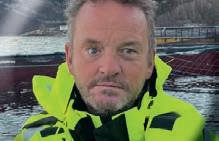
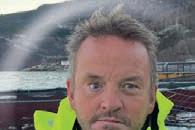

He wrote recently: “For the time being, we are holding our ground, hoping for a new government and a new majority in the Storting in two years’ time.
“It puts our patience to the test, but we still have the faith to make the impossible possible in the country we are so happy in, even if unfortunately we currently have a government that is more interested in making the possible impossible.”
He added: “Leading politicians (who now govern the country) came to visit before the last general election, looked us in the eye and promised that the ground rent tax
IN just 50 short years, salmon farming in Norway has grown from a cottage activity to become the world’s largest producer. It is an astonishing achievement by a country with a population of just 5.4 million.
Salmon is the country’s largest export commodity, selling more than 1.2 million tonnes a year, around half of total global output.
Norwegian companies have invested heavily in salmon aquaculture in Scotland, Ireland, Iceland, Canada and Chile.
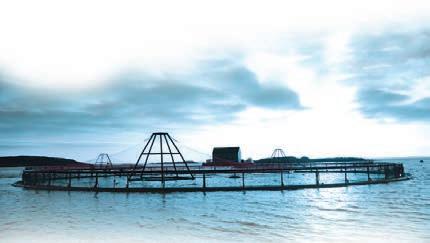
The business provides employment to 30,000 Norwegians, mostly in coastal areas where good jobs are in short supply.
Today, some 40 million salmon meals are eaten around the world every day and of these, Norwegian salmon is on the plates of more than half that figure.
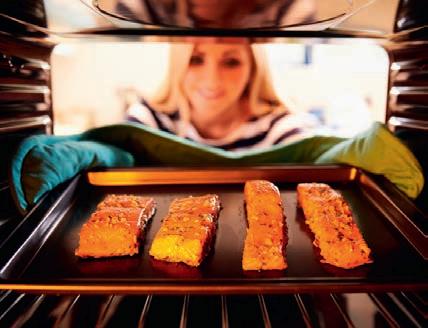
would not be introduced.”
When Labour was voted into power two years ago, Seafood Norway looked forward to working with the new government. Its Chief Executive, Geir Ove Ystmark, broadly welcomed the government strategy for the seafood sector, saying it included a commitment to investment and innovation.
But what probably angered the salmon companies more was that the fact that Labour railed against plans for a ground rent tax, when in opposition after it was proposed by a Conservative-appointed independent group of academics in 2019. It even threatened to force an election on the issue, forcing Erna Solberg, the then Prime Minister, to back off. After gaining power, Labour then went back on its word. On the other side of the argument, politicians on the left say Mowi paid out a billion krone in Q2 dividends to its shareholders, many of them domiciled overseas, two months ago. If it can afford to do that, they maintain, it can afford to pay more tax.

SEAWEED is not currently thought of as one of Scotland’s most notable assets, but it could be. The growth potential for seaweed production is significant, not just in Scotland, but also in other countries.


According to market research, the global commercial seaweed market was valued at $17.85bn (£14.7bn) in 2021 and is expected to grow at a compound annual growth rate of 10.5% between 2022 and 2030. The outlook is promising locally, as well as globally: a 2022 Scottish Government report revealed growing demand in EU markets for seaweed-based food products at around 7% to 10% per year.
As well as its economic attractions, seaweed also has social benefits. In a World Bank report on global seaweed markets, published in August, Martien van Nieuwkoop, the bank’s Global Director for Agriculture and Food, comments: “Seaweed farming demonstrates how development, climate and nature work together to generate value and uplift communities.”
He adds: “Seaweed farming will be a source of nutrition security as well as an alternative to synthetic fertiliser.”


It may take a while for some countries to reach this stage, though. While seaweed production and consumption is already well-established in the East, it is still in its infancy, in comparison, on the other side of the globe. According to the World Bank report, the market is currently dominated by a few Asian countries, which produce 98% of farmed seaweed. However, it also points out that while Western consumers are less familiar with eating
seaweed, there is growing interest and the market outlook is positive.
One of the main reasons why seaweed production has taken off in Asia is that it has its roots in the past. As Rhianna Rees, Business Development Manager at the Scottish Seaweed Industry Association (SSIA) observes: “Seaweed has been a part of the diet in both Asian and European cultures for centuries. However, in the
Seaweed farming will be a source of nutrition security
Seaweed has the potential to grow as an industry, if it can tackle the challenges, as Fiona Nicolson reports
East, seaweed was often celebrated as a delicacy, whereas in the West, it was more commonly seen as a food source to turn to during times of scarcity and desperation.
“Also, Asian countries have invested more in the development of regulations and infrastructure to support seaweed farming and processing. This proactive approach has created a conducive environment for the growth of the seaweed industry in these regions, providing a strong foundation for expansion and development.”
However, change could be on the horizon, as there are moves afoot by entrepreneurs in Scotland and other Western countries to further develop market share.


While Scotland is actively harvesting seaweed, it is currently lagging other Western countries on volume. The Scottish Government report revealed that Scotland’s wild seaweed harvesting amounted to only 8,000 to 15,000 tonnes per year in 2020. In comparison, Norway harvested 141,000 to 169,000 tonnes of seaweed, France’s total was 19,000 to 69,000 tonnes and Ireland’s output added up to around 30,000 tonnes. According to the Scottish Government’s survey, the seaweed sector employed 59 people and had an estimated total turnover of around £4m per year in 2020. But there is scope for this to increase. The report concludes that “there is growth potential in the seaweed industry”, estimating that the sector could generate turnover of at least £22.1m and 130 full-time jobs by 2040.
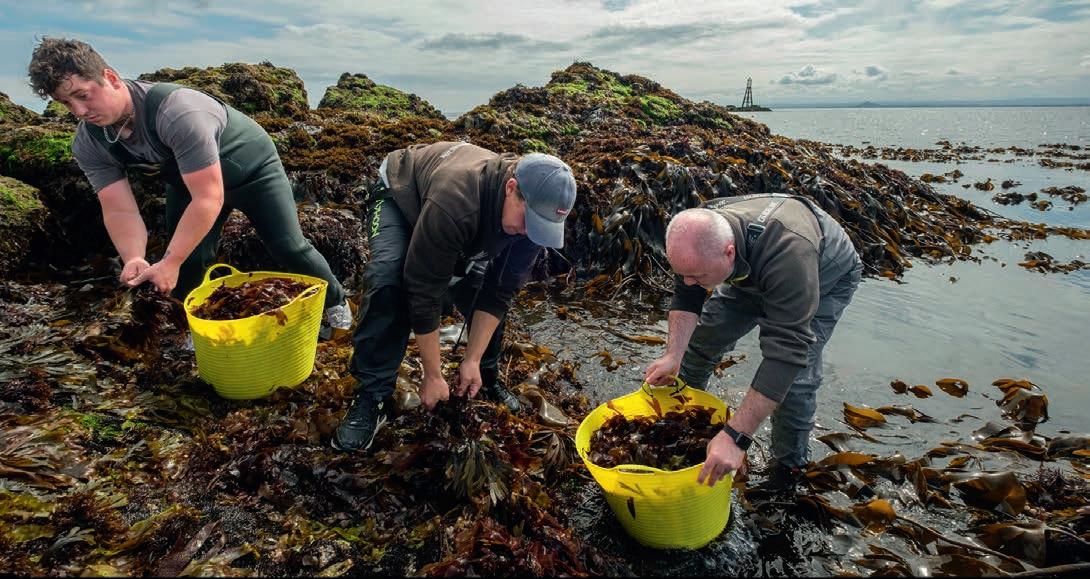
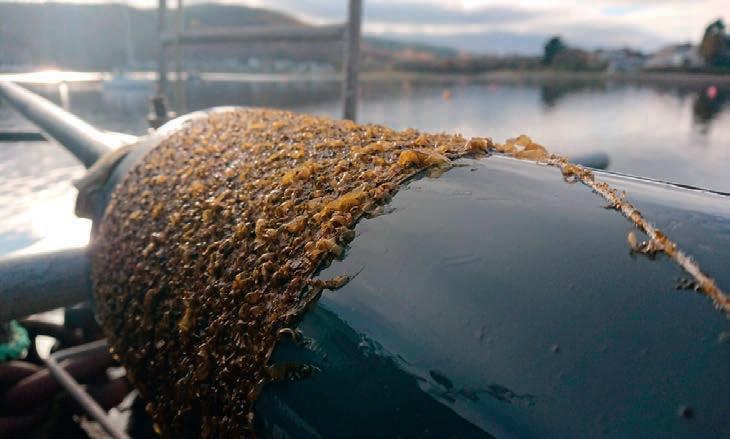



There are many opportunities for development of the sector, given seaweed’s wide range of uses, Dr Adam Hughes of the Scottish Association for Marine Science (SAMS) says: “There is huge potential to grow seaweed in Scotland for food, but also for other uses such as chemicals and energy.”

And Scotland already has a natural advantage, as Rees observes: “We have nutrient-rich, cold seas, which are ideal for growing large kelp species in the winter months.” It has impressive sustainability credentials too: “It is considered one of the most sustainable resources available, requiring no fresh water, fertiliser or pesticides,” Rees adds.
Opposite, from top: Pete Higgins, CEO of Seaweed Enterprises; nori seaweed chips
This page from top: Seaweed Enterprises harvest; SAMS seaweed nursery Twine deployment; SAMS seaweed
While the potential is there for the Scottish seaweed sector, there are many challenges to overcome along the way. In the Scottish Government’s report, the seaweed-based industry stakeholders consulted, including businesses and potential new entrants, reported a number of barriers to growth.
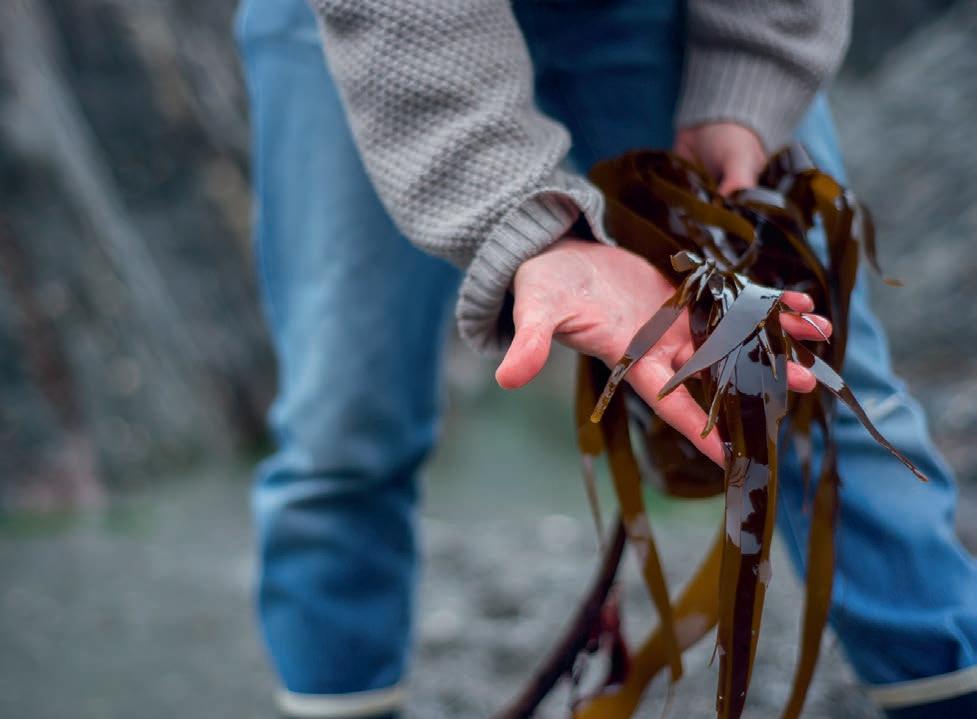

From a financial perspective, they drew attention to substantial start-up investment costs, risk and limited access to finance. They also flagged the relatively low value of, and uncertainty around, markets for the species that can currently be cultivated. The scale of cultivation required for the sector to be economically viable was an issue too, as was the need for further supply chain and infrastructure development.
Red tape was a recurring theme within stakeholders’ feedback. Many indicated that the proportionate regulation of access to wild seaweed could be pivotal, as would timely decisions on consent to wild harvest. In addition, the time taken to receive a marine licence for seaweed cultivation was a possible obstacle.
Reflecting on the challenges, Hughes comments: “At the small scale the industry is currently at, the economics are difficult and joining seaweed farmers up with companies looking to use seaweed can be a challenge. There are also logistical issues around stabilising the seaweed once it has been harvested, so it can get to market.”
Pete Higgins of Seaweed Enterprises in Fife also points to some difficulties experienced by the industry: “Seaweed deteriorates in quality quite quickly after being removed from the sea. To harvest, move and process seaweed quickly and efficiently at scale requires a myriad of bottlenecks in logistics to be removed to ensure quality control is maintained. Drying seaweed is a well-used method, but with energy costs as they are, alternative means of preserving seaweed quality are being pioneered. All this takes time, effort, patience and investment.”
Rees notes scaling issues, as she explains: “Seaweed typically grows as a seasonal winter crop, resulting in a single, substantial harvest each year. The lack of essential infrastructure, including large-scale processing facilities and seed nurseries geared towards scaling production, creates significant bottlenecks in achieving scalability within the industry.”
Further enhancing collaboration, along with an overhaul of rules and regulations, could be beneficial. Rees observes: “The success of production hinges on a harmonious convergence of industry, governance and research.




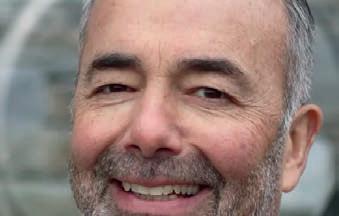
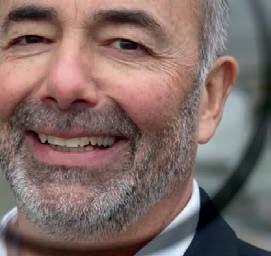
“The three entities often find themselves at odds with each other, trying to help the seaweed sector succeed, but also creating regulatory standards throughout the process that can sometimes be unclear and difficult to navigate. There is a need for ingenuity and resourcefulness to help the sector develop.”
Keeping costs down is another important goal if the sector is to progress, says Peter Elbourne, Managing Director of Horizon Seaweed in Caithness: “Reducing the cost of production will help open up new markets for seaweed.”
He adds: “Currently, farming is much more expensive than wild gathering and limited to a few species of kelp.”



In addition, there is no guarantee that the public will welcome it. As Rees points out: “In the Western world, seaweed faces hurdles in gaining consumer recognition and acceptance as a viable food source.”
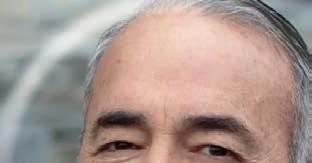
For it to become a force, the seaweed producers need to work together
Despite the various challenges, the seaweed sector is making significant progress and attracting interest. In April 2022, SAMS launched what it described as a “seaweed revolution” in the form of its Seaweed Academy in Oban. It was set up as a one-stop shop for supporting the expansion of and skills development in the seaweed aquaculture industry. In its first year, the academy ran seven sold-out courses and trained 70 people.
Others in the industry are forging ahead with ambitious goals too, such as Seaweed Enterprises, which harvests and processes seaweed and then turns it into seasonings, ingredients and food.
In August, after buying the assets from Mara Seaweed, which had gone into administration, the company retained seven local jobs and announced plans to develop a primary processing facility. The new firm’s aim is to scale up the factory and operations using cuttingedge technology to become the UK’s main seaweed harvesting and processing hub.
Higgins, the firm’s Chief Executive, believes that there is more progress to be made on the development of seaweed production and consumption. As he explains: “We are all for it and will be central to driving it forward, but it must be done with transparency and sustainability at its heart, from the spatial planning needed with other marine users to the methods of farming and wild-harvesting techniques employed to protect our vital marine environments.
“We need more people in the industry to join those already operating, but with the right care and regulatory attention that we should expect from anyone producing products from valuable primary agricultural crops in delicate ecosystems.”
He also emphasises the importance of collaboration, adding: “While the SSIA and the SAMS teams do great work, when compared to agriculture and fishing, seaweed provides only a tiny part of the UK food infrastructure. Therefore, everything from product awareness to lobbying pressure is equally small. For it to become a force, the seaweed producers need to work together.”
Higgins is, nevertheless, upbeat about the pace of change and progress: “It is becoming more viable and more visible.”


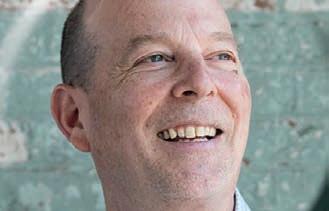



On the other side of the pond Seaweed harvesting and production is making waves on the other side of the Atlantic too. Cascadia Seaweed,
a British Columbiabased business, which started in 2019, recently announced that its harvest season (which mainly took place between April and May) had significantly exceeded predictions. More than 300 tonnes of kelp was cultivated from eight farms around Vancouver Island and two locations in northern British Columbia. The firm reported that in some locations, average yields reached more than 6kg per metre, double the amount expected.
As with other Western countries, making effective use of seaweed in Canada is nothing new, historically.
“Indigenous communities along the coast of British Columbia have been harvesting seaweed for millennia as a valuable trading resource and for food and medicinal purposes,” says Cascadia Seaweed’s Chief Executive Mike Williamson. Cascadia, which cultivates and
harvests local species of seaweed, works in partnership with indigenous communities on the coast.
Further south, in the US, seaweed business Ocean’s Balance, based in Maine, is also making reporting significant developments, including solutions to longstanding problems. In September, it announced a partnership with North America’s largest supplier of dulse, with the goal of expanding its product offerings. It also bought a state-of-the-art seaweed drier in April.

Chief Executive Mitch Lench said: “Demand for Maine-grown seaweed has grown exponentially over the last decade, yet there is a bottleneck when it comes to processing this heavy, wet material.”
He took the view that increasing drying capacity on a large scale could provide the area’s seaweed industry with an environmentally sustainable advantage and could also position it to become a major economic driver for the state of Maine.
For the previous six years, the company had explored a variety of ways to solve drying difficulties, including greenhouses and off-the-shelf commercial dryers used for other agricultural products: “We learned the hard way that it’s impossible to dry kelp outside naturally in April and May at scale,” recalls Lench.
In the end, Ocean’s Balance sought help from an overseas partner with seaweed industry experience, which agreed to design and build a machine that can specifically handle the kelps that grow in the region. Having found a solution, Ocean’s Balance is happy to share it, allowing seaweed growers from across the state to rent the drier.
While much progress is being made to develop the seaweed industry in Western countries, there is still much more to do.
As Seaweed Enterprises’ Higgins concludes: “From initial awareness to understanding and purchase, consumers need education and inspiration. The more players and products in the market to help consumers on this journey, the better.”
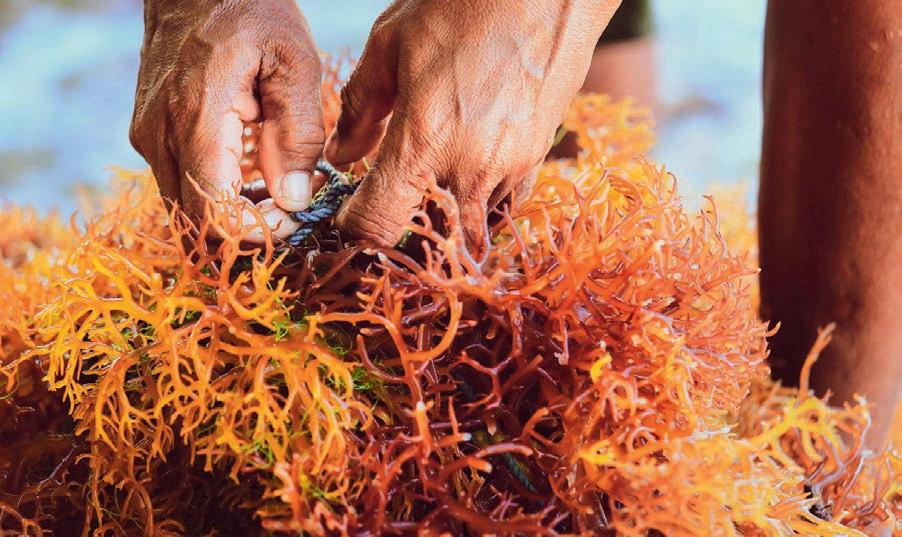
 McDonagh
McDonagh









AN invasion from Russia is happening, right now. The intruders come in their thousands and when they are killed, more come to replace them.

This is not a prelude to World War Three but a marine menace in the shape of humpback salmon, sometimes called pink salmon. This alien species is troubling the authorities in Scandinavia, Iceland and now Britain. They are even being seen as a threat as far out as Atlantic Canada. Norway is the worst affected country but three months ago, the UK Environment Agency issued a plea to anglers to report any they find.
Last year, the North Atlantic Salmon Conservation Organization, meeting in Scotland, said it “considered with alarm the threat that Pacific pink salmon, an invasive species, spreading throughout the North Atlantic, is now posing to wild North







Atlantic salmon.” While they are a particular threat to wild Atlantic salmon, marine biologists believe the invasion could also have implications for the farmed variety.

Humpback salmon (Oncorhynchus gorbuscha) originate in the north Pacific but in the 1950s, Soviet Russia stocked its rivers with these fish to ease an acute food shortage.




They escaped the rivers, however, and found their way into the White Sea before following ocean currents across the north Norwegian coast, over to Iceland and down to the British Isles. The fear is that they will eventually overwhelm native Atlantic salmon and other wild fish, with all that implies.
The Environment Agency says it has a programme to deliver action and results identified within its non-native invasive species strategy.
Simon Toms, National Fisheries Management Team Leader at the Environment Agency, said: “Our teams are working hard to contain and control invasive non-native species so that native fish, ecosystems and other wildlife are reduced from the damage they pose.
“That is why it is crucial that the public understand this immediate risk and report the capture or sightings of all pink salmon to us, whether that be through our new reporting tool or to the Environment Agency’s national hotline.”
But it is Norway that finds itself on the front line. Despite attempts to reduce numbers over the past two years, when tens of thousands were killed, they are reported to have made a comeback in recent months.
So far this year, a total of 237,590 humpback salmon have been taken from rivers in Norway, mostly in Finnmark.
Many humpbacks were caught by teams of volunteers spread across the dozens of rivers in the north.
The government gave NOK 1m (£75,000) towards the cost of tackling the problem, but the conservation volunteers say it is simply not enough.
However, the authorities do have a budget of NOK 28 million (£2.1m) for, among other things, fishing traps and operations in Troms and Finnmark, but in many of the rivers this work is carried out on a voluntary basis throughout the summer.
Humpbacks have a two-year life cycle. They are present in even- or odd-year cohorts, with fish sharing the same watershed spawning grounds while reproductively isolated and genetically distinct.
Biologist Rune Muladal from the environmental related research companyNaturtjenester told the broadcaster NRK recently there could be up to a million humpbacks in and around Norway this year.
If that estimate proves to be correct, then it will be 10 times the number identified two years ago.
These fish grow faster than farmed salmon and during part of their life cycle, they look similar to the Atlantic variety. Except when they come back to spawn in freshwater, the physical appearance of males is
transformed and they start to grow a lump on their backs.
After spawning, they don’t return to the sea, but die in freshwater. Muladal says he and other biologists remain unsure about their eventual biological impact.
They are seen as nutritious, which is why the Russians decided to stock their rivers with them more than half a century ago. But he says that as they rot, the bacteria could lead to diseases, which could then develop into other diseases affecting salmon in fish farms.
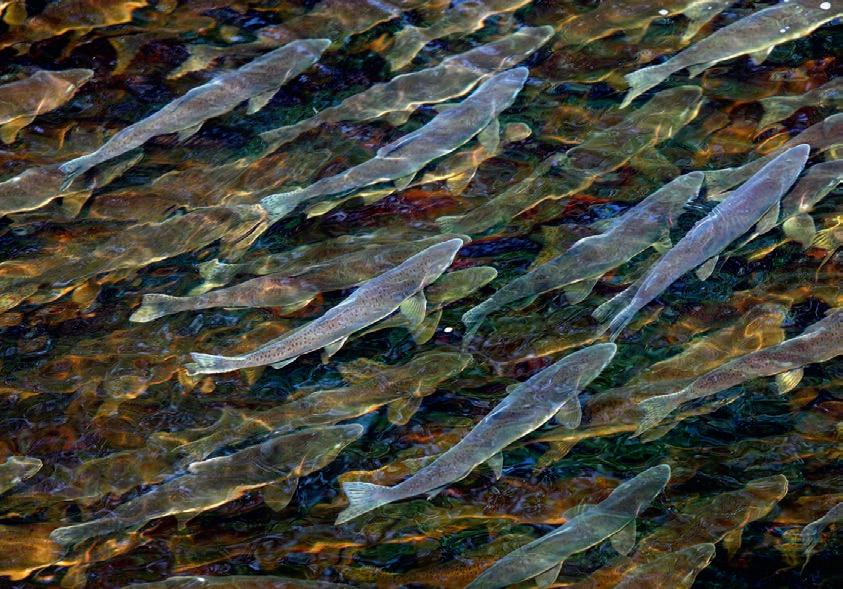
There are some people who believe they should not be dumped but used to help countries where nutritious protein is in short supply.
The issue has led to a political row in Norway, with the Socialist Left Party saying the government is not doing enough to control the situation, claiming that some of the measures out at sea may threaten the very species they are trying to protect.
Although a long way from Russia, Iceland is not immune. Fishermen have told the national broadcaster RUV.is that they have caught scores of them this year and that the invaders are now threatening native fish.
As in the UK, people are being asked to report it if they spot or catch humpback salmon in Icelandic rivers.
The battle against the “zombie” fish, as they are sometimes called in Norway, clearly has a long way to go if it is ever to be won.
The odds are that it will be more a question of keeping numbers down to something like a containable level.
Opposite from top: A fisherman holding up a male humpback pink salmon from a ri er in Bri�sh olumbia, anada humpback in asion
This page from top: nk sketch of pink (humpback) salmon and Atlan�c salmon migra�on of pink salmon



GROWING fish on land has been seen as a solution to challenges facing farming in the marine environment, including dealing with waste, predators, pathogens and parasites.
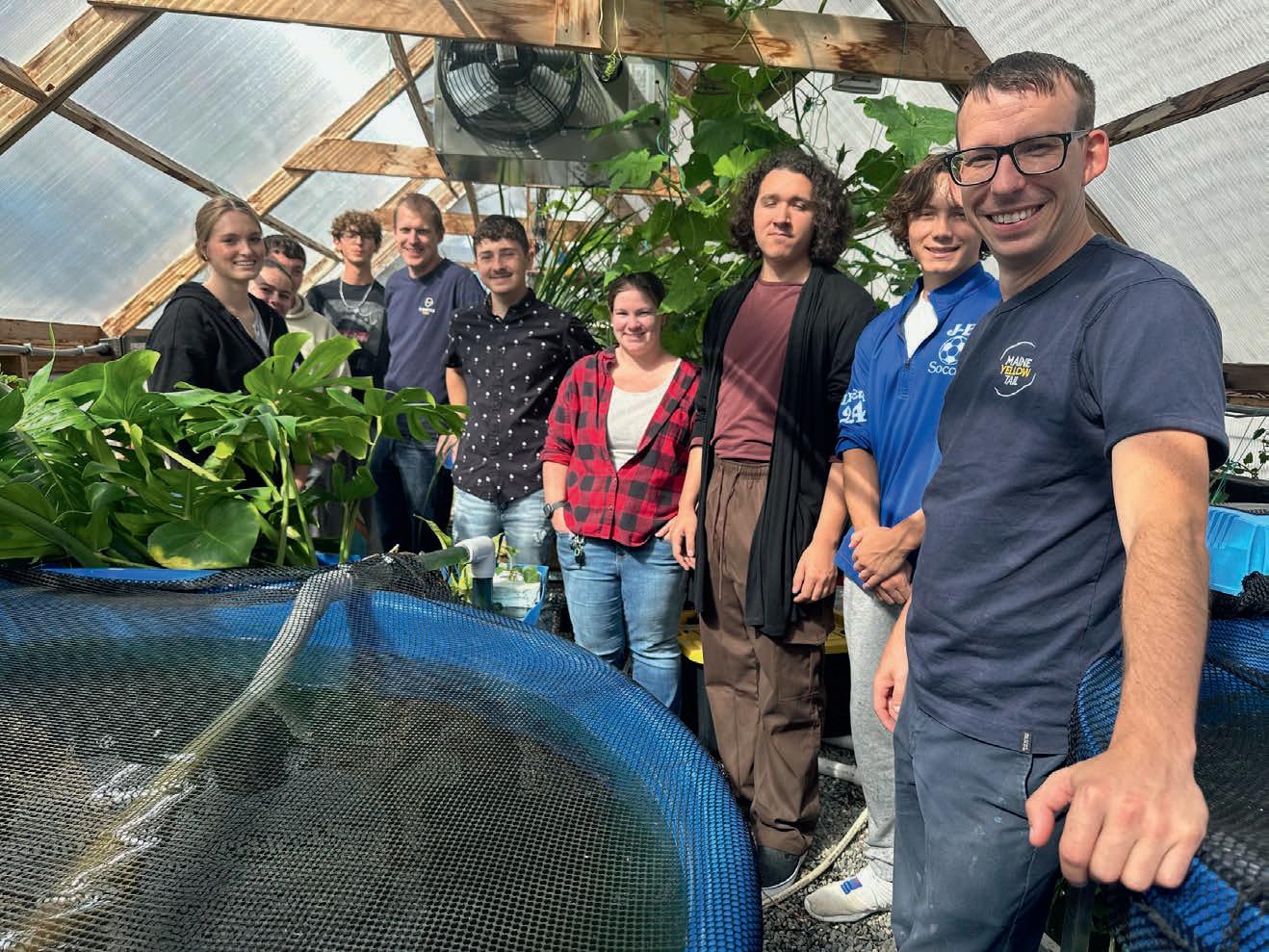
Recirculating aquaculture systems (RAS), pioneered in Denmark in the 1980s, make it possible to grow fish in tanks in a virtually closed circuit.
In an RAS system, water is recycled. Uneaten feed and waste, such as suspended solids, ammonia and carbon dioxide, are filtered out. The sludge, containing valuable nutrient salts, can be used in a circular economy as high-quality fertiliser or an energy source. The clean water is then sterilised and oxygenated before returning to the fish tanks.
RAS’ advantages also include the ability to keep external conditions such as water temperature stable, which results in steady growth. Fish can be grown in a controlled and traceable environment, without the use of hormones or antibiotics.


Greater control of the environment allows salmonids to be reared for longer in freshwater tanks, until they reach the smolt and post-smolt stage, or even grow out all the way from hatchlings to full-size.
Typically in salmon farming, juveniles are raised in freshwater hatcheries and lochs from eggs until the smolt stage. Smolts are usually moved to seawater sites at about 130g, where they are grown for 18 to 24 months before harvest.
An increasingly adopted alternative is to retain post-smolt salmon in land-based farms and move them to sea when they are larger and more robust at a size of up to 1kg. This reduces the on-growing time at sea sites to 12 months.
The post-smolt approach is increasingly being adopted by the big salmon farmers to reduce mortalities in sea cages. The larger fish are better able to survive the rigours of the sea, such as parasites and pathogens – but the approach requires investment in facilities capable of housing these larger fish on land.
Land-based aquaculture continues to attract investment but success for the sector has been mixed so far, reports Sandy Neil
Because land-based farms are not restricted to coastlines, they can be located almost anywhere, closer to cities, restaurants and shops within lucrative markets such as the US, continental Europe, China or Japan.
Not only does this translate into fresher fish, but it also cuts greenhouse gas emissions from airfreight. When 80% of salmon consumed in the US, the world’s largest salmon market, is imported, the carbon footprint is a heavy tread. RAS also eliminates the use of boats for feeding and harvesting, further reducing the use of fossil fuels.
With so many benefits to land-based fish farming, innovative newcomers started to capitalise on the opportunities. Millions are being invested in projects around the globe – but the jury is still out whether this technology will be profitable.

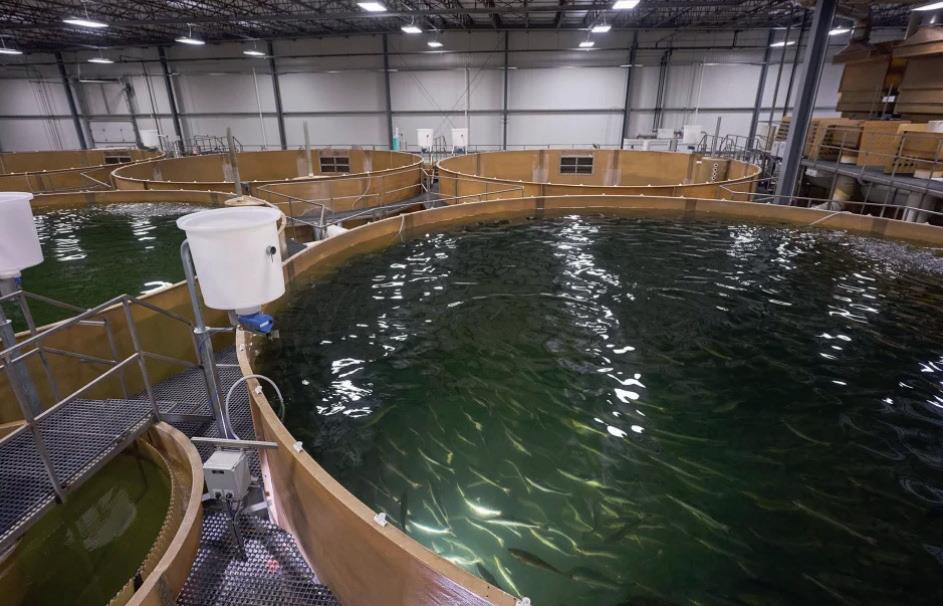
While recirculating systems are often highlighted as a green industry, it is energy intensive: water must be pumped, tempered and cleaned on a large scale. Last year, as the Russo-Ukrainian War raged on, sky-high electricity prices in Norway, the UK and the EU placed clear limits on the eagerness to finance land-based facilities. The boom was slowing down and for some projects, grinding to a halt. “Grow out” producers, in particular, had a rocky ride over the summer.
US-based AquaBounty Technologies, the first company to produce genetically modified (GM) salmon at commercial scale, combines the DNA of Atlantic salmon with other salmonid species to achieve faster growth.
They are grown in two RAS farms in Albany, Indiana and Prince Edward Island, Canada. AquaBounty is building a third, its first largescale commercial farm, at Pioneer, Ohio, planned for a production capacity of 10,000 tonnes.
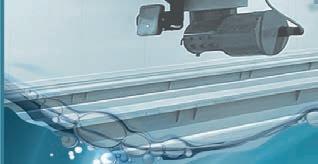
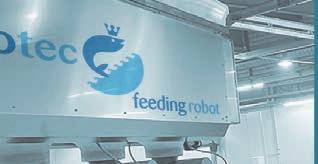

Ground was broken at Pioneer in April but by June, work was paused due to cost inflation. AquaBounty did not specify when the project would resume and left open whether it might go ahead at a smaller scale.
In August, the company found second quarter revenue fall by more than 26% year on year, despite increasing its output. AquaBounty CEO Sylvia Wulf said: “Our second quarter results were impacted by a significant decline in market prices for Atlantic salmon, despite the fact
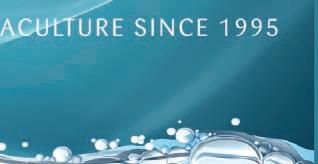

that our Indiana farm had its highest quarterly output to date. The demand for our fish continues to exceed our supply.”
Meanwhile on the Nordland island of Lille Indre Rosøya in Rødøy, Gigante Salmon is building one of Norway’s most advanced RAS facilities.
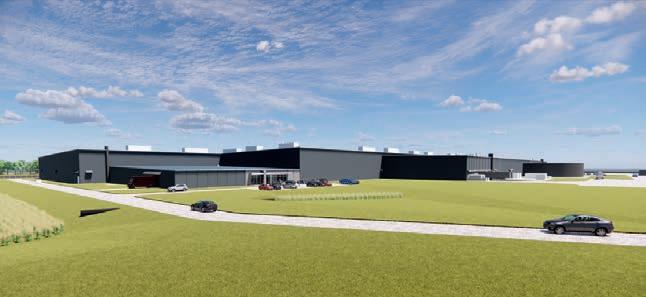
“Our production cycle is planned to take 24 months,” the company explains. “The smolt is deposited in the five longitudinal current vessels in pool number one and grows there for approximately 11 months.
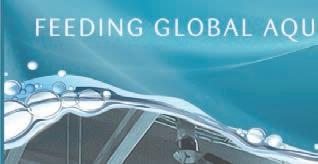
“The biomass is then split in two and distributed to the longitudinal flow vessels in basins two and three. The first salmon ready for slaughter is expected to be ready 14 months after the start of production.”
In September, Gigante Salmon announced the Rødøy plant would cost NOK 200m (£15m) more than planned.
“The cost increase is caused by general price increases, in particular within electric power,” it stated.



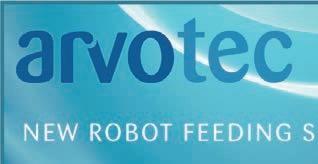


The first smolt release, Gigante added, is expected to take place in Q4 this year, later

Our Florida location could supply nearly half the current US salmon diet
This page from top: ingfish eeland facility ingfish yello tail s imming in tank And ord Salmon site at alnes

Opposite from top: ordic A ua Partners facility Pro imar nursery, yama Stolt Sea Farm site

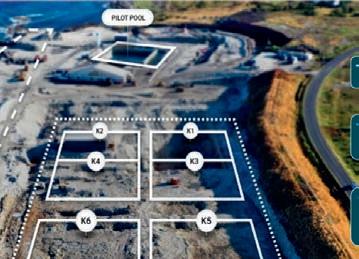
than the previously announced September to October release. CEO Helge EW Albertsen said: “This will lead to production starting with a larger smolt and will not change the progress plan, with the first fish ready for slaughter at the end of 2024. No change in production volume is expected.”
Summer’s a bummer for Atlantic Sapphire, “the largest global landbased aquaculture company”, which has a land-based ‘Bluehouses’ at Homestead, Dade County, Florida. The US plant completed its first commercial harvest in 2020 and is undergoing phase two expansion. The company’s original plant at Hvide Sande, Denmark, was destroyed by fire in 2021.

“A greenhouse gives plants an ideal space to thrive – our Bluehouses do the same for fish,” Atlantic Sapphire explains. “Raising fish on land at scale at just our Florida location could supply nearly half the current US salmon diet. By 2031, Atlantic Sapphire plans to grow 220,000 annual tonnes of salmon on land that once grew around 10,000 annual tons of tomatoes.”
However, the Sunshine State’s recent heatwave cut salmon growth, forcing the company to install more chillers.
“Lower than expected biomass gain in Q3 2023 to date, primarily due to elevated farming temperatures and its consequences for overall water quality, has resulted in a lower standing biomass than earlier estimated,” it stated. “More water chillers will be installed to ensure sufficient capacity at peak demand for cooling and the company expects the temperature issue to be solved in Q3 2023.”
Problems proved insurmountable for Salmo Terra, a Norwegian company founded in 2017 with permission to produce 8,000 tonnes of salmon and trout at Øygarden Business Park in Øygarden, an island municipality in Vestland. It spent the last six years seeking finance, seemingly without success.
Last spring, Øygarden Business Park took Salmo Terra to Hordaland District Court over non-payment of NOK 4 million in rent. The court granted the landowner’s request that Salmo Terra’s farming permit should be compulsorily sold and the business park owner bought it. Salmo Terra has since filed for bankruptcy.
In 2021, Fish Farmer reported that Salmo Terra had signed a multimillion krone deal with the Danish aquaculture supplier Graintec to build the facility. It was reported from Denmark more recently that Graintec had stopped trading due to Salmo Terra’s collapse, leading to the loss of around 30 staff jobs.

There are, however, more hopeful signs for grow-outs, notably in the form of yellowtail producer The Kingfish Company.

“Europe and the US are currently dependent on Japan and Australia to supply the market with yellowtail,” it explains. “Yellowtail is known for its delicate taste and is served in the world’s leading restaurants. The species grows to 2.5kg within 12 months and is an ideal fish for RAS technology.”

The Kingfish Company currently produces 1,500 tonnes of yellowtail at its RAS farm in Zeeland in the Netherlands. Once its US facility in Jonesport, Maine, is fully operational, Kingfish Maine is projected to produce 8,500 metric tonnes. In April, it celebrated its first harvest in Maine, even though the full-scale RAS facility has yet to be built.
A legal bid to stop the Maine farm by the Roque Island Gardner Homestead Corporation and Eastern Maine Conservation Initiative failed at the appeal stage in August. The Kingfish Company’s half-year results showed a 31% increase in revenue along with higher production. It said the demand continues to surpass supply.
Success also met Andfjord Salmon on the island of Andøya in the Arctic archipelago of Vesterålen, Norway.
Unlike many other land-based farmers, it has not chosen above-ground tanks. Instead, it has blasted into the bedrock to a point below sea level. Inlet water for its flow-through system is not pumped in the traditional sense but is pushed in from the sea outside. The pool where the fish go is also not circular but square and uses laminar flow, where the water enters through portals in one end wall and exits at the opposite end.
square and uses laminar flow, where the water
Andfjord Salmon is developing three sites on Andøya at Kvalnes, Breivik and Fiskenes. Its long-term ambition is to produce a volume of 90,000 tonnes from all three sites. It completed its inaugural harvest of Atlantic salmon in July.

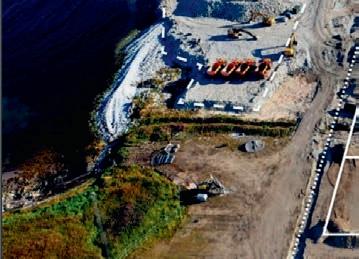
on Andøya at Kvalnes, Breivik and Fiskenes. Its 90,000 tonnes from all three sites. It completed
“Our first production cycle was a success from a biological, technical and commercial point of view,” says CEO Martin Rasmussen. “The achieved survival rate is industry leading and feedback from customers is positive, with emphasis on good colour and yield.
with emphasis on good colour and yield.
“In summary, we are exactly where we want to be. We have built up trust in our flow-through technology and biological performance, and the next construction phase is on track.”
flow-through technology and biological
Our first production cycle was a success from a biological, technical and commercial point of view
Optimistic investors are building in Asia. “China is by far the largest consumer and producer of seafood in the world, and China will account for 51% of global consumption growth over the next eight years,” says Nordic Aqua Partners, a Norwegian landbased salmon farming company. “The Central Government has therefore implemented a strategy to become more self-sufficient.



“Nordic Aqua Partners will provide the Chinese market with live, high-quality Atlantic salmon farmed in a sustainable and state-ofthe-art RAS facility on the Gaotang island in Xiangshan County of Ningbo municipality, providing excellent logistics to Greater Shanghai and the rest of China.
“Phase I will achieve an annual capacity of 8,000 tonnes by 2026, with a defined plan and approval granted to reach a capacity of 20,000 tonnes on current land area by 2027 (Phase II). For Phase III, the company has an option to expand on current location to reach a total capacity of 50,000 tonnes.”
In August, Nordic Aqua Partners announced its project was on schedule and within budget. The report said biological performance was very good for all batches and average weight on fish from the first batch reached 900g. The first harvest is expected for Q1 2024.

Around 90% of the fresh salmon consumed in Japan is transported by air from Norway, says Proximar Seafood, which has initiated production in the country’s first fish farm for Atlantic salmon at the foot of Mount Fuji. The RAS farm in Oyama is two hours’ drive from the Japanese capital Tokyo.
The facility consists of two separate buildings: a hatchery and nursery where fish are raised from egg to about 100g, and a post-smolt grow-out site, where the fish is grown to harvest size of about 5kg.
Operational start-up was in October 2022 and first harvest is expected in 2024. At full capacity, the Oyama fish farm is targeted to produce about 5,300 metric tonnes (HOG) of salmon per year. Presenting its second quarter results, CEO Joachim Nielsen said: “We have completed the construction works of our 5,300 tonne
facility according to schedule. This marks an important milestone and we are now focusing our efforts on production and harvesting of the first Atlantic salmon at our facility in Q3 next year.”
In Morocco, a pioneering project is aiming to produce up to 30 million high-quality fry of sea bream, sea bass, meager and other species of interest to national aquaculture farms.
Mohamed Sadiki, Morocco’s Minister of Agriculture and Maritime Fisheries, inaugurated the construction work of the country’s first hatchery for marine fishing in the commune of Gueznaya.
Spanning an area of 2.28 hectares, the fish hatchery will reportedly be “a vital component” of Morocco’s aquaculture sector, with an investment of MAD 120m (US$ 12.3m) dedicated to ensuring a reliable supply of fry for the value chain. The state has granted a MAD 20m (US$ 2m) investment bonus for the acquisition of hatchery equipment.
Meanwhile Stolt Sea Farm, which operates land-based fish farms in Spain, Portugal, Iceland, France and Norway, received official approval from the Galician regional government to expand its flatfish hatchery in Cervo.


The upgraded facility – already the world’s largest flatfish hatchery – will have an annual capacity of six million turbot juveniles and 10 million sole juveniles. This will significantly increase its overall annual production capacity of sustainably farmed seafood to 8,500 tonnes of turbot and more than 3,000 tonnes of sole.

President of Stolt Sea Farm Jordi Trias said: “This is a very important landmark for us. This exciting project demonstrates the confidence we have in the strength of our business and is crucial to our strategic growth plan, which includes reaching our annual production target of 23,000 tonnes of turbot and sole by 2035.”
Construction is expected to start in October 2023 with the new facility operational by mid-2025.
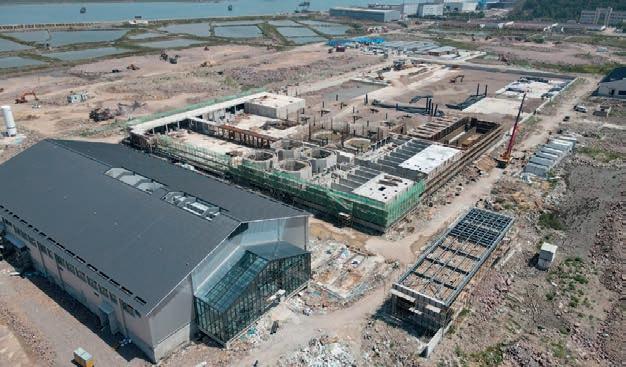
Over in Canada, work resumed on Grieg Seafood’s planned post-smolt facility on the Atlantic coast. Grieg, which pulled out of Scotland two years ago, operates in both British Columbia on the west coast and Labrador and Newfoundland on the east coast. Grieg Seafood Newfoundland has an on-land RAS facility consisting of a hatchery, a nursery and a smolt unit in Marystown, as well as five marine farms in Placentia Bay.
Grieg is resuming the first phase of construction of its post-smolt building in the Marystown Industrial Park. Completing the project is expected to cost CAN $14m (£8m).
The timing of the second phase of construction depends partly on what happens in British Columbia, where the federal government plans to end open-pen salmon farming and force companies into land-based aquaculture.
Grieg Seafood Newfoundland’s Managing Director Knut Skeidsvoll said: “Post-smolt is one of the industry best practices we are implementing into our Newfoundland operations from the getgo. This investment will contribute to our local communities with the employment of 120 people at peak.”
The blue bioeconomy is an essential factor in our sustainable future, but we are still just scratching the surface of what is possible in the aquatic domain.
It is widely recognised that to achieve a fully circular aquaculture and blue bioeconomy, we need to both valorise waste and sidestreams, and incorporate novel ingredients. But there is an urgent need for policy reform to enable this green transition. With the development of integrated value webs that use interconnected rather than linear processes, the economy will be circular, sustainable and secure, with more regional jobs. But with more complex value chains, the regulatory landscape also becomes more complex.
Public policies can create niches to assist the emergence and spread of radical innovation, but they can also limit the uptake of innovation. To enable investments in the blue bioeconomy and de-risk business opportunities, there must be consistency and predictability in regulation between and within European countries.
In its 2022 report, the European Environmental Agency states that the existing EU policy mix in the food sector has gaps and inconsistencies that limit the potential to achieve transformative change. In the EU-27 countries, 85% of blue economy investors were based in Europe (source: BlueInvest investor report, An Ocean of Opportunities), indicating that policy reform in Europe will be impactful. And even though only 16% of total investment deals in the blue economy were in aquaculture and fisheries, there is large potential for growth.
With the development of the EU taxonomy for sustainable activities – the classification system that defines criteria for economic activities that are aligned with a net zero trajectory by 2050 and broader environmental goals – there is a growing pressure for industry to make their processes circular and
sustainable. To enable the Green Deal, circularity must be financially and environmentally sustainable but most of all, it must be legal.
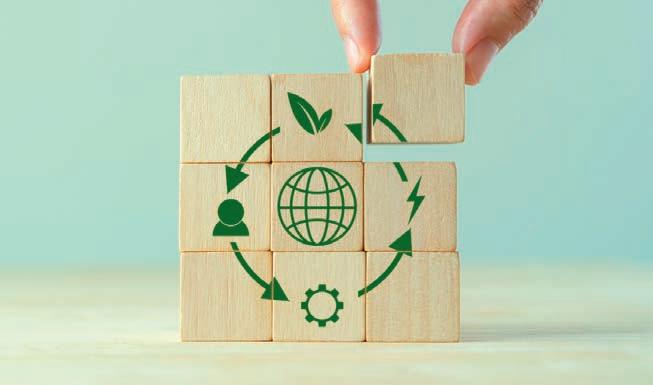
To valorise waste and sidestreams, and utilise novel ingredients, regulatory reform is needed. At this stage, a bouquet of regulations on anything from fertiliser to animal feed limit the potential of a truly circular economy.
The blue bioeconomy
Funded by EU Horizon 2020, ERA-Net Cofund Blue Bioeconomy (BlueBio) has, for the past five years, been working to identify new and improve existing ways of creating value from the blue bioeconomy.
The partnership consists of a range of ministries and funding agencies in Europe, and has issued calls to underpin the development of new and existing value chains through the funding of 49 projects for €43m (£37m). Many of these projects are showing promising results in creating high-value products from marine resources such as fish trimmings, algae extraction or rearing of species that we have no tradition for in Europe.
Three topics are of particular interest for aquaculture: algae, the valorisation of sidestreams and the use of sludge.
Micro algae and macro algae (seaweed etc) are aquatic. They have a wide range
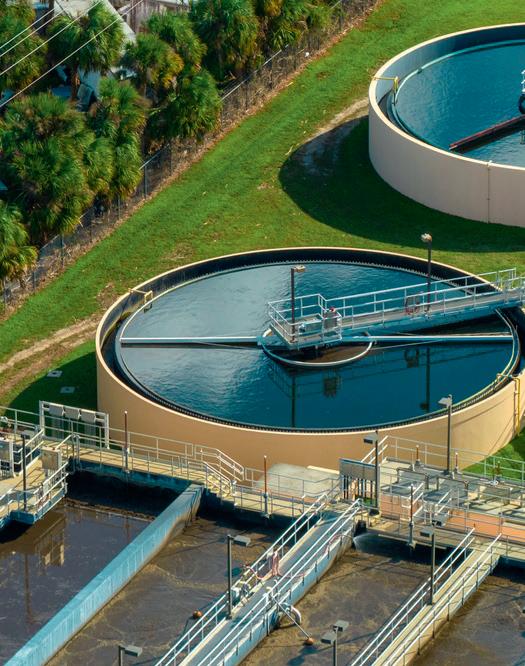
Circularity must be financially and environmentally sustainable but most of all it must be legal
of physical properties that have been shown to be a sustainable replacement for petroleum, concrete, soy and traditional textiles, as well as algae-based nutrients and supplements. The sheer efficiency of solar-to-chemical energy conversion in algal photosynthesis is two to five times that of traditional crops. Integrated multitrophic aquaculture (IMTA), with Saccharina japonica and scallop farming in China, reduced water pollutants and had 67% higher economic benefits than scallop monoculture.
In BlueBio, projects have among many things identified algal extracts for food fibres and anti-oxidant activities (MINERVA, Coordinator: Dagmar Stengel, National University of Ireland in Galway) and high-purity polysaccharide fractions that create bioplastic films and biopackaging (PlastiSea, Project Coordinator: Øystein Arlov, SINTEF AS).
A major barrier to algae aquaculture is that the regulations for algae are inconsistent within and across national borders. Regulations are the largest barrier to European algae production, especially the Novel Foods Regulation. In the EU, algae are “plants” with respect to trade tariffs but “aquaculture species” with respect to production.
As long as algal cultivation falls within the remit of aquaculture legislation, it will be

managed by the member states and not the EU. At EU level, guidelines are needed for member states to simplify the route for novel algae applications and mainstream the work that happens on a national level. The European Commission should identify 20 to 30 species of algae to put on an approved list, state the conditions to reach that status and the correct toxicological quality to start the mainstreaming.
Algae could also be used for carbon sequestration, but there is no global standard for measuring and certifying carbon sequestration in fisheries and oceans. Climate mitigation credits could boost investments, as has been seen in biofuels.
The financial assistance to farmers for animal production hinders the food system transition we need, creating a lock-in and distorting the market for novel foods and ingredients. Integration of microalgae production, with industries and systems producing nutrients as outflows (animal farming, food processing, sewage treatment etc) could make enormous contributions to circularity and carbon capture. It will create new business opportunities and jobs in local communities but algae need to be included in the EU Aquaculture Assistance Mechanism to create a level playing field.
As long as the route from innovation to market application is messy, confusing
and unintuitive, there will be no significant private investment and few new solutions will leave the pilot stage.
The challenges facing the European seaweed industry are not technologydriven but related to governance and market issues.

A lot of resources are today lost as waste, such as by-catch and sidestreams from fisheries, aquaculture and food processing. These resources can replace leather, plastic, coatings etc but they are currently expensive or illegal.
For industry to use such novel materials and ingredients, the biomass must be reliable and available, and there must be market acceptance. The definition of “waste” through the value chains must be optimised with circularity in mind. There must be a balance between potential health risk and sustainability. New protocols are needed to enable true circularity, from fisheries management and landing regulations to food processing regulations and food packaging.
Photobioreactors, marine biorefineries and marine enzymes all promise to help develop this sector. Biorefinery approaches, for example, can valorise rest raw materials (typically heads, viscera, trimmings, bones and cartilage, hide, tails and so on). Carbon or sustainability taxes, or inclusion in the EU taxonomy, would help businesses to invest in these processes.
Over the last five years, BlueBio has supported projects valorising aquaculture waste. AquaHeal3D (Project Coordinator: Karin Gilljam, Regenics) is working with unfertilised salmon roe as a wound-healing accelerant for complex wounds.
BlueCC (Project Coordinator: Runar Solstad, Nofima) is extracting collagen from species such as lumpfish for alternative uses and has reduced the extraction time from six hours to five minutes.
Caseawa (Project Coordinator: Giuseppe Falini, Università di Bologna) is extracting calcium carbonate from oyster shells, which is better than from standard production.
InEVal (Project Coordinator: Matthew Slater, Alfred Wegener Institute) is exploring using sea stars and other echinoderms in feed.
For a truly circular economy, waste must be allowed as an ingredient in new processes and products. Investment in

the valorisation of waste will only take place if, when a process is proven to be safe, there is an understanding that regulations will change.






Redefining sludge
Sludge, the semi-solid slurry output of a range of industrial processes including wastewater treatment and aquaculture, is the epitome of waste. The nutrient-rich resource, which is typically incinerated, can be used for anything from heating to fertiliser to growth substrate for novel feed resources. But to do this, the waste must be redefined so it can be used as inputs and the corresponding regulations must be adjusted. For instance, aquaculture sludge is not included in the EU regulation on fertiliser, as the European Food Safety Authority did not have enough data in 2015 to include it. Seven years on, the world looks different.
Since 2017, sludge from land-based aquaculture has had to be processed but with limited opportunity for use. There is a growing body of research on the safety of the processes. A mapping of available data on sludge to include it in regulation for fertiliser and for growth substrate for low-trophic feed ingredients (insects, gammarids, polychaetes) will be published in 2024.
There is an increased need for biomass management. With a change in regulation, this resource can be valorised and a circular business can bloom. In an Italian municipal sewage plant, they found that 8.5m (£7.3m) and 85 jobs can be created for every 100,000 tonnes of sewage sludge turned into fertiliser (Tassinari et al 2021). Similar opportunities can be expected in aquaculture.
An example of sludge reuse for an alternative feed resource is Andreas Hagemann’s project on the use of polychaetes, Sidestream. Sludge is an excellent substrate for low-trophic animals but 75% of the astaxanthin from production was lost when the product was cleared under current protocols for food safety and GMO, when using it as feed for production animals.
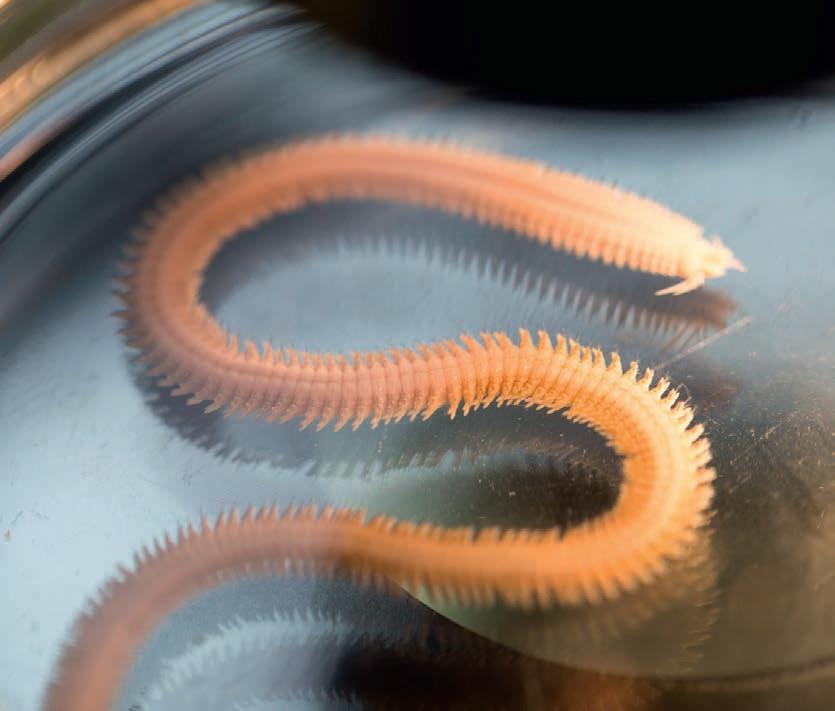
One of the biggest emitters of global CO2 is food production. There is an urgent need to improve our food system and futureproof it for environmental and security reasons. By diversifying
the feed and food sources, we will solve many of our biggest challenges in one go.
The findings from the 49 BlueBio projects show that aquatic resources have the potential to be part of a sustainable European future, if we do it right. However, we need both further research and innovation in these areas to ensure viable solutions, and regulatory reform to enable the adoption of the innovation.
In the blue bioeconomy, there are innumerable possibilities for innovation and development. These opportunities are not limited to technological innovation in, for example, fisheries and aquaculture or monitoring and observation, but extend to engaging with society (and in particular coastal communities) to implement sustainable value chains fully. There is no blue bioeconomy without a social licence. We need sustainable value chains that are quickly integrated in production systems, distribution channels and market segments that deliver products acceptable to consumers. This must be enabled by the policy landscape, accelerating and upscaling radical innovations and favourable taxation schemes for sustainable products. There is also a need to transform ocean governance. Policy needs and considerations must be better integrated into project design, implementation and solution finding and testing. Then the feedback loop for policy transformation will be clearer too. Policy coordination must go hand in hand with transforming/ reskilling the workforce.
Despite the challenges, the future of the blue bioeconomy is bright, with many opportunities for new value chains, both at local and global levels.
Though the Blue Bioeconomy Cofund collaboration will end in 2024, many of the funding partners will continue to be engaged in collaborative efforts, for example in the Sustainable Blue Economy Partnership and the EU Mission to “restore our ocean and waters by 2030”.
BlueBio is planning an event in the European Parliament in early 2024 on the need for regulatory reform to enable circularity and the blue bioeconomy. We will be touching on topics such as algae, sludge, waste and sidestream regulation from the blue bioeconomy. More details will be available in due course.
Ingeborg Korme is Coordinator of ERA-Net Cofund Blue Bioeconomy. Further information on BlueBio and the outputs of the ERA-Net can be found at bluebioeconomy.eu or by emailing bluebio@bluebio.eu
For a truly circular economy, waste must be allowed as an ingredient in new processes and products
Owatec offers efficient wastewater and sludge management for aquaculture


The new EU Taxonomy will regulate the import of goods and services within the EU area. For Norwegian seafood industries this will mean barriers to trade from the beginning of 2024.
Owatec Group’s innovative, environmentally conscious, and costefficient solution for this challenge will help the businesses to run as usual, and protect the environment, as contamination levels in industrial waters will be mitigated and managed to the required levels.
THREE-STEP-SERVICE
1 Validation
- Site Visit and Assessment
- Laboratory Scale Tests
- Tailored Solutions to Meet the Determined Objectives
- Estimated CAPEX and OPEX for Wastewater Treatment
2 Piloting
- Implementing and Testing at Full Scale
- Fine-Tuning for Maximum Efficiency
3 Delivery
- All-in-one Wastewater Treatment Solution
- Ensuring Compliance and Sustainability
- Wastewater Treatment as a Service or
- Investment Option
CLEANTECH with online platform guarantees
SAVINGS – Clear water, low wastewater costs.
LOW INFRA – Cleantech in sea containers.
RELIABILITY – In-house engineering.
OPTIMIZED PROCESSES – Realtime follow up and remote control.

Alumichem is proud to collaborate closely with the aquaculture industry, where wastewater treatment plays a pivotal role in ensuring both sustainability and success. The company’s experience in water treatment has illuminated the significance of harmonising chemistry and technology in this process.
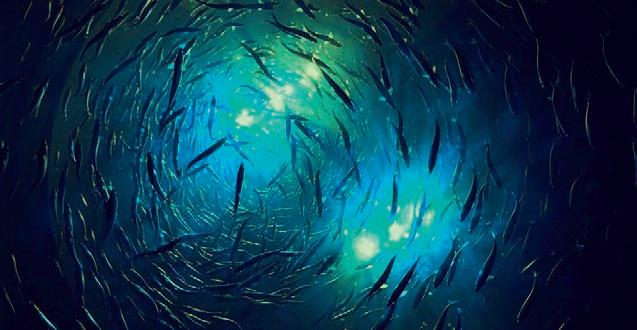
Recirculating aquaculture systems (RAS) offer exceptional potential for high-quality seafood production with minimal environmental impact. However, the substantial wastewater generated by these systems can pose risks if not managed effectively. By synergising chemistry and technology in wastewater treatment, users can overcome this challenge and unlock numerous advantages for their aquaculture business.
Read more at: https://alumichem.com/applications/aquaculturesludge-treatment/
Balmoral Tanks’ blutanQ® RAS tank technology was heavily featured on the company’s stand at the recent Aqua Nor exhibition in Trondheim, Norway.
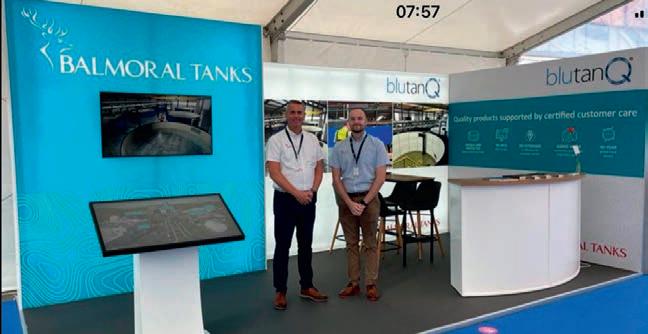
Jonathan Smith, Sales Director, said: “The show presented an excellent opportunity for us to demonstrate the many advantages of blutanQ. It seems as though the industry is delighted with the product as well as our accredited customer service credentials, and we have lots to follow up on after the exhibition.”
A leading UK tank design and manufacturer, Balmoral provides bespoke RAS solutions based on species, location and stage of production.
Pictured: Sales director, Jonathan Smith, (left) was delighted with the response to blutanQ at Aqua Nor 23 www.balmoraltanks.com
epco Pipe Systems is a specialist in supplying comprehensive pressure pipe systems for industrial and commercial applications from the company’s UK stockholding in Leeds. epco’s range of U-PVC and PE offers an ideal, cost-effective alternative for legacy materials such as steel.
epco now offers a full range of PE products in SDR11 and SDR17. The range includes metric PE100 Pipes ranging from 25mm-315mm, several butt fusion and electrofusion fittings, various accessories, tools and welding machines for purchase or rent. For further information call 0113 2491155 or visit www.epco-plastics.com

Scottish engineering company, Ocean Kinetics, has announced a significant strategic investment in Irish marine engineering company, MMG Ocean, which will lead to an expansion of facilities and jobs at MMG Ocean and a partnership that aims to drive innovation and growth in the marine engineering sector. Shetland-based Ocean Kinetics’ 25% investment in the Killybegs-based company follows the two businesses’ past collaboration on a number of successful projects, including an innovative clean energy storage system for the aquaculture sector and the construction of marine grade metal frames for deployment in offshore wind developments.
Pictured are (from left): Martin McGuiness, Managing Director of MMG Ocean and John Henderson, Managing Director of Ocean Kinetics.

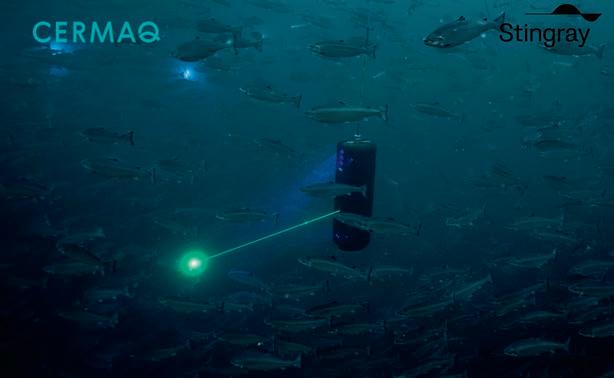
Cermaq Norway is deploying 140 lasers in its fight against salmon lice, the company has announced. It says laser technology has proven to be effective against salmon lice and gentle on the salmon. After extensive evaluation in two locations in Finnmark and at Nordland, the system will be put into use at other suitable facilities in those areas. Cermaq has signed a contract with the technology company Stingray Marine Solutions for the equipment.
Karl Fredrik Ottem, Head of Fish Health at Cermaq Norway, said: “Lice lasers have been shown to keep lice levels down. It means we avoid many mechanical de-licers and thus avoid stressing the fish so they can swim in peace.”

Innovasea has launched a new system to track fish in water using acoustic telemetry. NexTrak uses digital technology and advanced coding schemes to improve coverage, extend range and provide researchers with deeper, more accurate data.
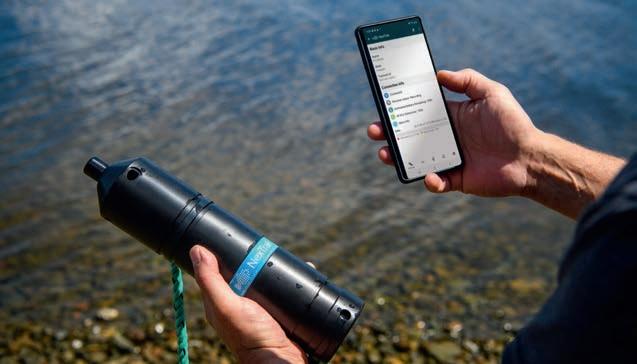
“Put simply, NexTrak is a giant leap forward because it does everything better than previous acoustic telemetry systems,” said Mark Jollymore, President of Innovasea. “Whether it’s generating more robust and accurate data sets or enabling the study of new habitats for the first time, NexTrak represents the future for aquatic animal researchers.”
Preliminary testing shows NexTrak receivers have a range 39% greater than the current VR2 receivers, which Innovasea says will lead to a vast increase in the number of valid detections in the field.
Hexagon Purus Maritime, a wholly owned subsidiary of Hexagon Purus, has been granted support from Innovation Norway to build a full-scale model of a maritime hydrogen fuel system, the first of its kind in Norway, in Langevågen, close to Ålesund. Innovation Norway supports companies in developing their competitive advantage and to enhance innovation. The demo model will showcase solutions available for zero emission shipping. The full-scale model will include a fuel system with four type 4 hydrogen cylinders, structure, fueling nozzle and a piping and control system. The demo model will be used for training with operators and engineering students in a safe environment.
Pictured: Robert Haugen, Managing Director, Hexagon Purus Maritime with Ingrid Fjørtoft Klokk, Project Engineer.
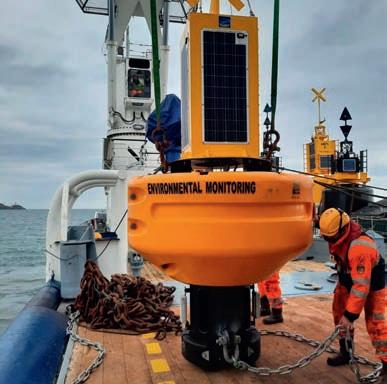
A multidisciplinary data buoy platform manufactured by Ocean Scientific International Ltd (OSIL) has been installed in Dublin Bay as part of the PREDICT multidisciplinary project. This project will provide coastal ocean observations that will be used to validate, calibrate and extract as much information as possible from satellite earth observation data with the aim of generating AI models that can be used to predict environmental change.The 1.9m OSIL Fulmar buoy is recording and transmitting a variety of environmental parameters including salinity, temperature, pH, partial pressure of CO2, turbidity, dissolved oxygen and chlorophyll.
The scheme has been funded by Science Foundation of Ireland, the Geological Survey of Ireland and the Marine Institute.
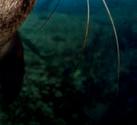
Our new generation, award-winning acoustic deterrents Comply with both Marine Scotland EPS and MMPA requirements

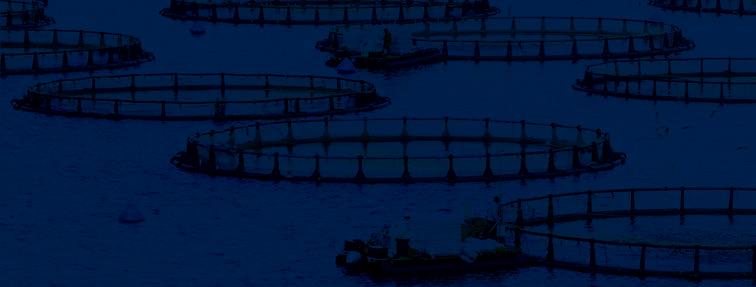
Our new generation, award-winning acoustic deterrents Comply with both Marine Scotland EPS and U.S. MMPA requirements

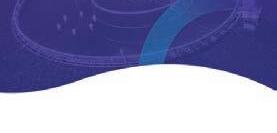


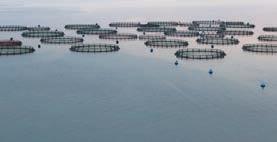



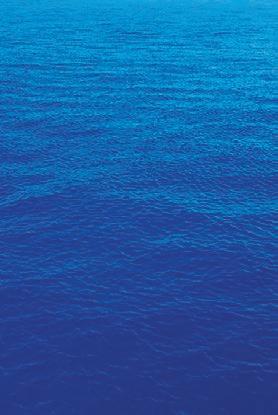
• Create conditioned avoidance so we can put far less acoustic output into the water than older barrier systems Have low duty cycles, low average volume and low frequency to help deter seals, while better safeguarding cetaceans


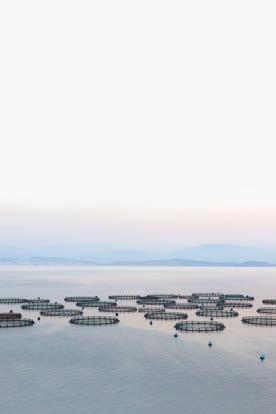
• Create conditioned avoidance so we can put far less acoustic output into the water than older barrier systems


Have low duty cycles, low average volume and low frequency to help deter seals, while better safeguarding cetaceans
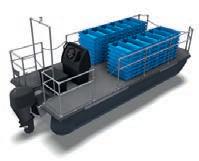



Your first choice for animal welfare.
Your first choice for animal welfare.
Your first choice for animal welfare. Get in touch to set up a trial: acedeterrents@aceaquatec.com

Get in touch to set up a trial: acedeterrents@aceaquatec.com
Get in touch to set up a trial: acedeterrents@aceaquatec.com









impex@impexagency.dk
























Your partner in Aquaculture Technology AKVA group is a unique supplier with the capability of offering both Sea and Land Based Aquaculture operations with complete technical solutions and local support.

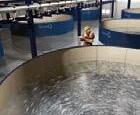

























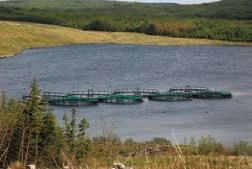






































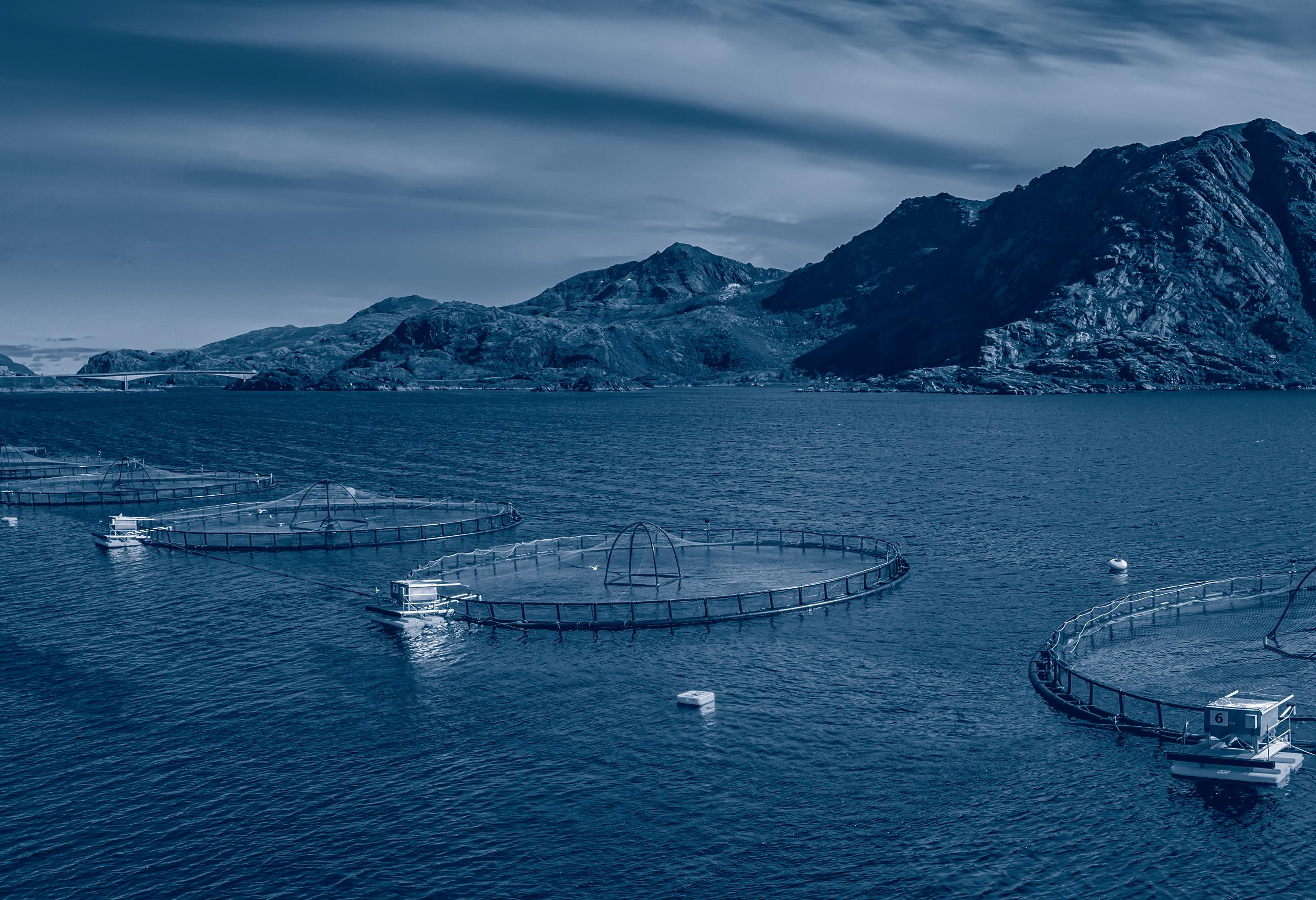


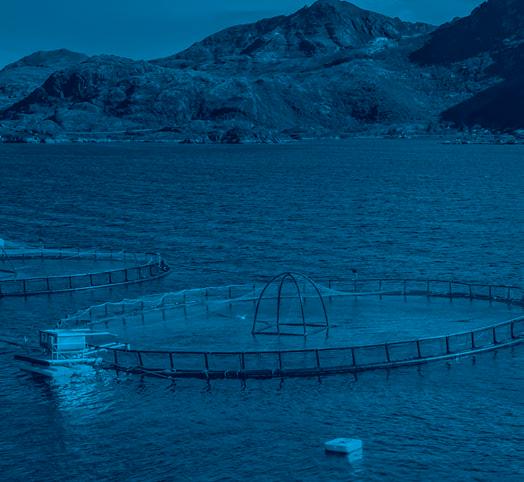


































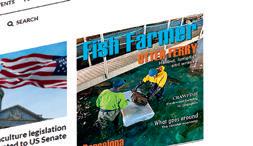
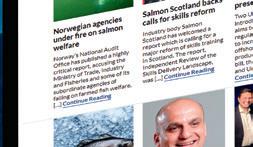


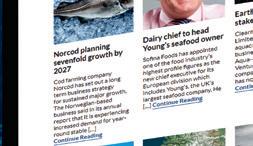

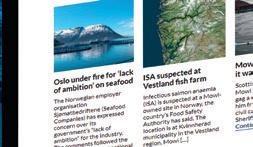
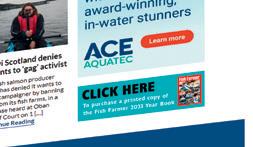


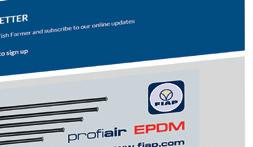

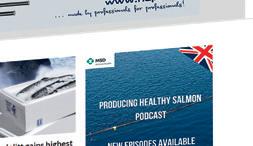


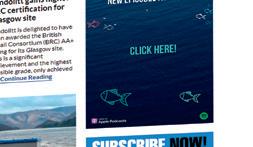
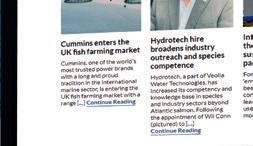
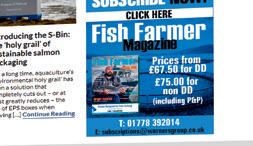
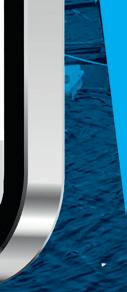

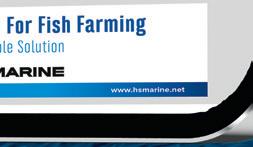






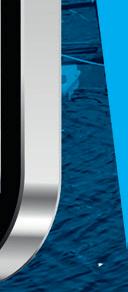
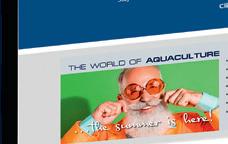











www.was.org/meeting/code/AFRAQ23
Lusaka, Zambia
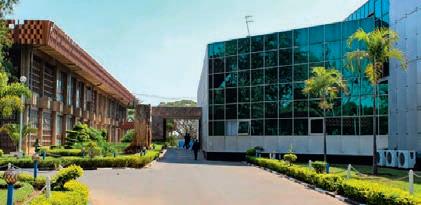
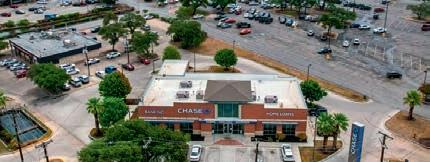
November 13-16, 2023
JUNE 24
www.seawork.com
Europe’s largest on-water commercial marine and workboat exhibition.

Southampton, United Kingdom
June 11-13, 2024
SEPTEMBER 24
LATIN AMERICAN & CARIBBEAN AQUACULTURE 2024
www.was.org
Medellin, Colombia

September 24-27, 2024
FEBRUARY 24
AQUAFARM 2024
www.aquafarmexpo.it
Pordenone, Italy
February 14-15, 2024
Focused on climate, research and innovation
www.was.org
San Antonio, Texas, USA
February 18-21, 2024
www.was.org
Surabaya, Indonesia
NEW DATES July 2-5, 2024
Aquaculture – Driving the Blue Economy is the theme of the conference at the Grand City next year.

MARCH 25
AQUACULTURE 2025
www.was.org
New Orleans, Louisiana USA
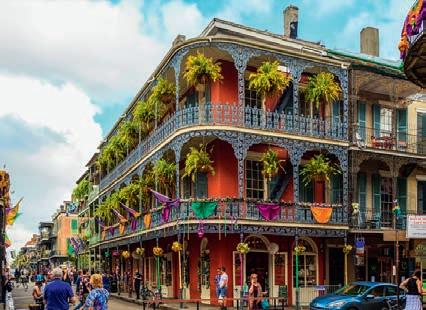
March 6-10, 2025
MAY 24
AUGUST 24
AQUA 2024
www.aquaeas.org - www.was.org
Copenhagen, Denmark
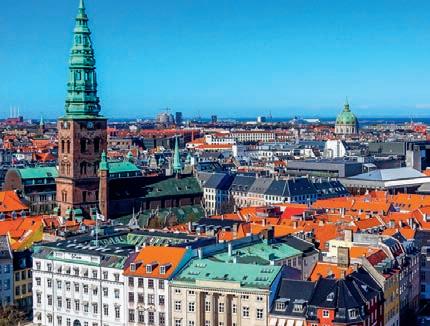
August 26-30, 2024
The theme of AQUA 2024 is BLUE FOOD, GREEN SOLUTIONS.
SEPTEMBER 25
AQUACULTURE EUROPE 2025
www.aquaeas.org
Valencia, Spain
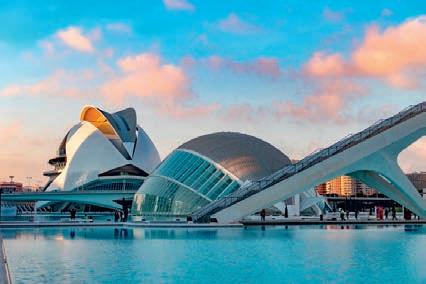
September 22-25 2025
www.aquacultureuk.com
Aviemore will once again be the venue for this biennial trade fair and conference. It is undoubtedly the most important aquaculture exhibition held in the British Isles. The show has a tremendous following and with increased investment for 2024 it promises to reach even further across the broader aquaculture markets in both the UK and Europe.

Aviemore, United Kingdom
May 14-15, 2024
Over the last decade, it has become clear that our country is developing a worse and worse climate for business.
Government is populated by people who simply don’t understand that industry employs most of the populace and pays most of the taxes, directly or indirectly. Much more worryingly, these people also do not understand the amount of effort and risk required to create an enterprise, raise investment or get through the particular hell of our planning system.
Every industry, particularly the food industry, faces its own brand of activist. When you add in the nimby fraternity, planning authority and civil service, the poor developer is left sucking a lemon. I am not trying to get anything through planning at the moment and am not intending to for some time, but know a good few people who are. Their view is that the expense and effort disincentivises most people from even starting the process and not just for salmon farming. We need to rethink our whole planning system.
For salmon farming, we have to add further opposition: the river owners and anglers. When Loch Duart was quite young, I discovered an organisation called Linking Environment and Farming (or LEAF). I thought it was a brilliant name and had all the right credentials, particularly as it mirrored what we were trying to do. Sustainability was at its core and ours.
I engaged their executive in discussions about joining, which came to nothing. After extensive enquiries, I came to know that its Chair was a landowner in Fife with many river-owning friends, who would not have approved. These people walk the corridors of power. It is not surprising that the Conservatives in Holyrood, despite being the party of business and farming, rail against salmon farming because their chums are river-owning proprietors looking for someone else to blame for their failing fisheries.
The problem is even more insidious than that. I shall use initials for the people I am about to mention, not because I fear reprisal as most people will know to whom I refer but because I refuse to give them oxygen.
A good number of activists, often arrogant ones, are up for a drink if you meet them at a function. In the case of DS, he succumbed to my offer and became very chatty. I mentioned that the wild lobby in this case a certain PF were pushing in various directions at the time. PF is the son of a rich river owner and extremely arrogant with it. I was utterly stunned to hear from DS, who presents himself as an unkempt new age hippy, that he had been to dinner with PF at his house two nights before and knew everything I was talking about.
As they say, “the enemy of my enemy is my friend”. We have lined up against us a bevy of people in the legal profession, politics and the civil service.
Most people would be hugely daunted by such an unholy alliance but salmon farmers know that they are talking to a much wider audience. Remember when BS campaigned outside supermarkets to try and stop consumers eating salmon? Or even funnier, when DS campaigned outside RSPCA headquarters in the www.fishfarmermagazine.com

pouring rain dressed as a seal. I have seen a photograph of it but could never get a copy. The public went on buying salmon in larger and larger numbers.
I had always hoped that, like Jon Gibb (Co-ordinator of the Salmon Scotland wild fisheries fund), the wild salmon lobby would start to see that we have to work together. In fact, I have always held the hope that all rural industries would start to work together as the political agenda becomes more and more urban driven.
It is becoming clear that, with the civil service working with such people and the political groups giving opposition more airtime than industry, we have to act. Firstly, we need to ensure we are seen as farmers just like any other. Secondly, we need to look to the long term and start to work at our image in schools and higher education. A number of you will remember the West Coast school teacher who told her class to work hard or they might become fish farmers. I was outraged at the time but now I see that we weren’t talking to the teachers, so they didn’t know any better. It’s time we did.
We need to ensure we are seen as farmers just like any other














